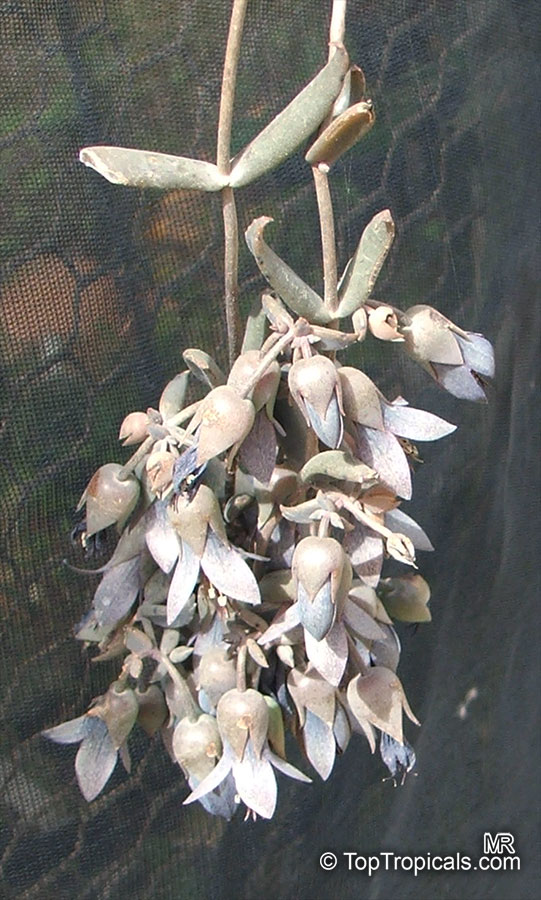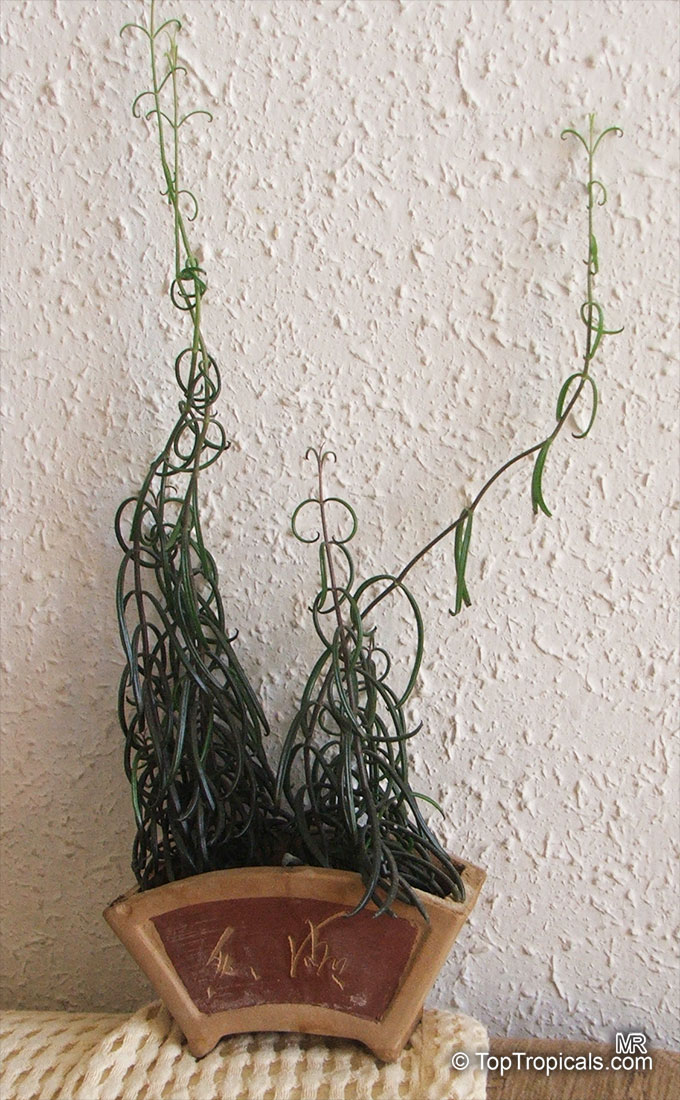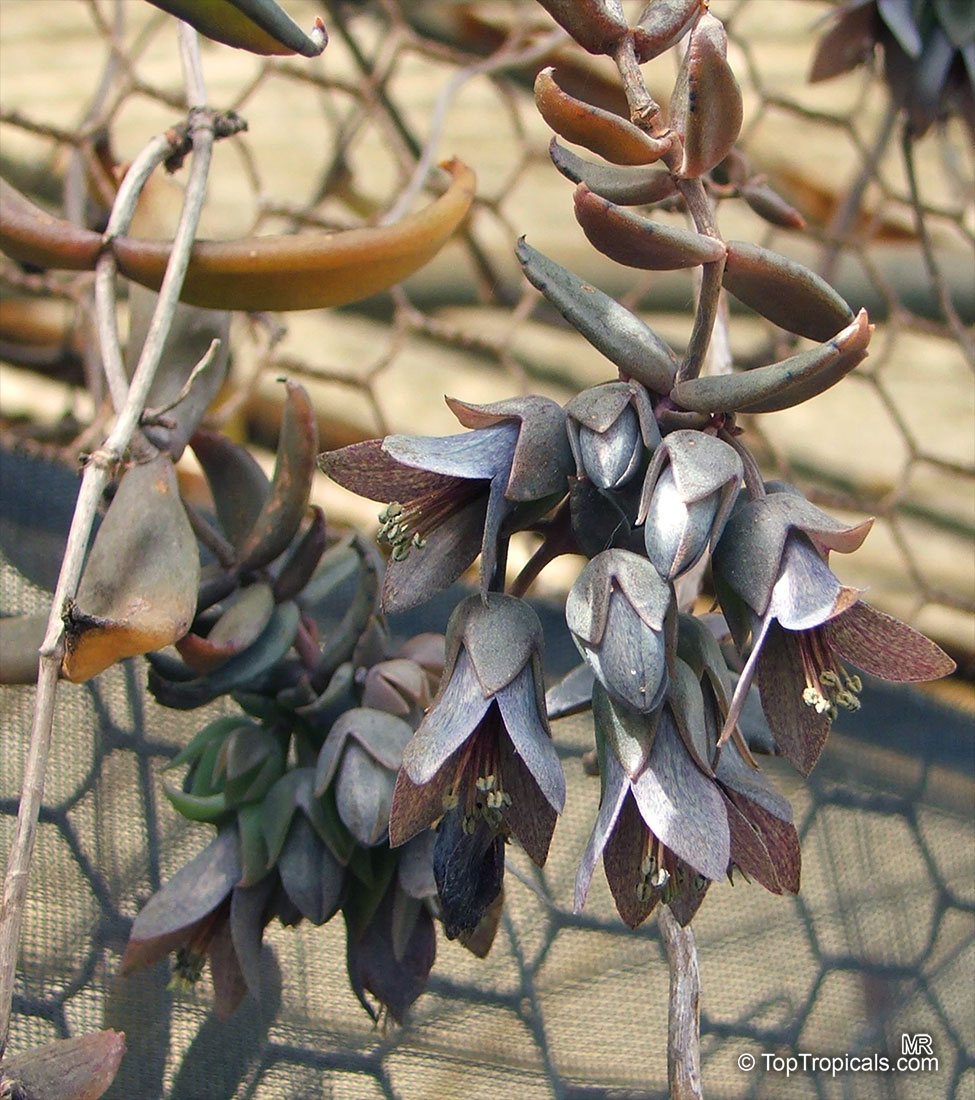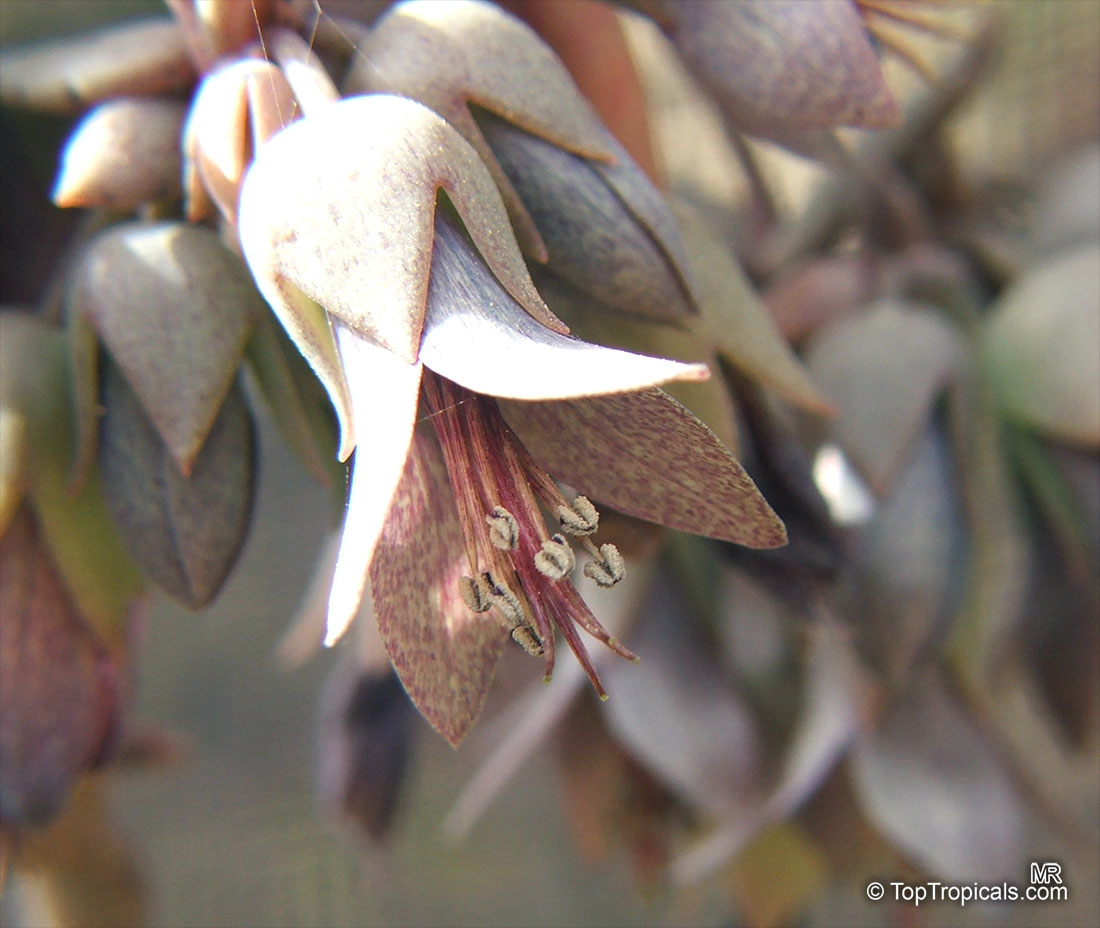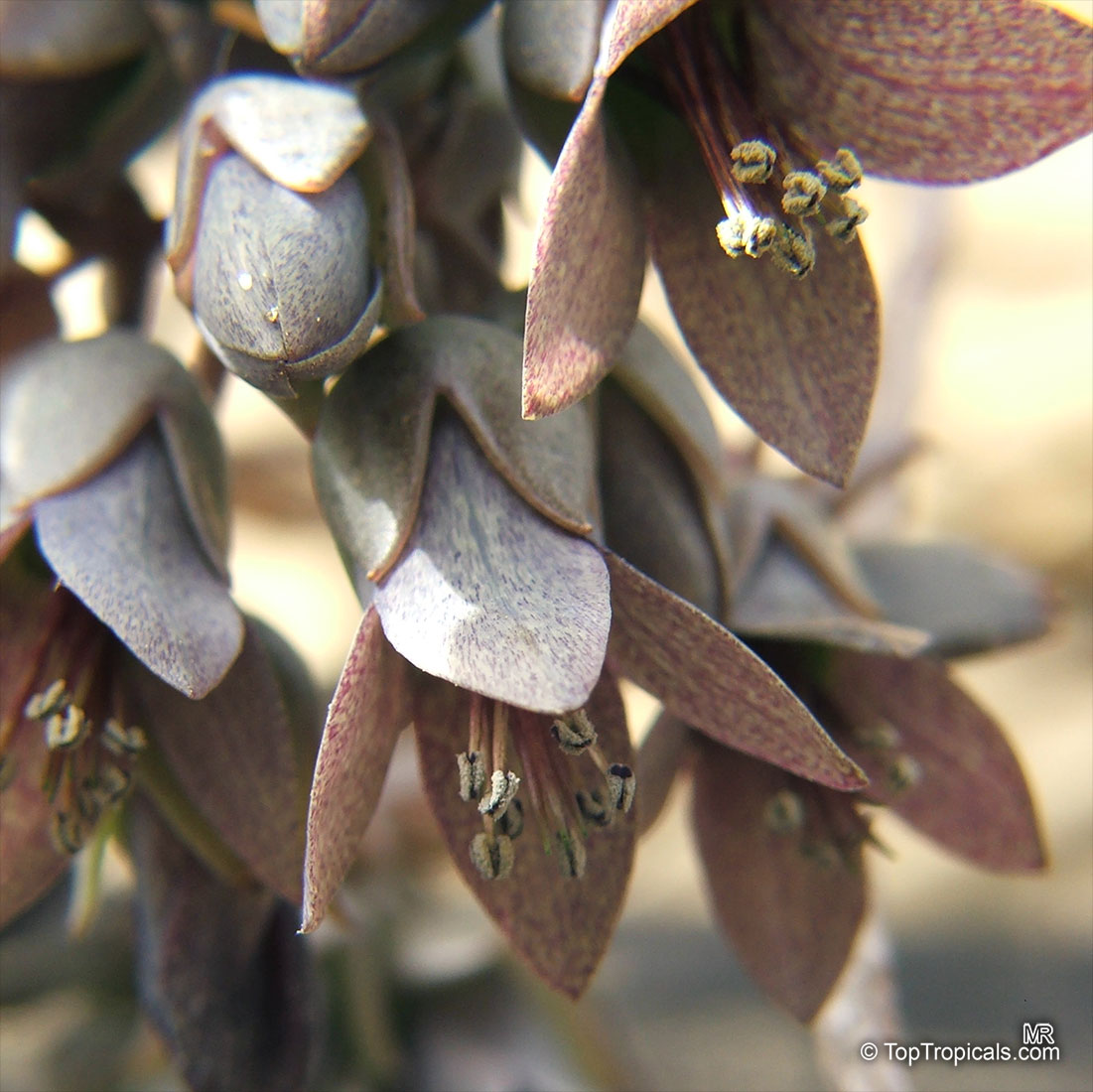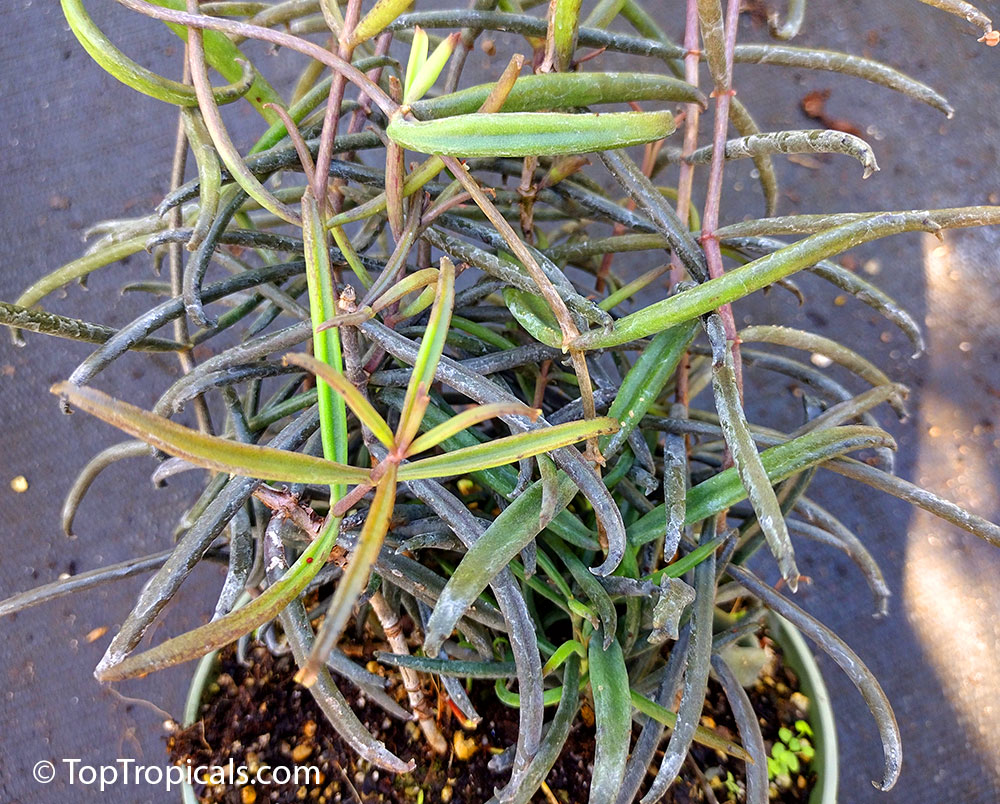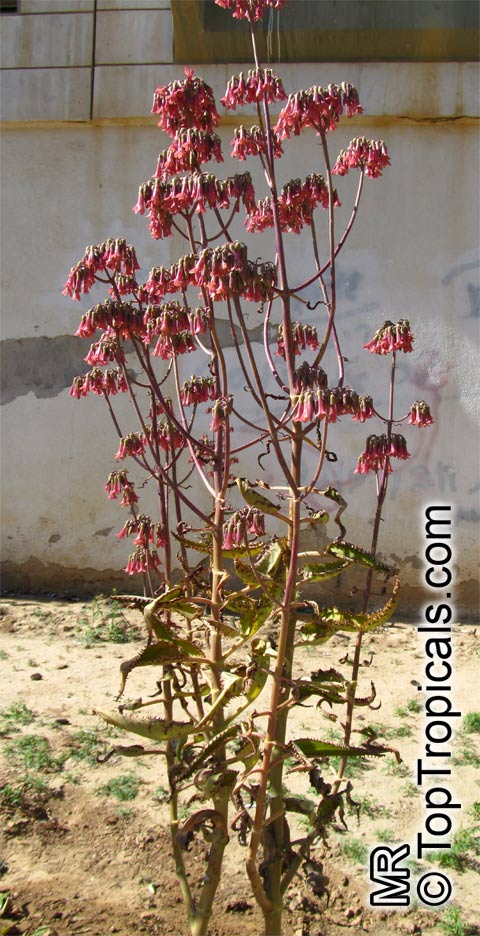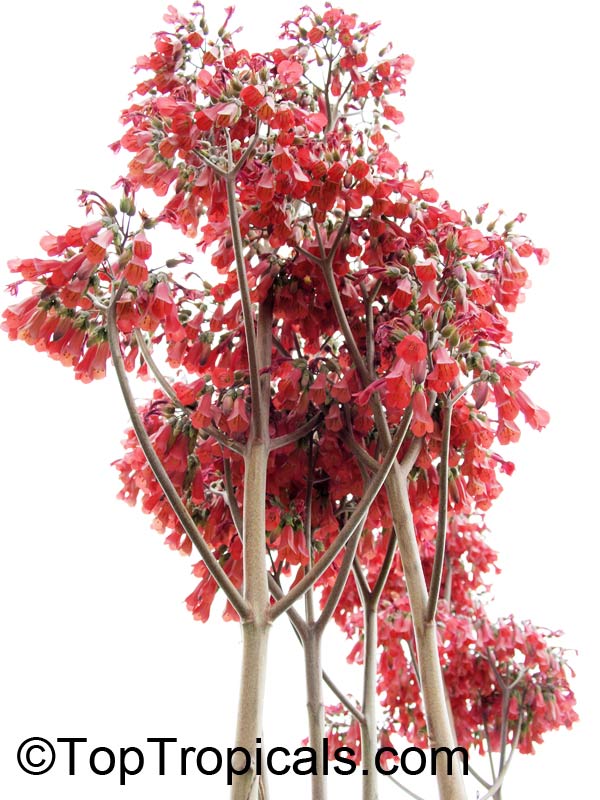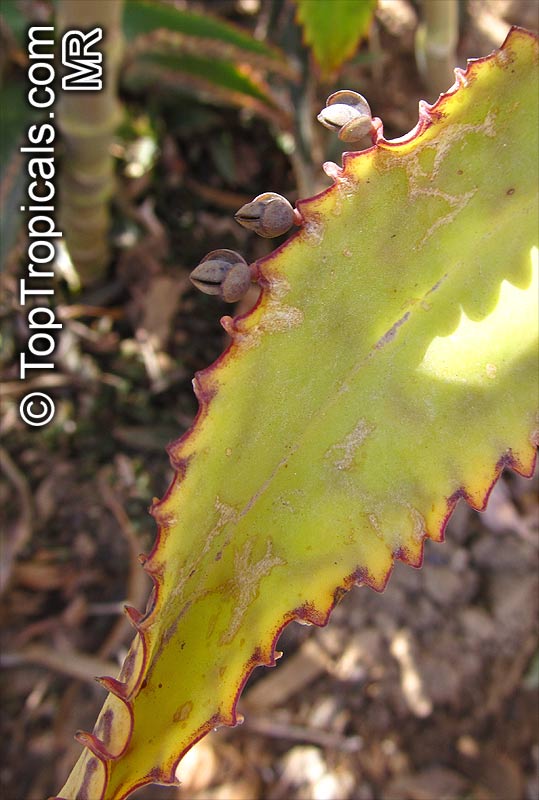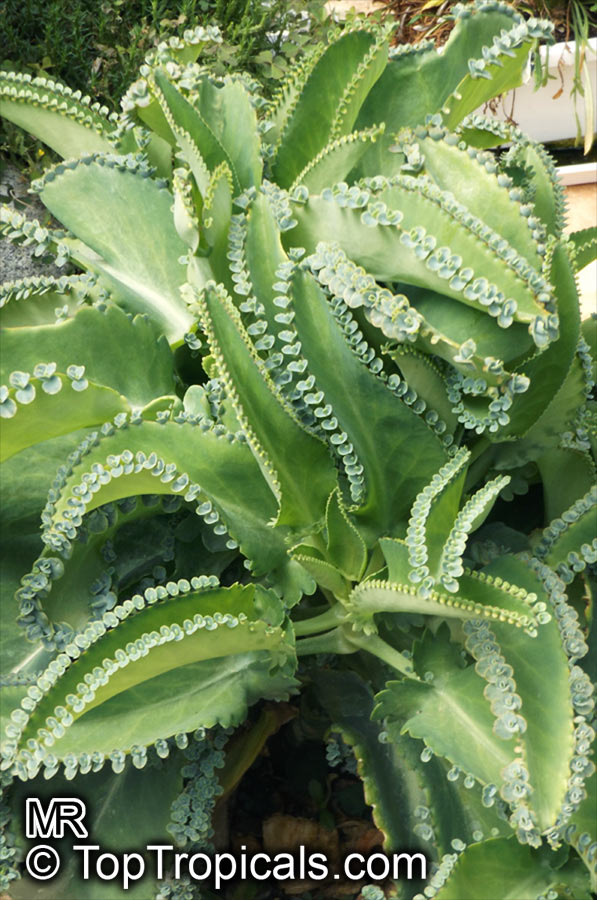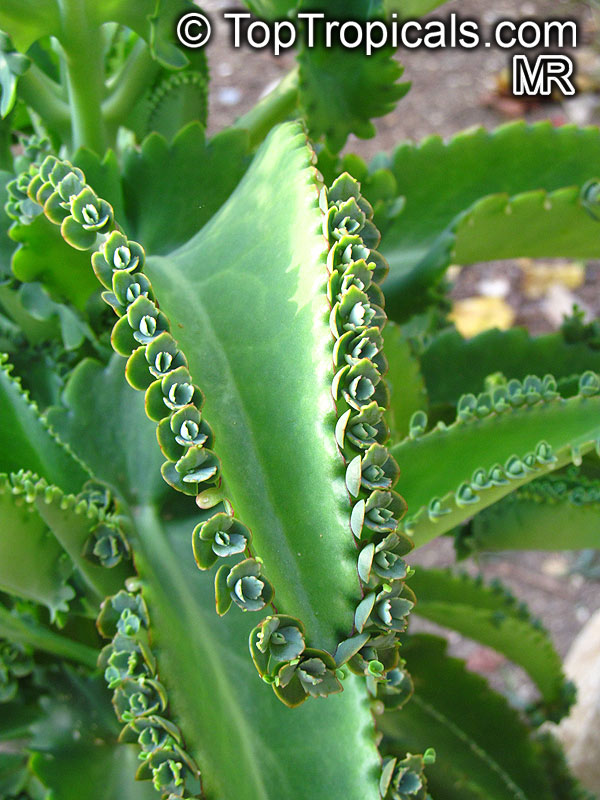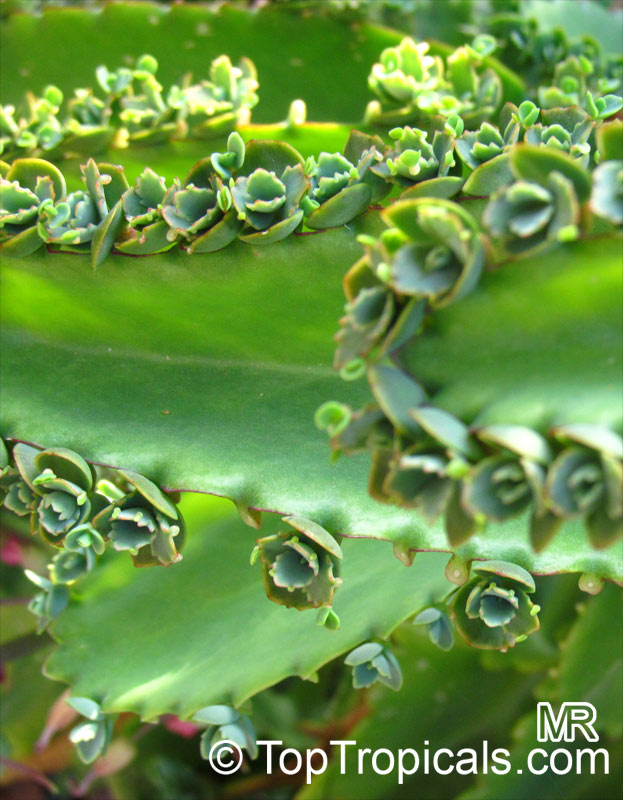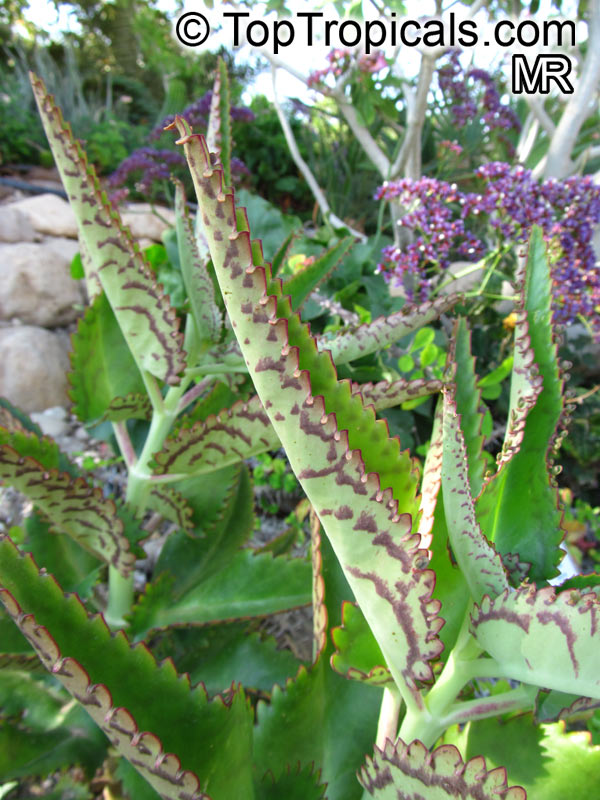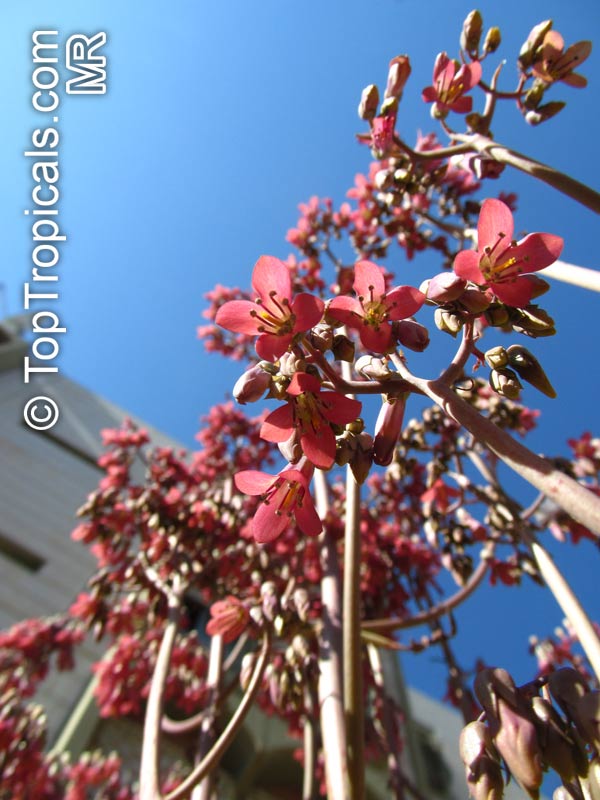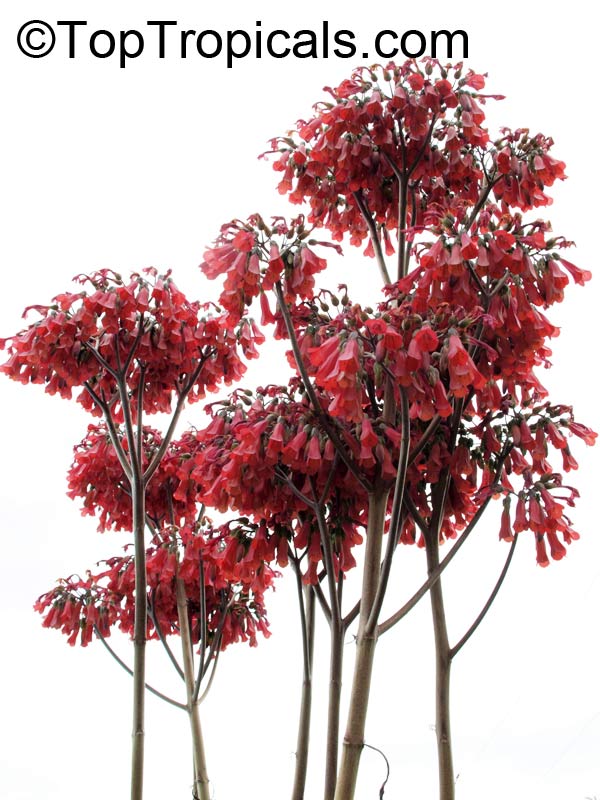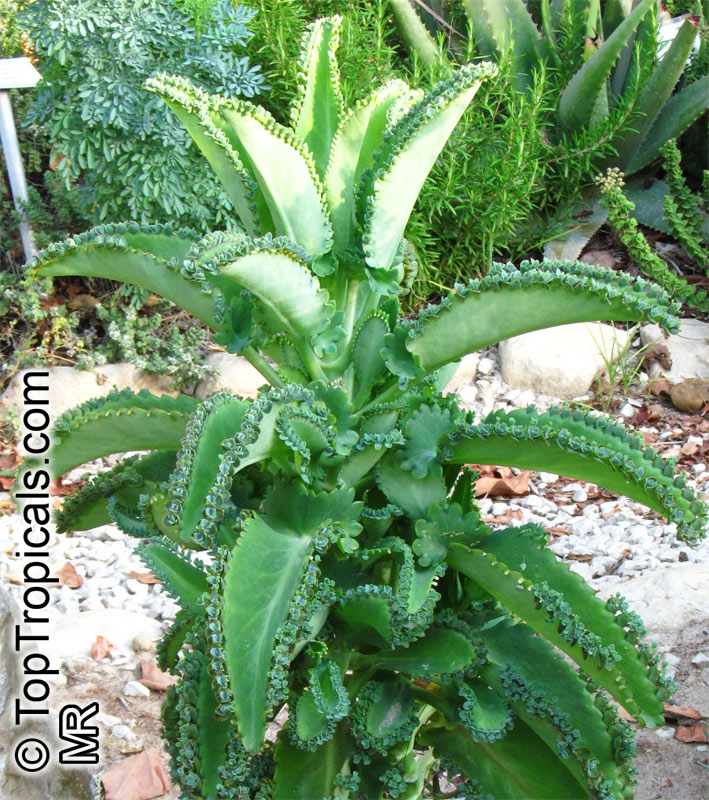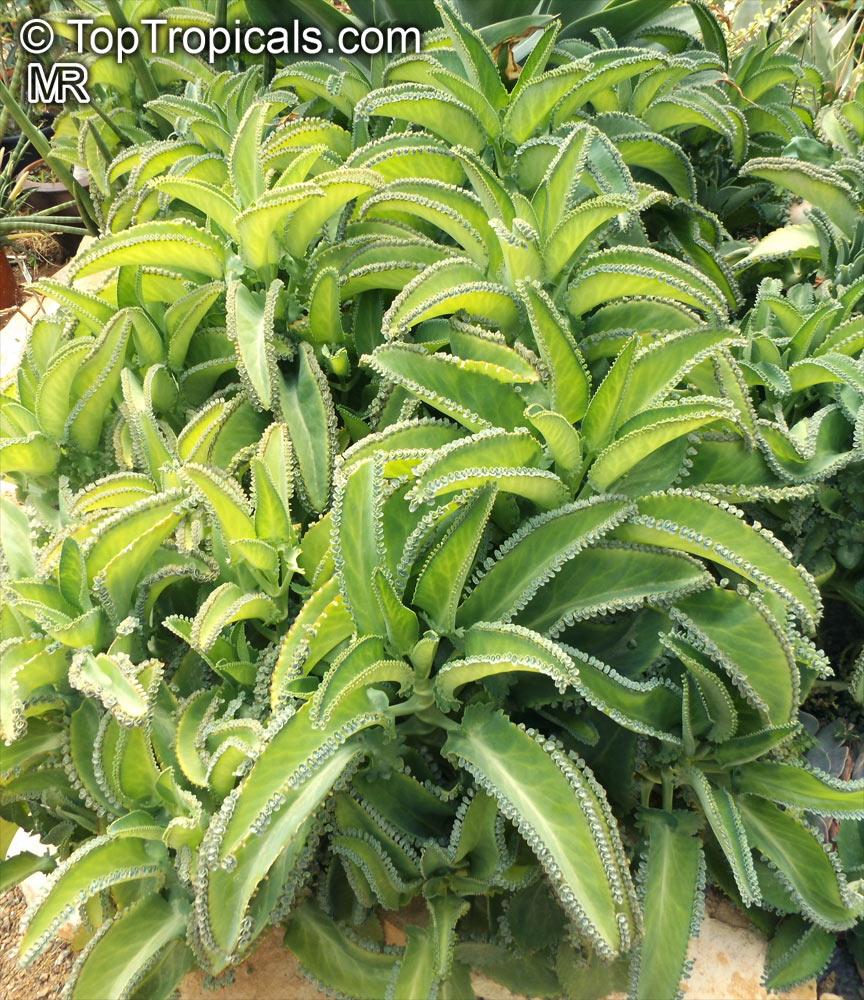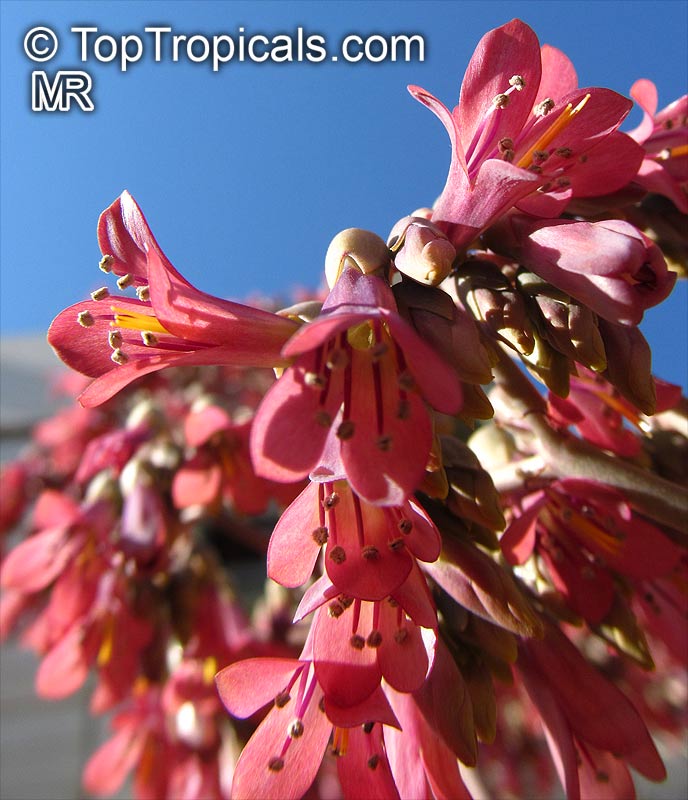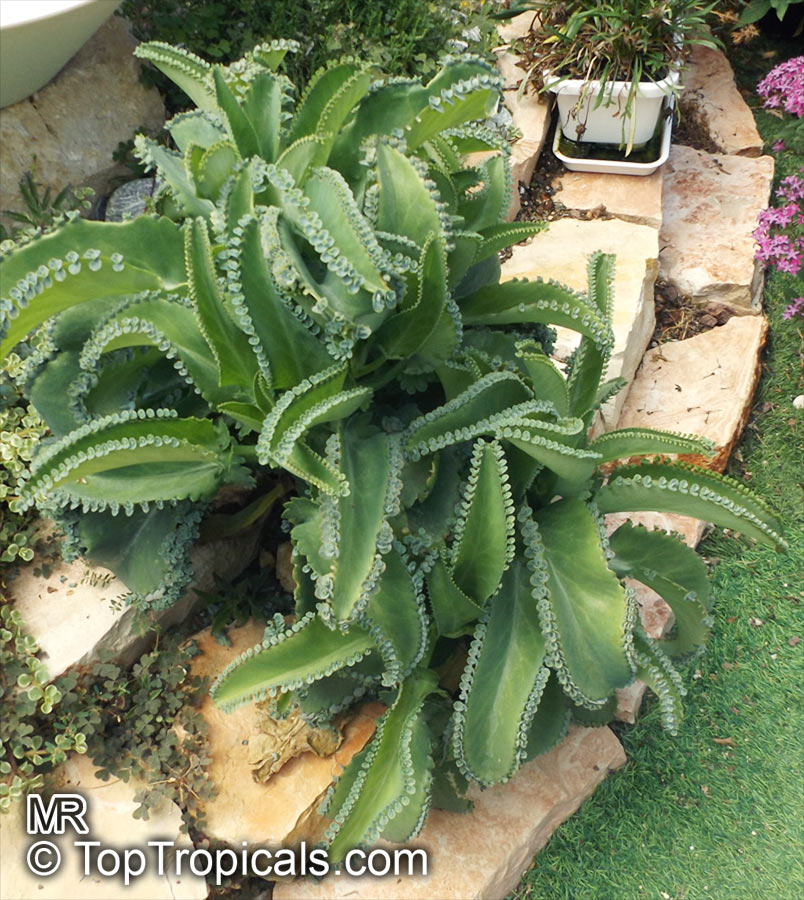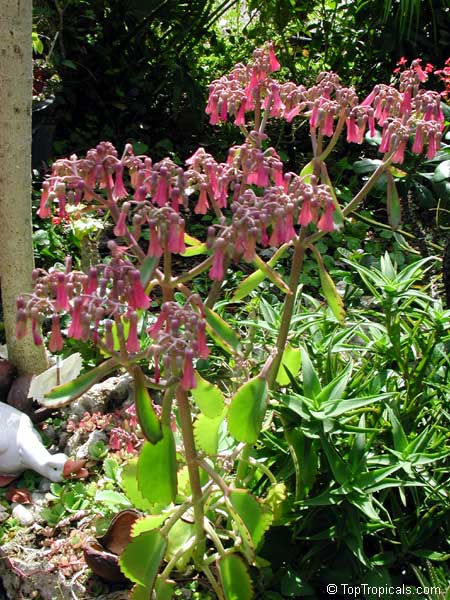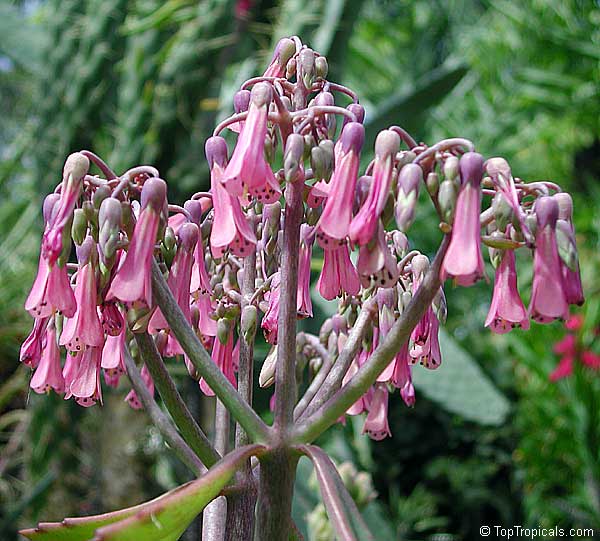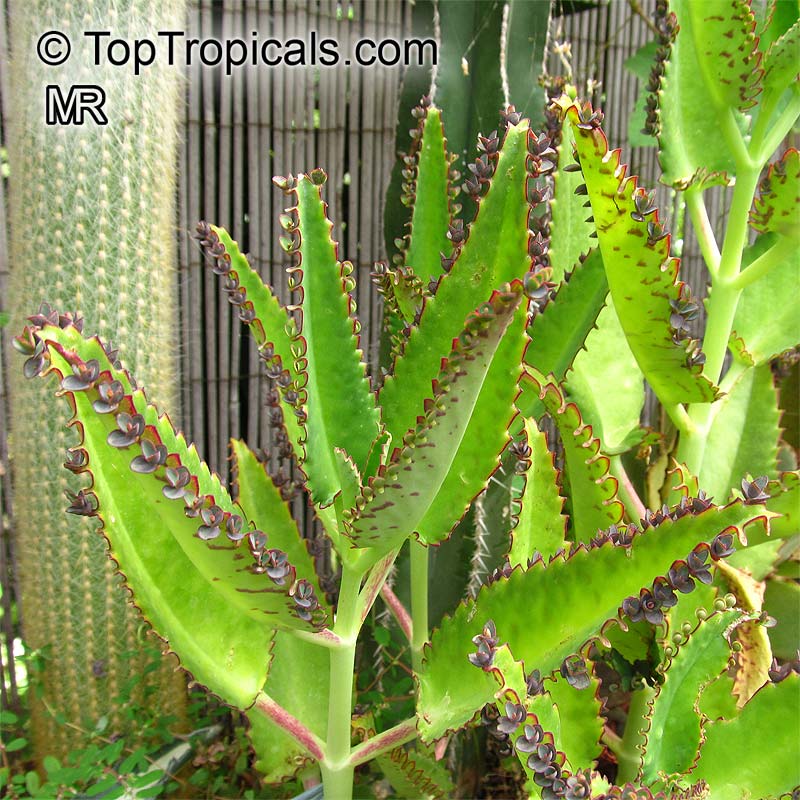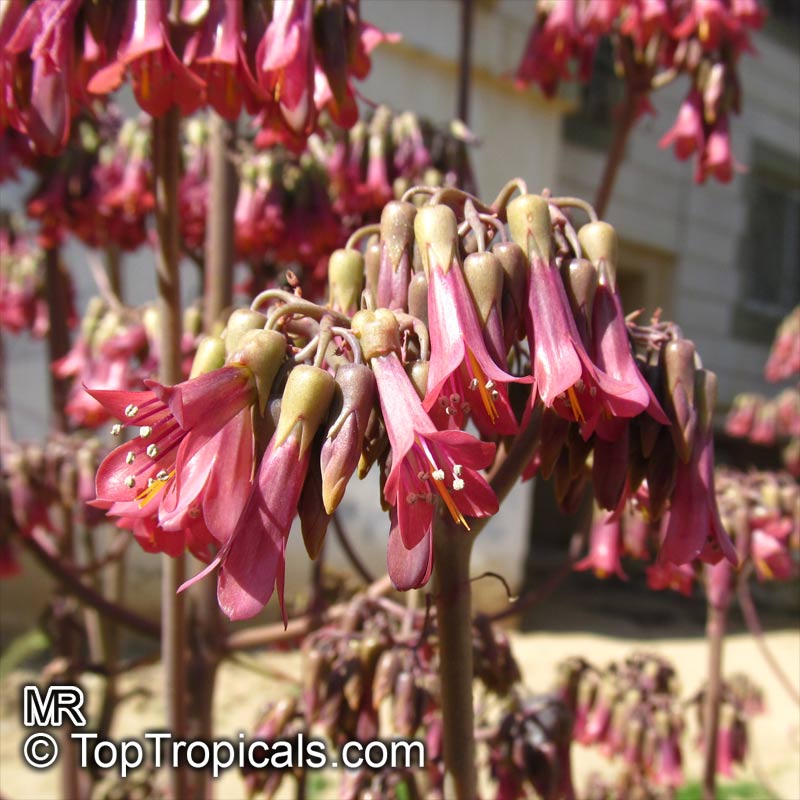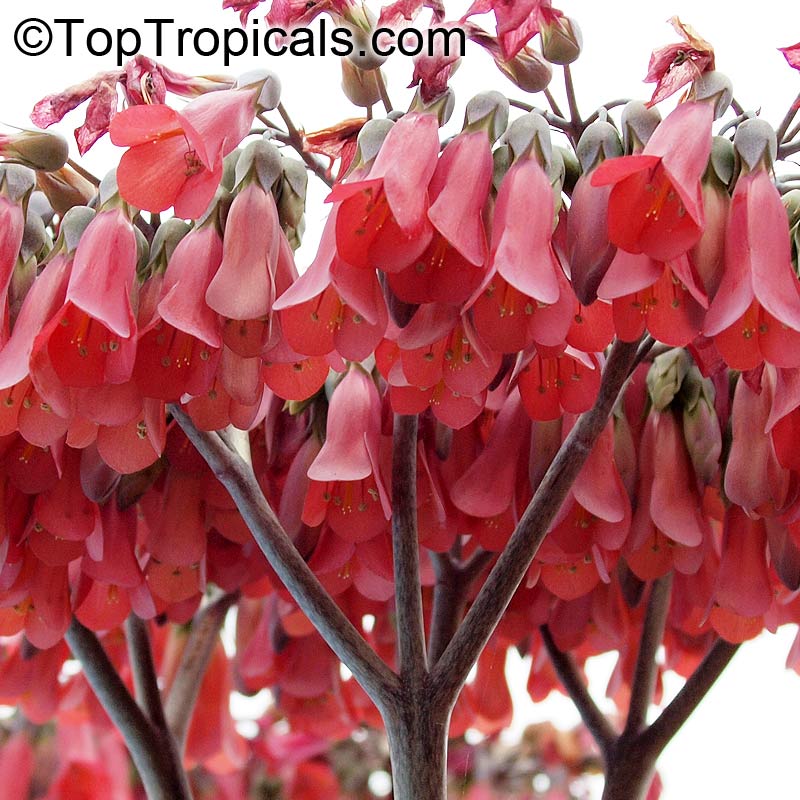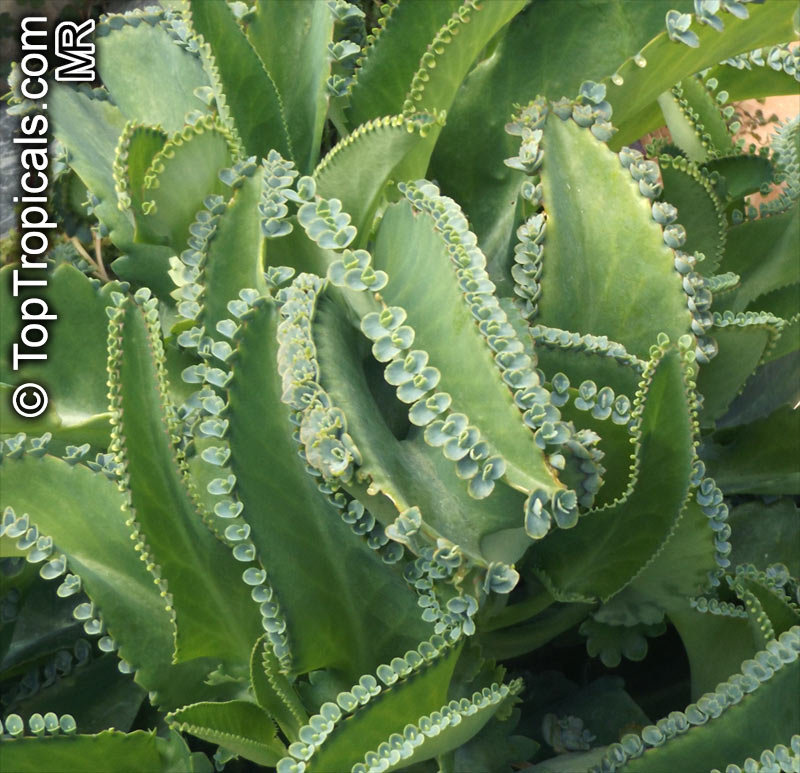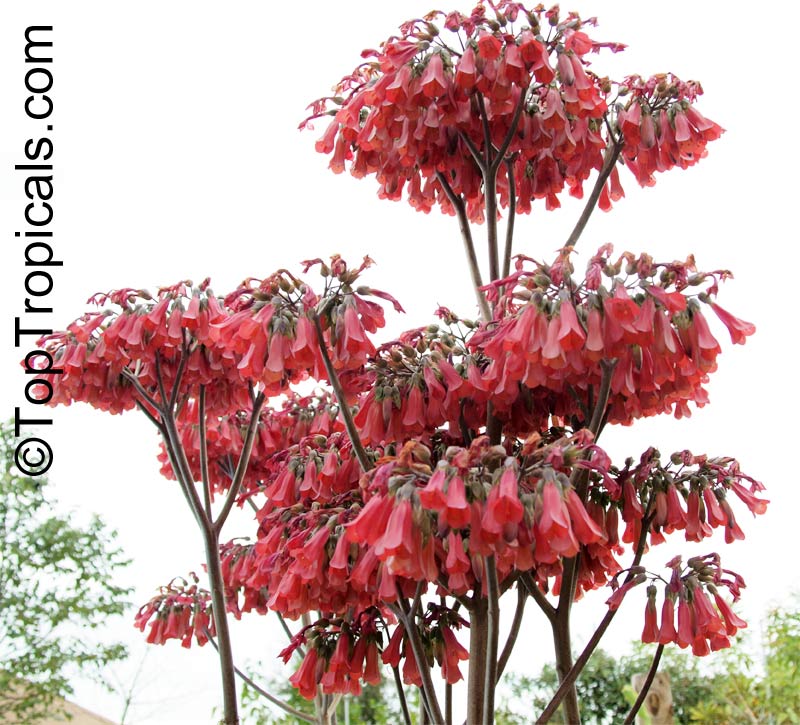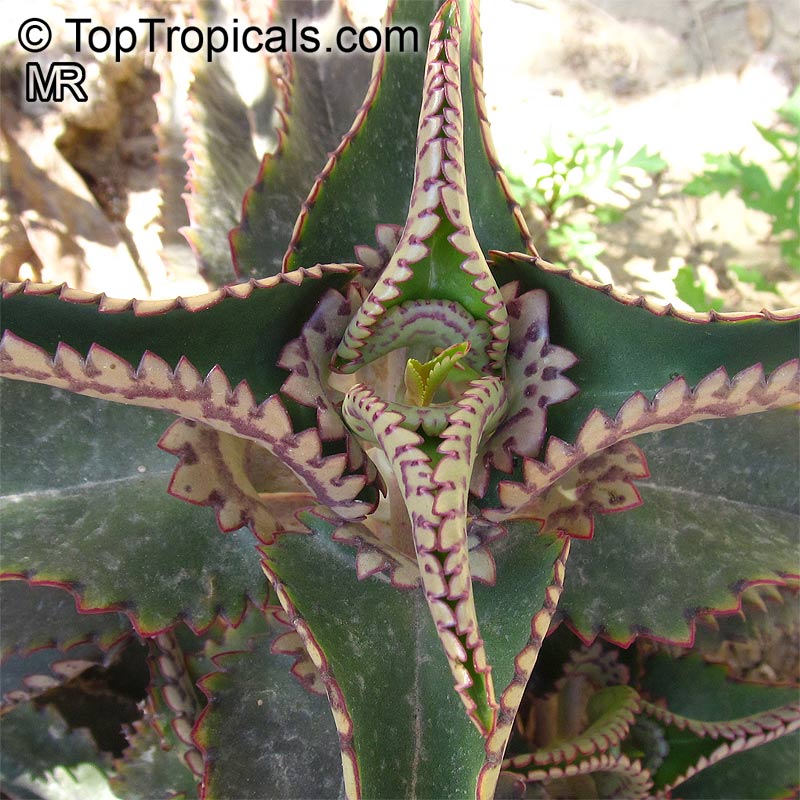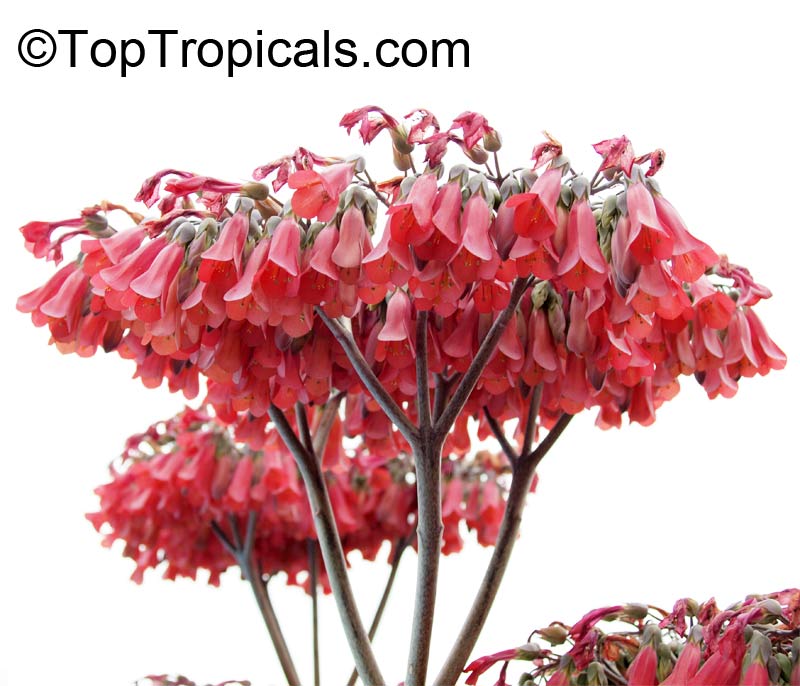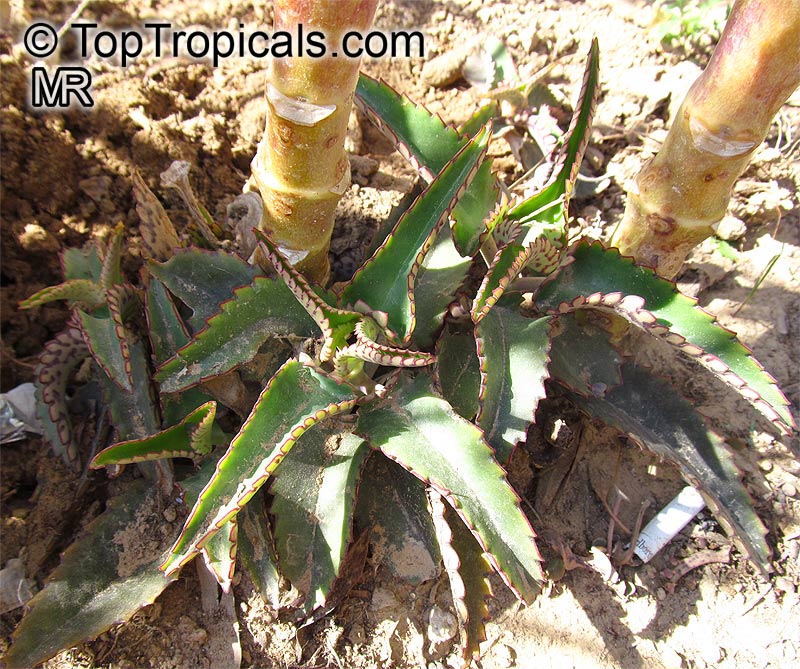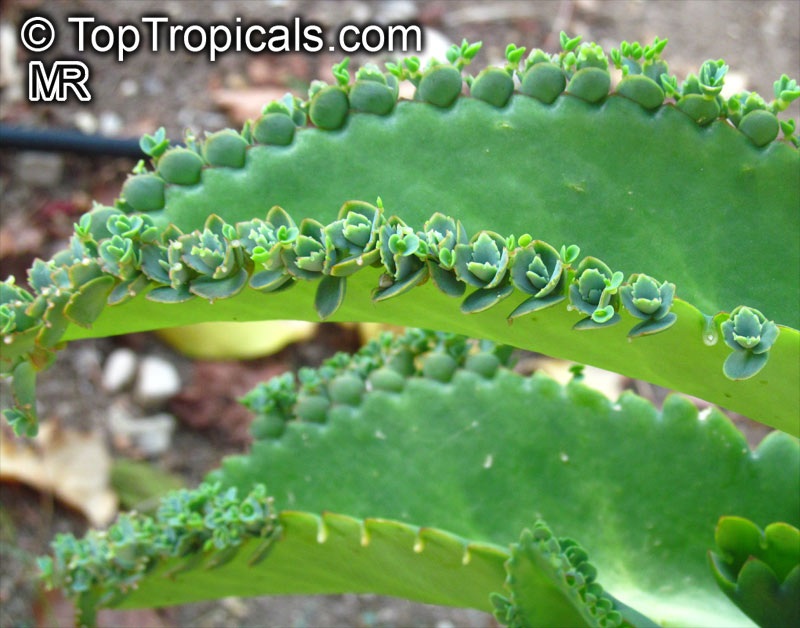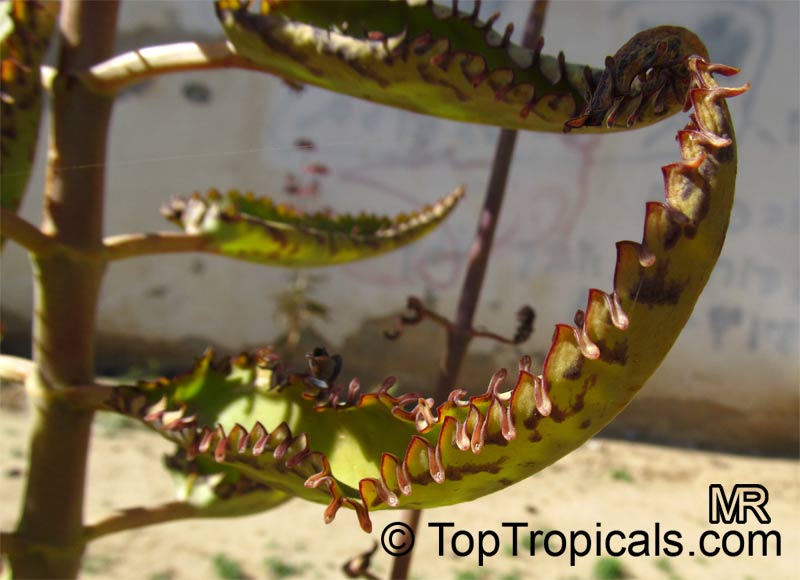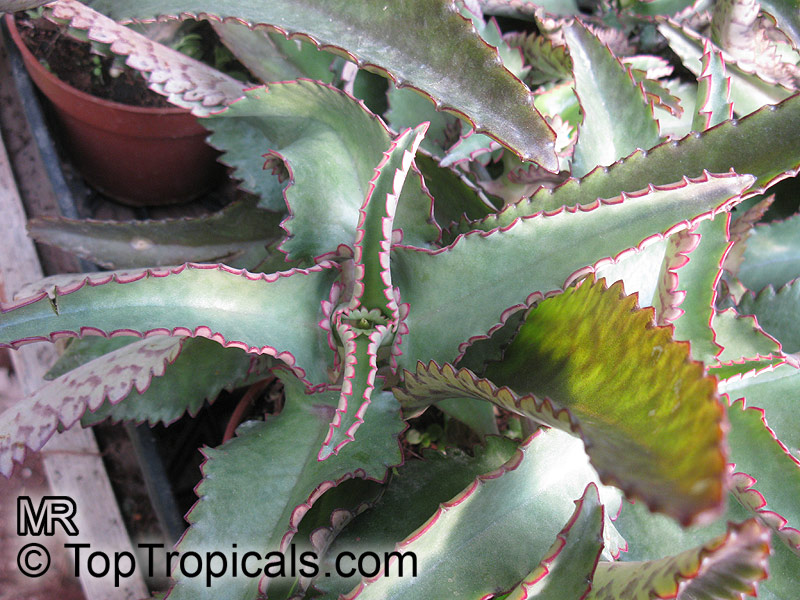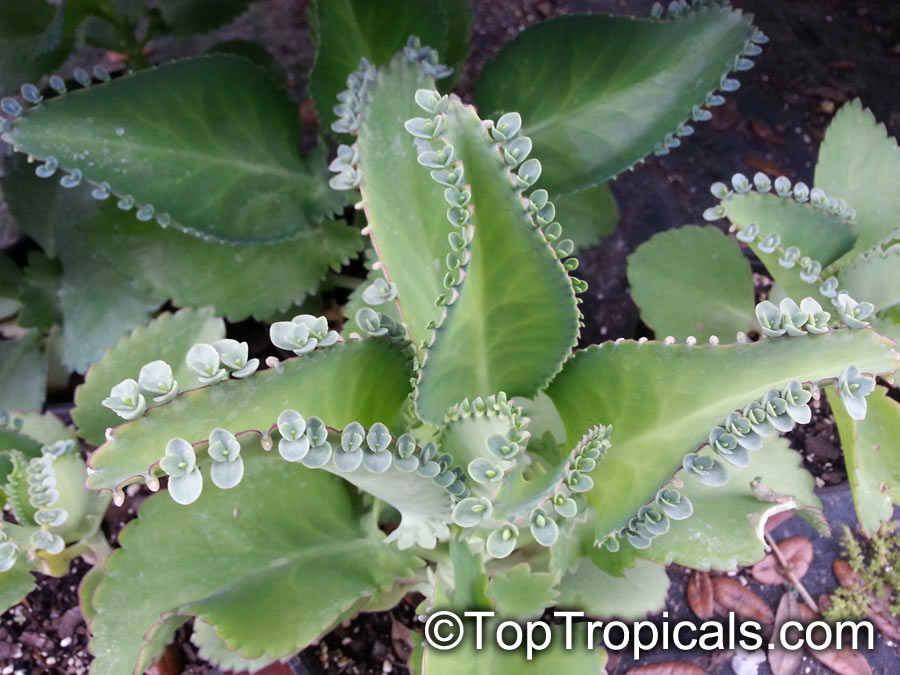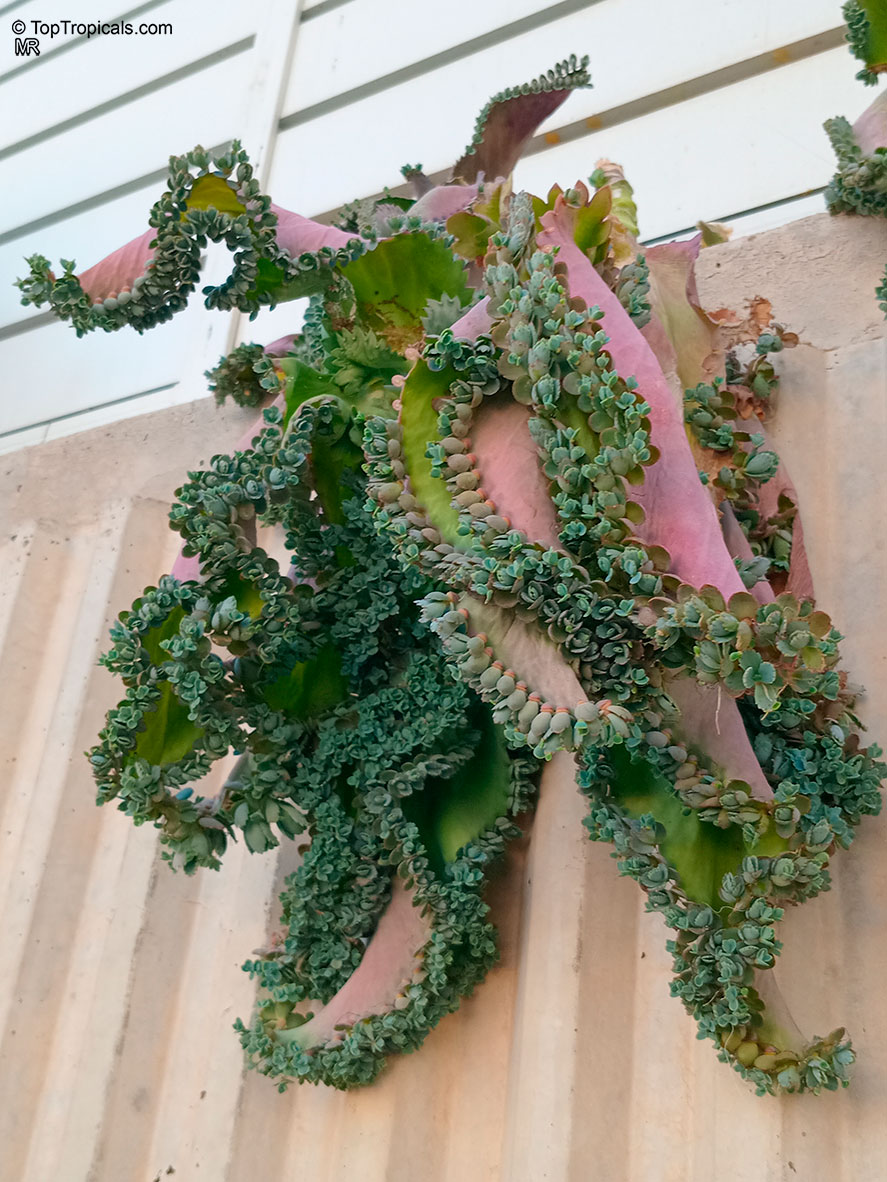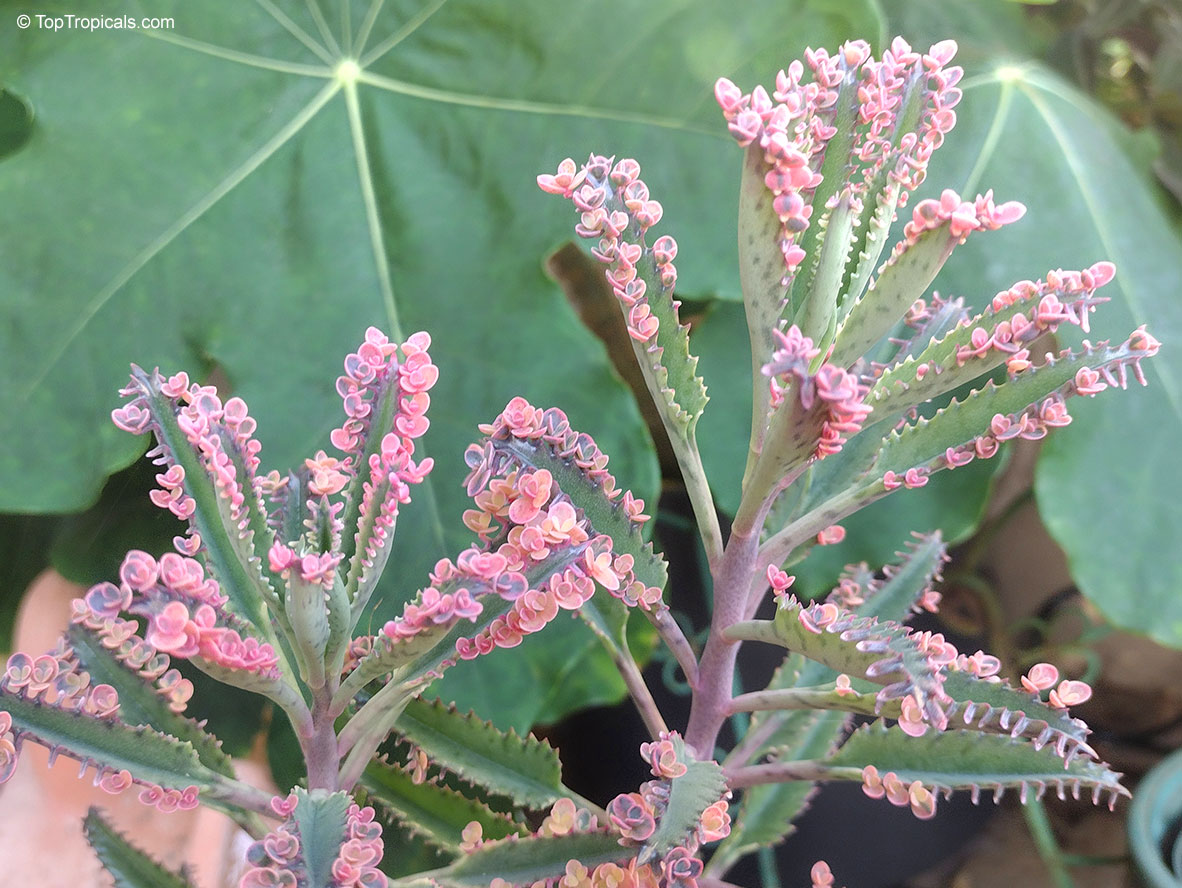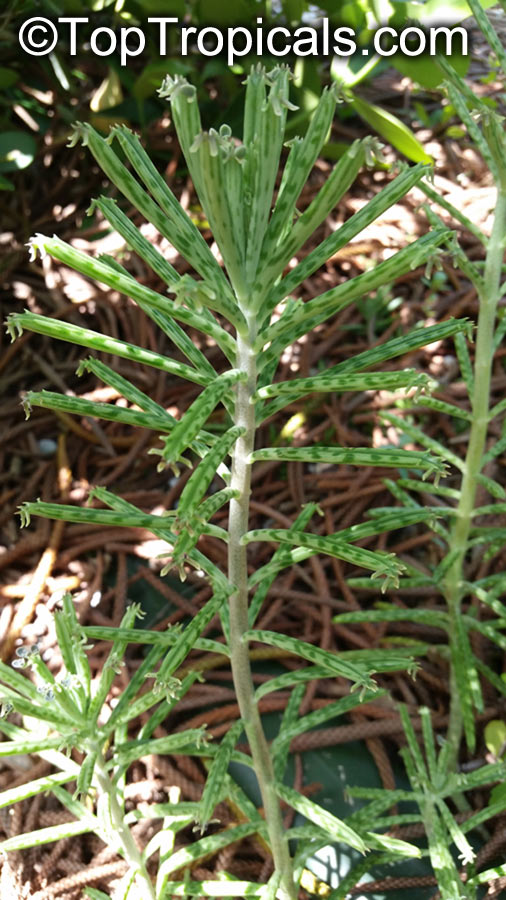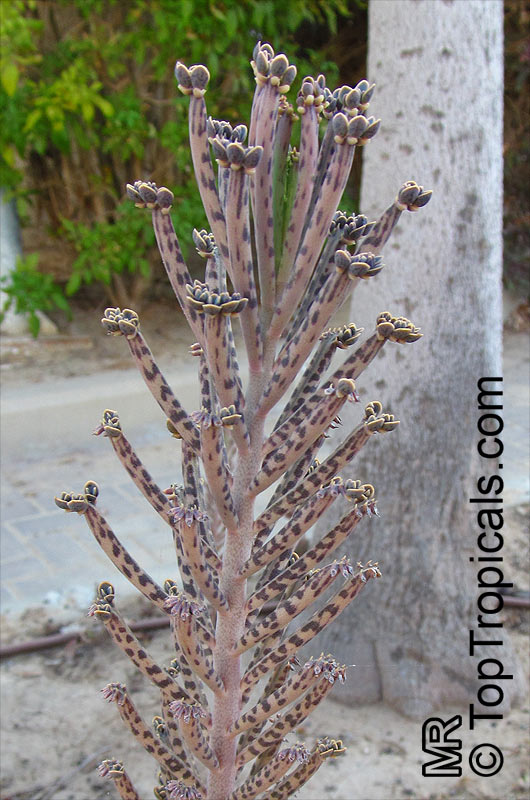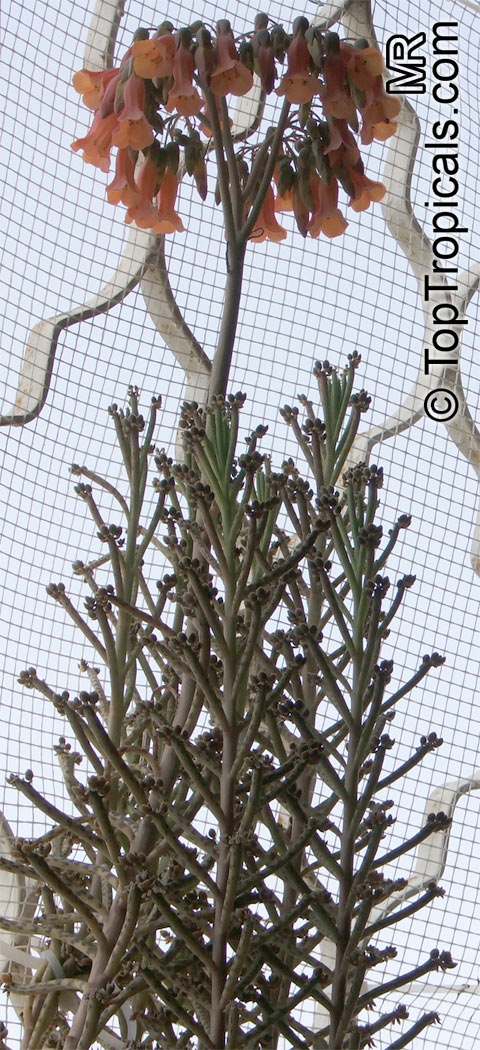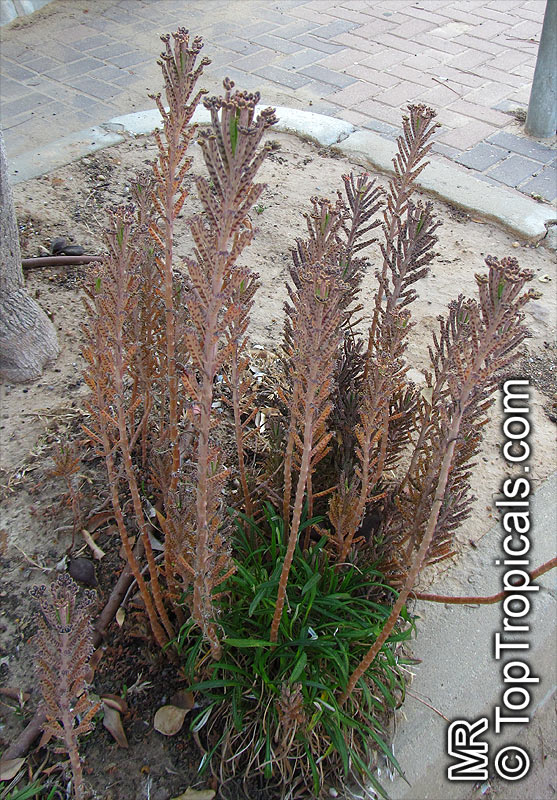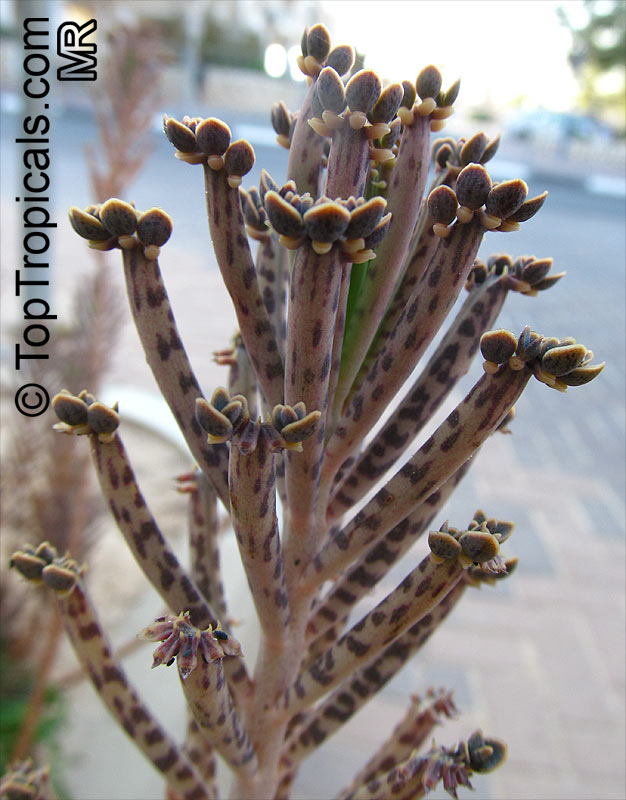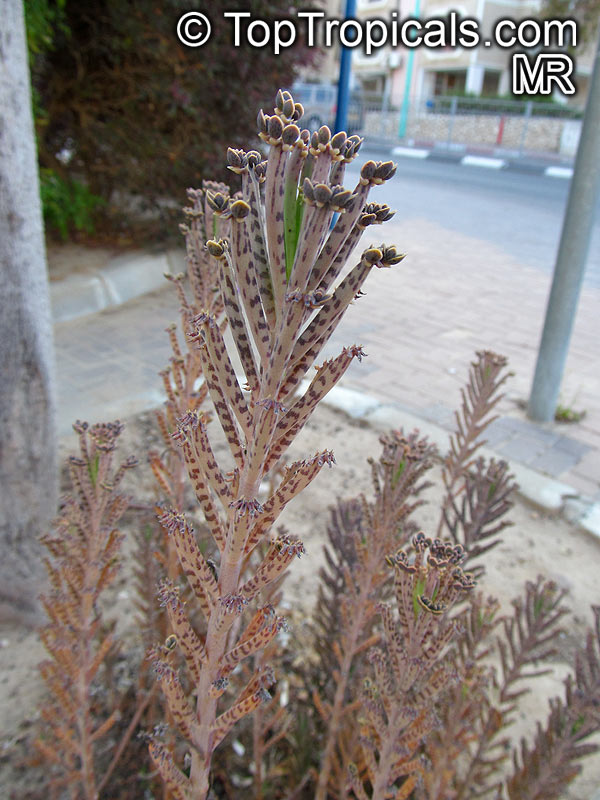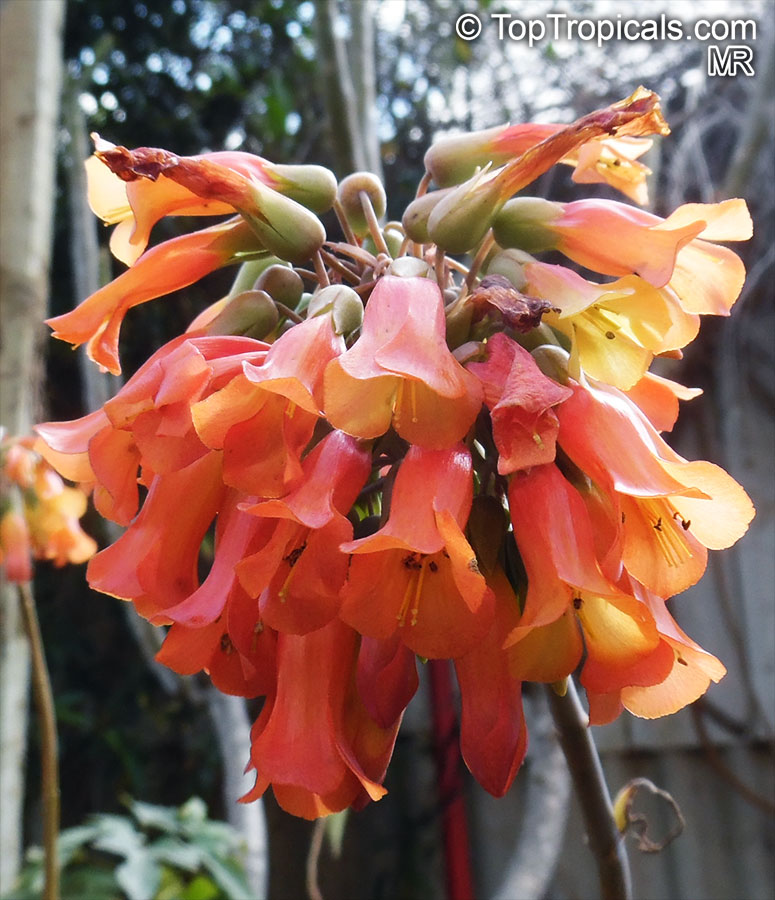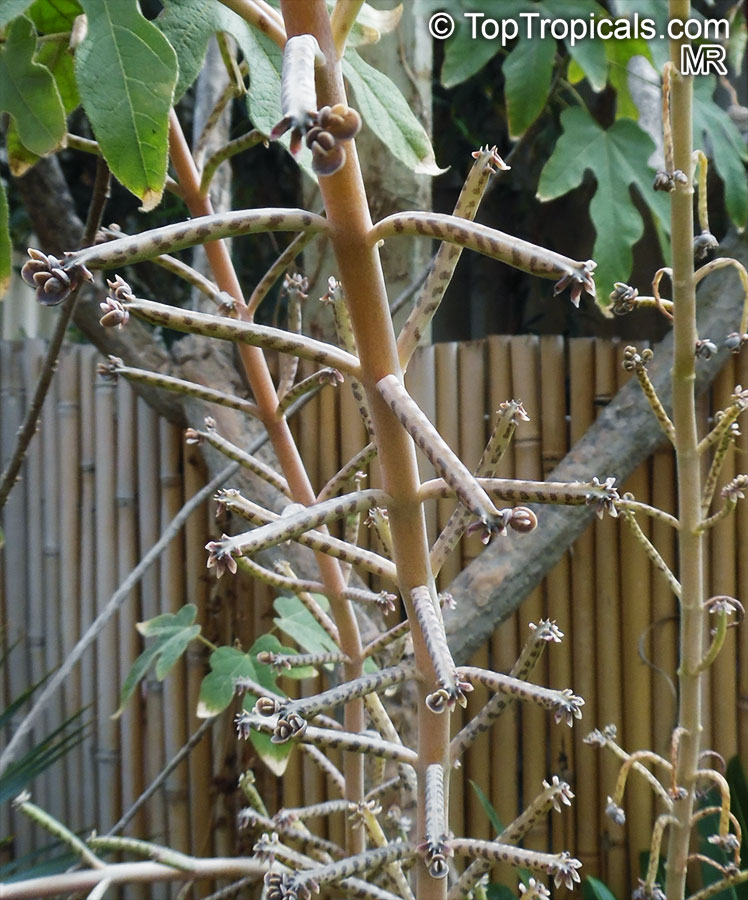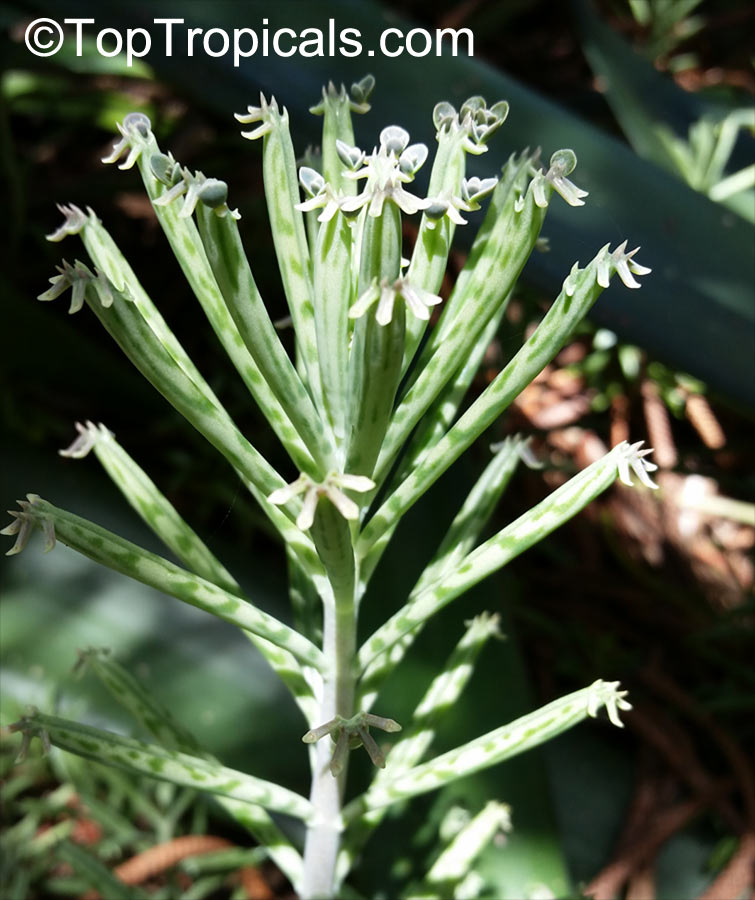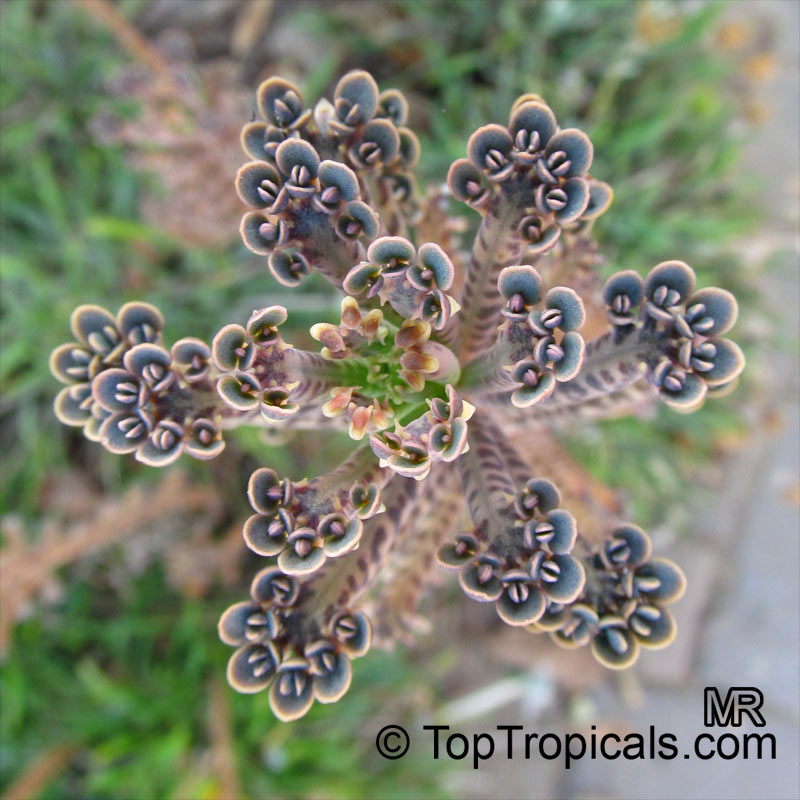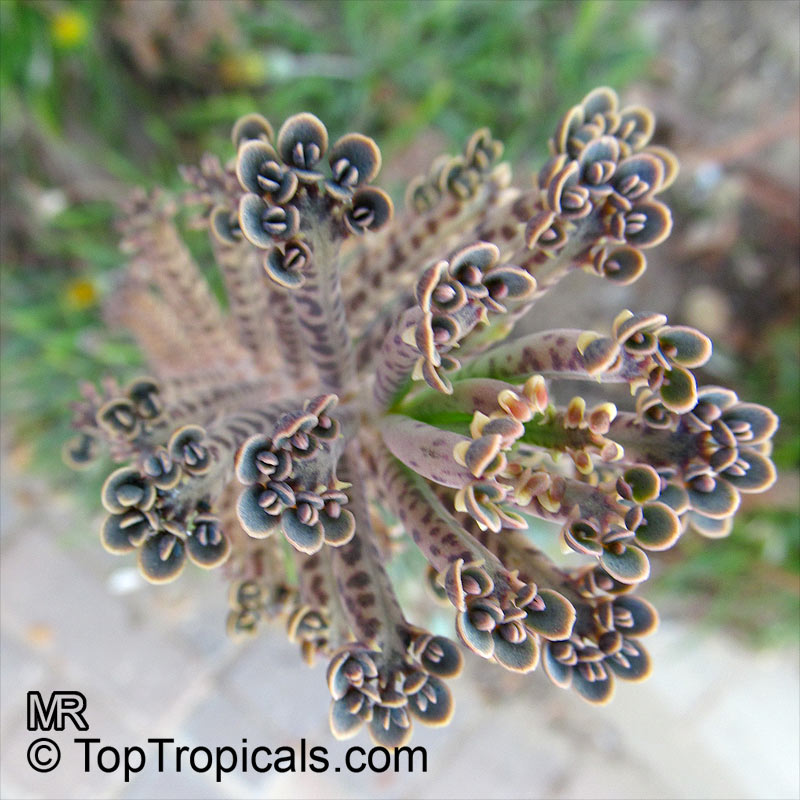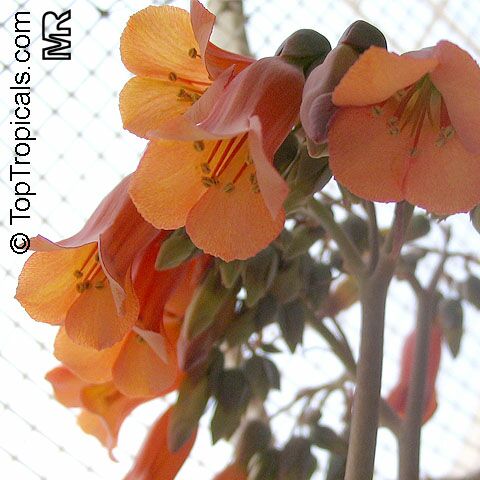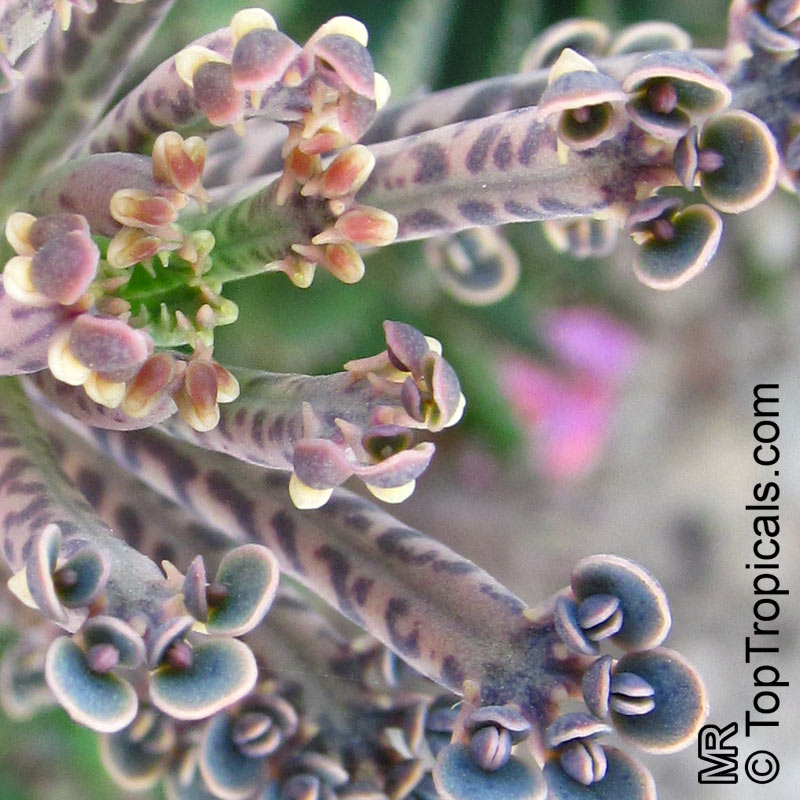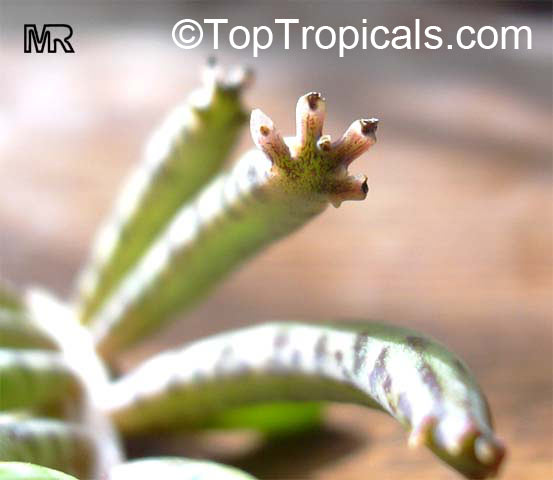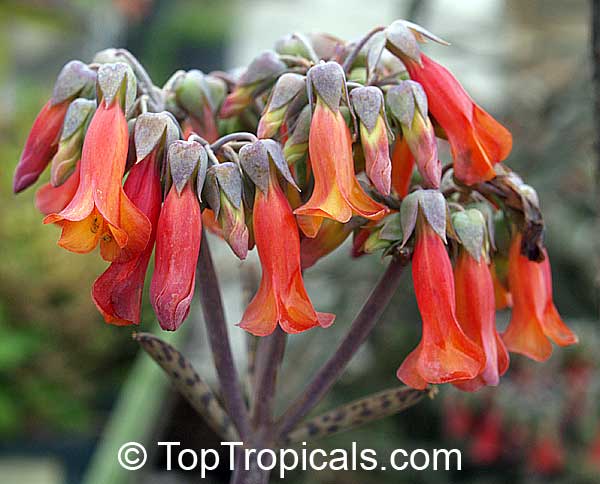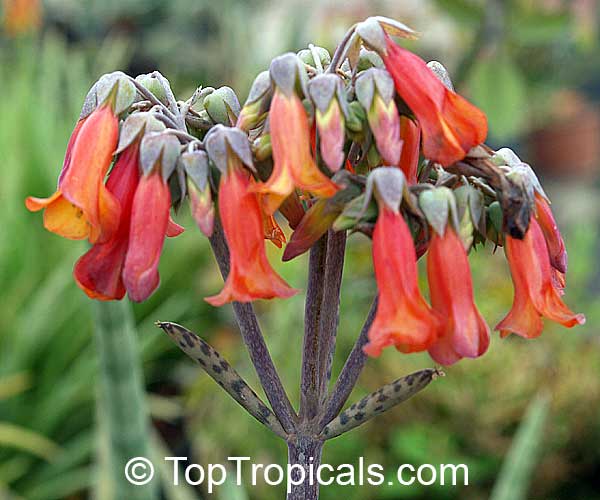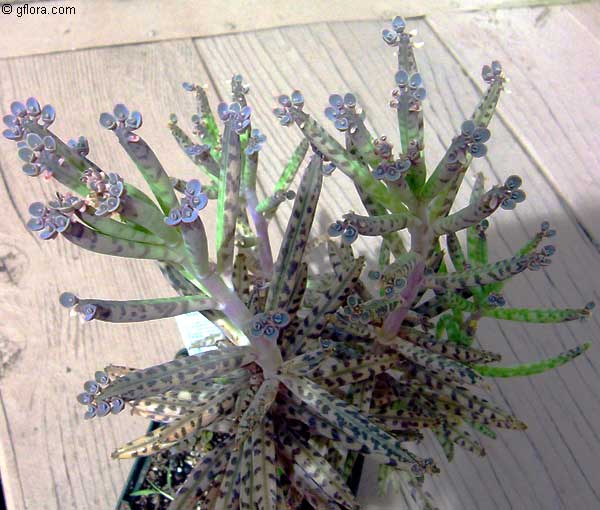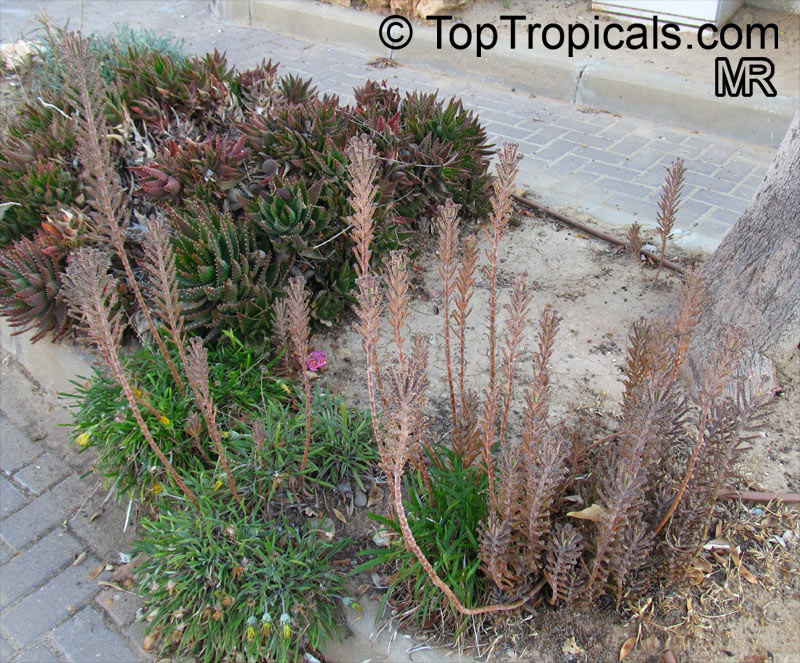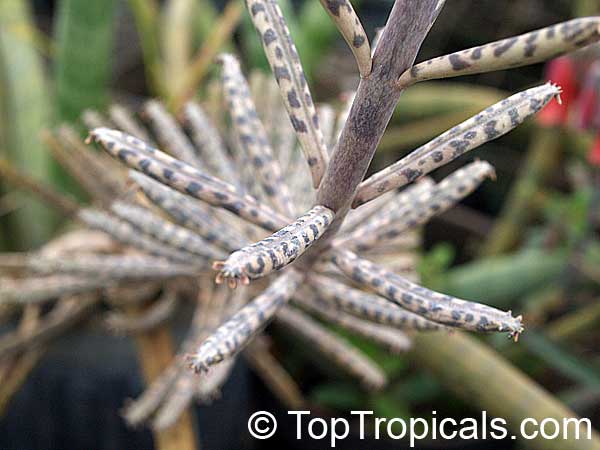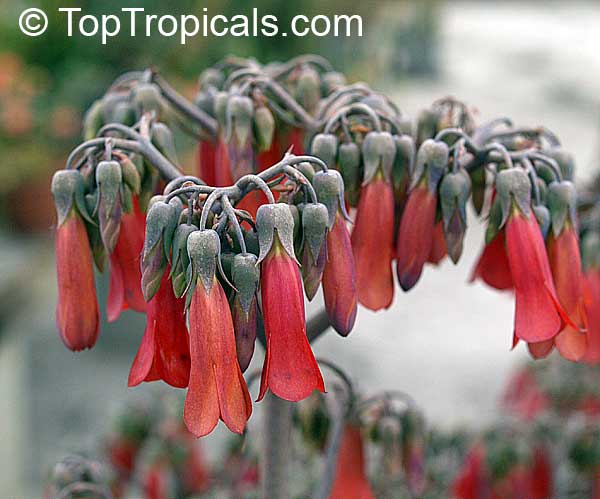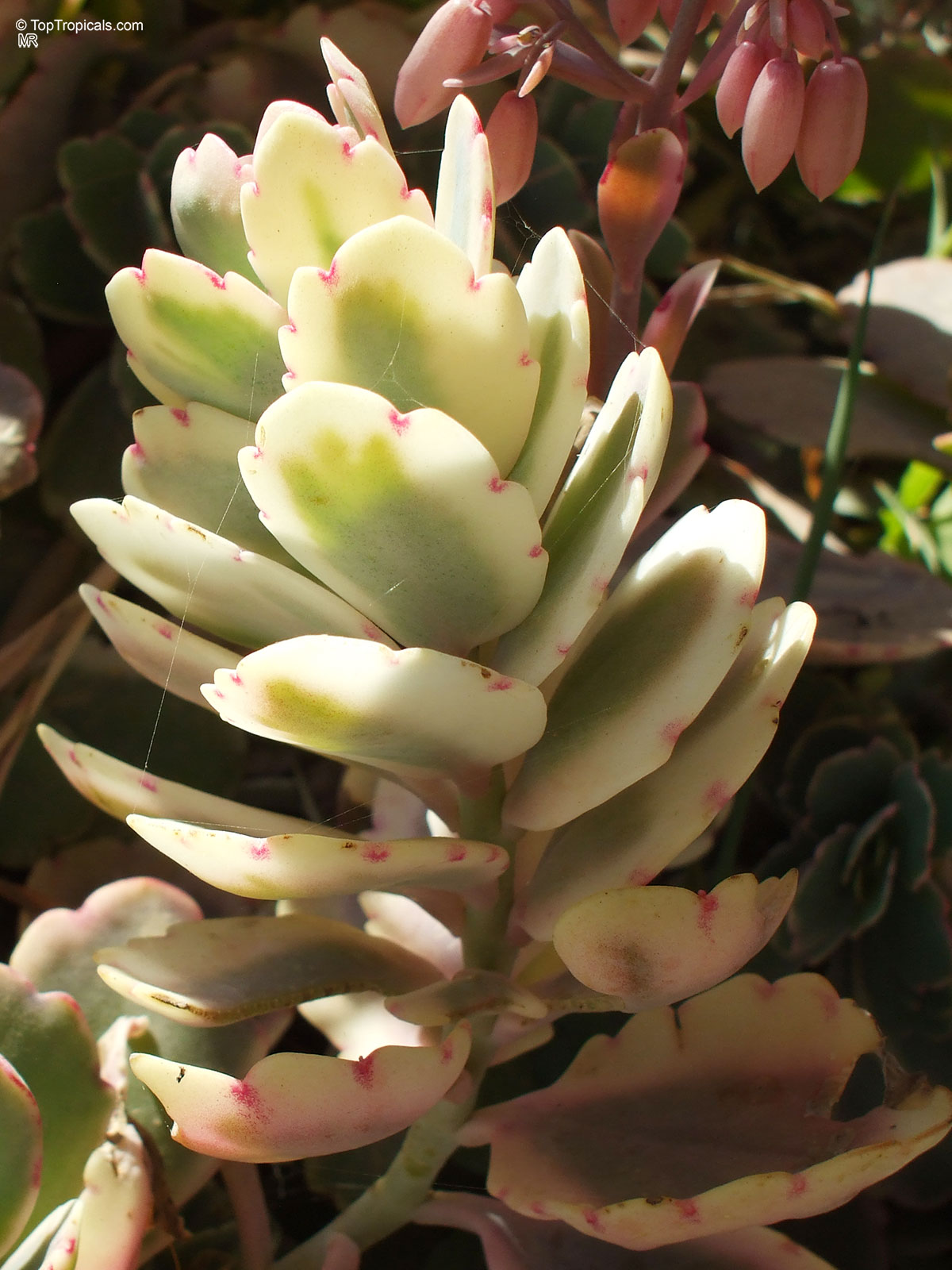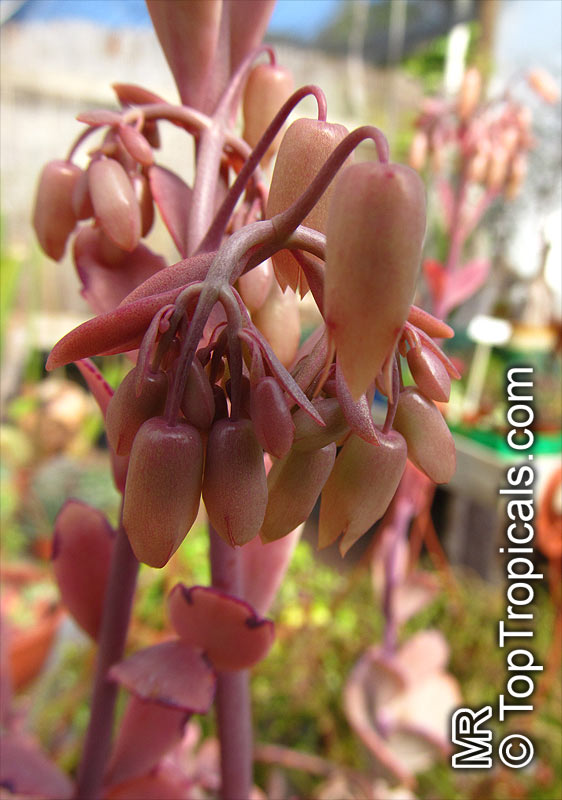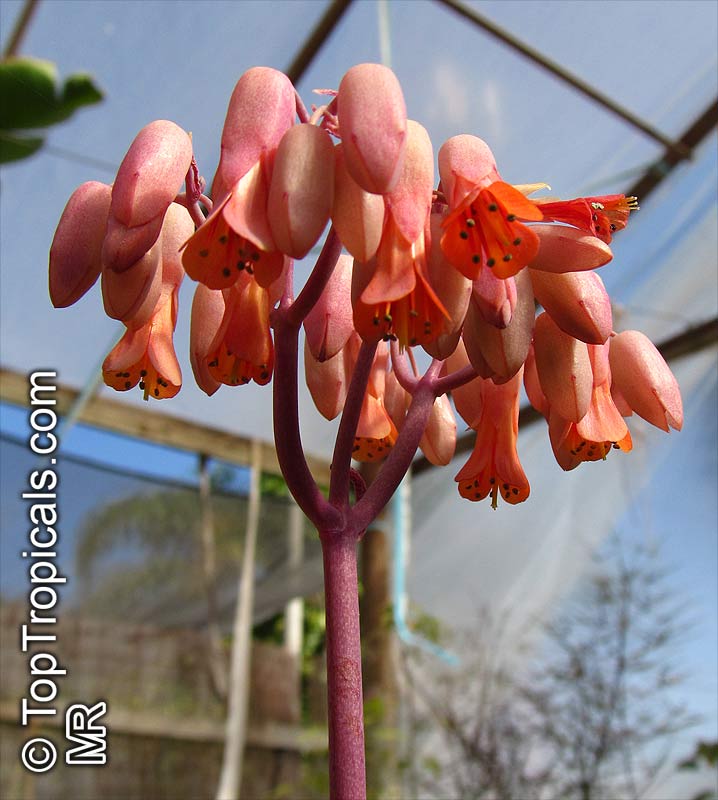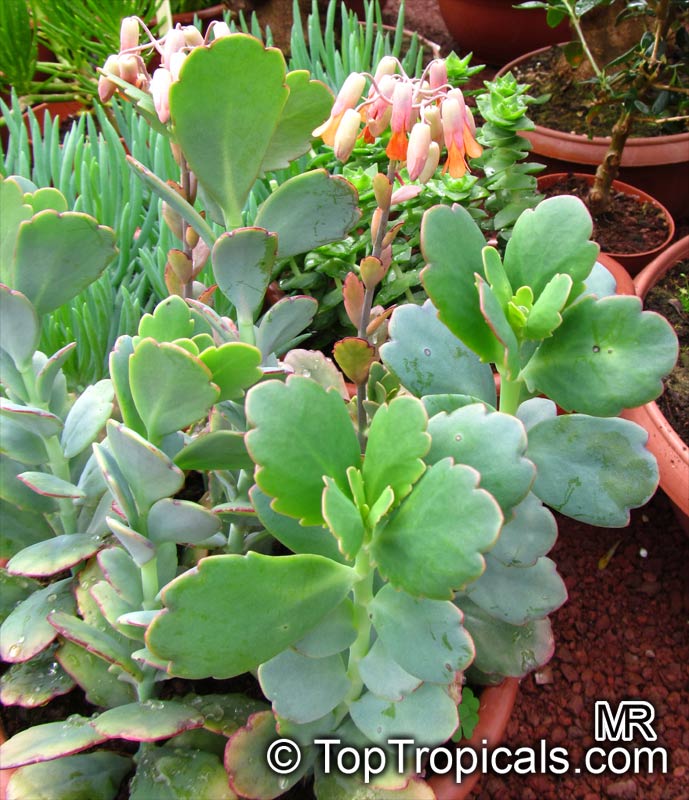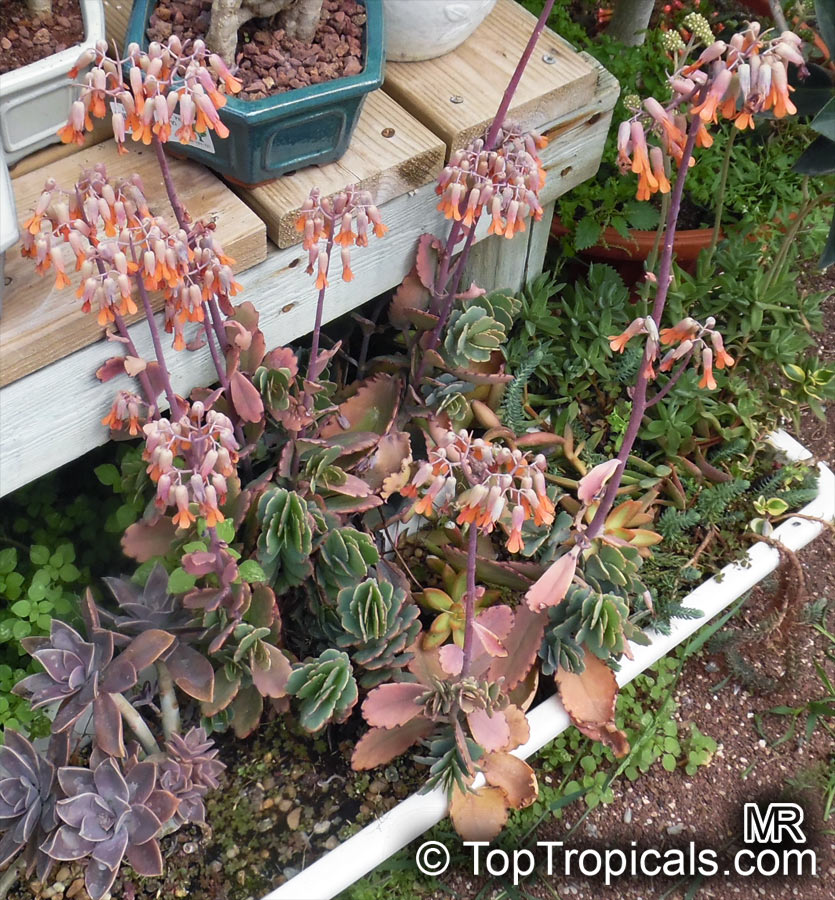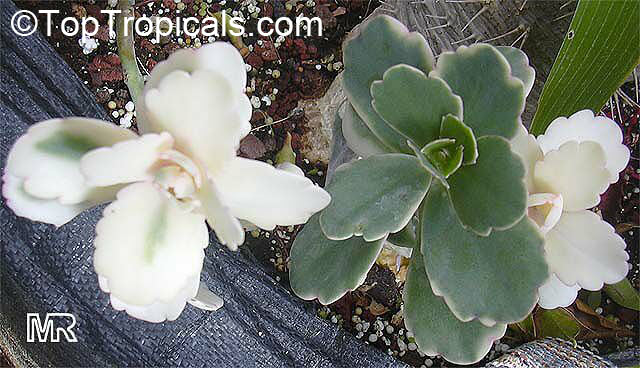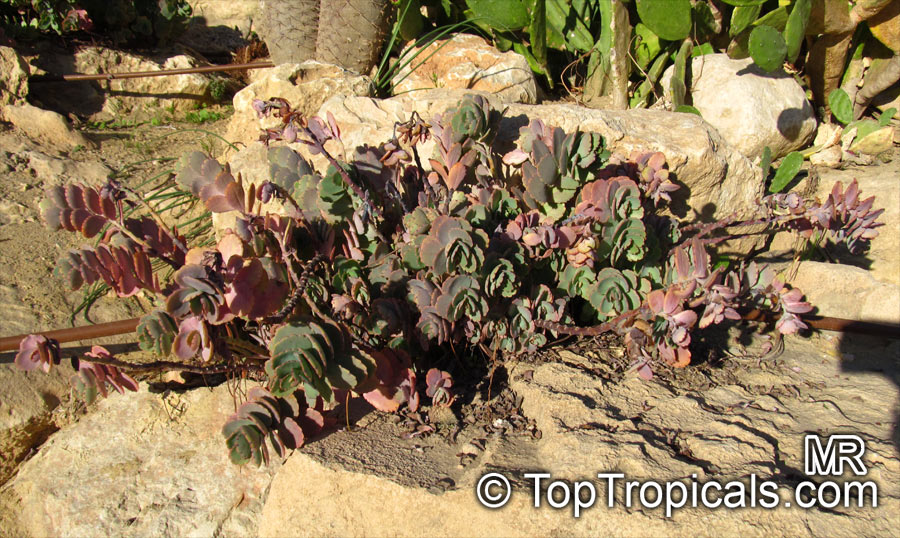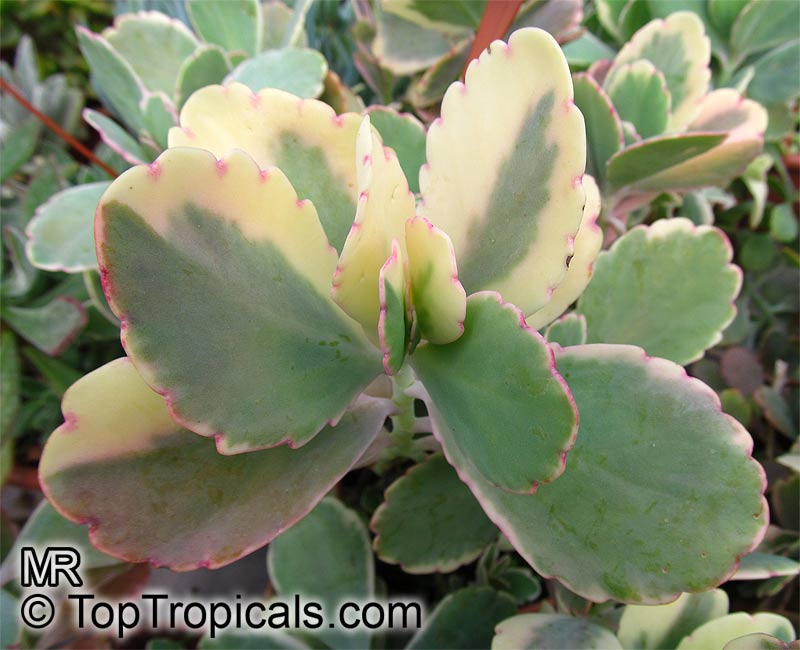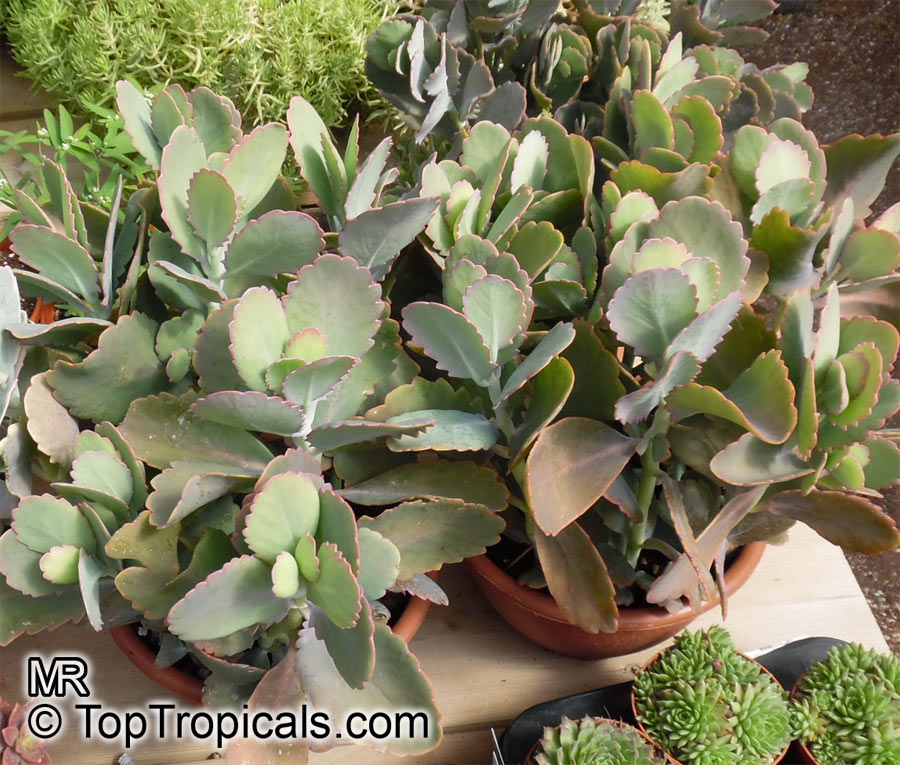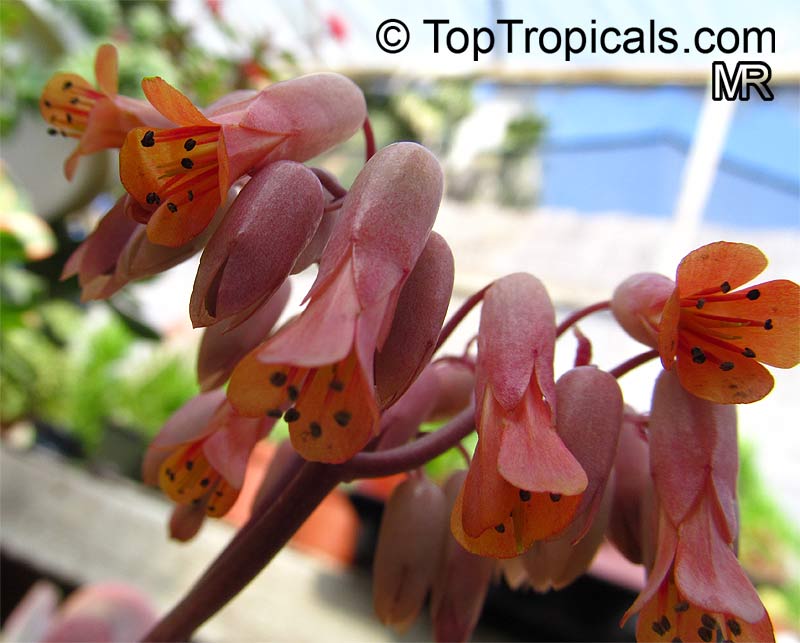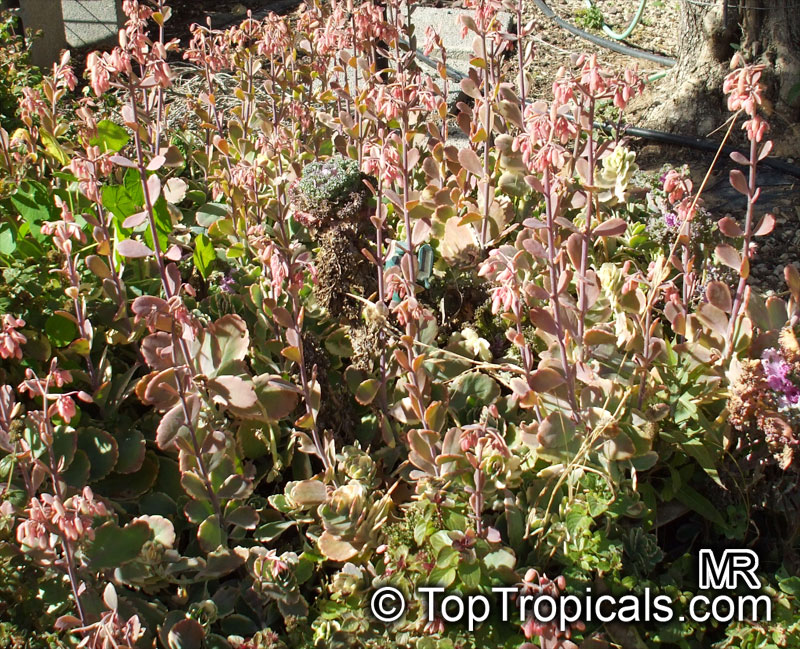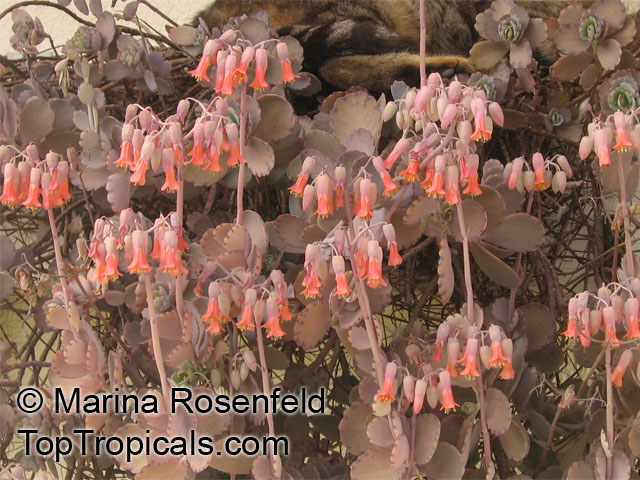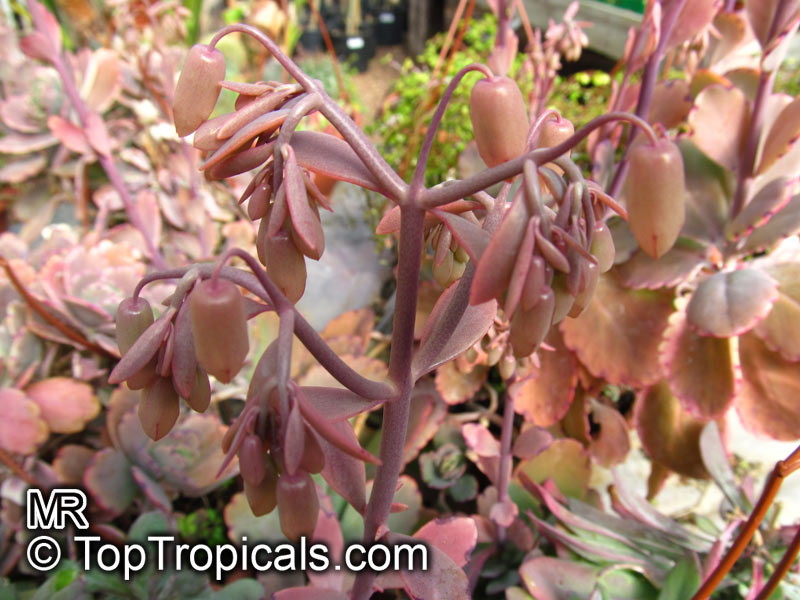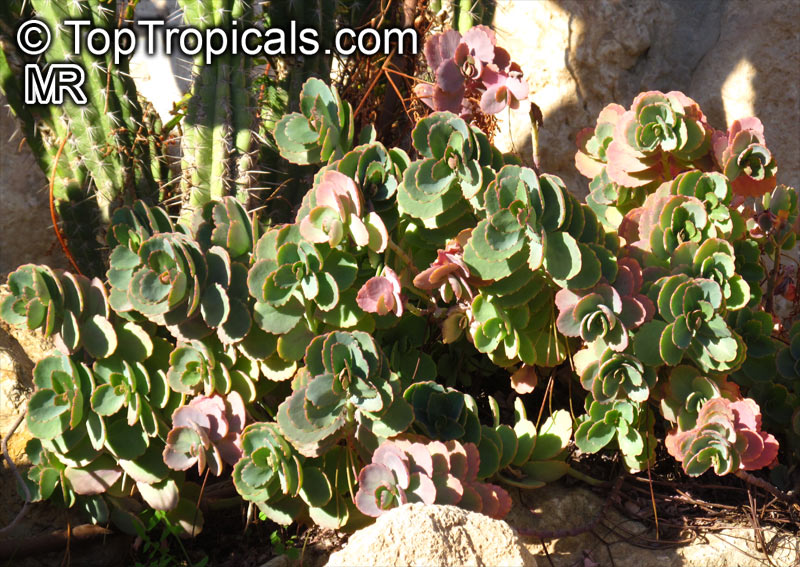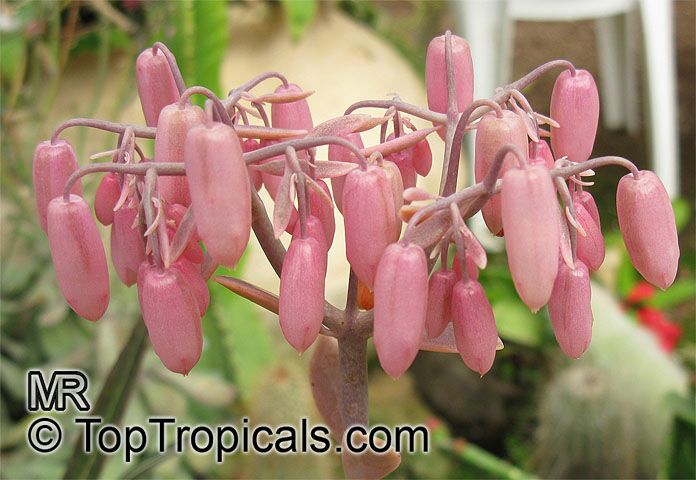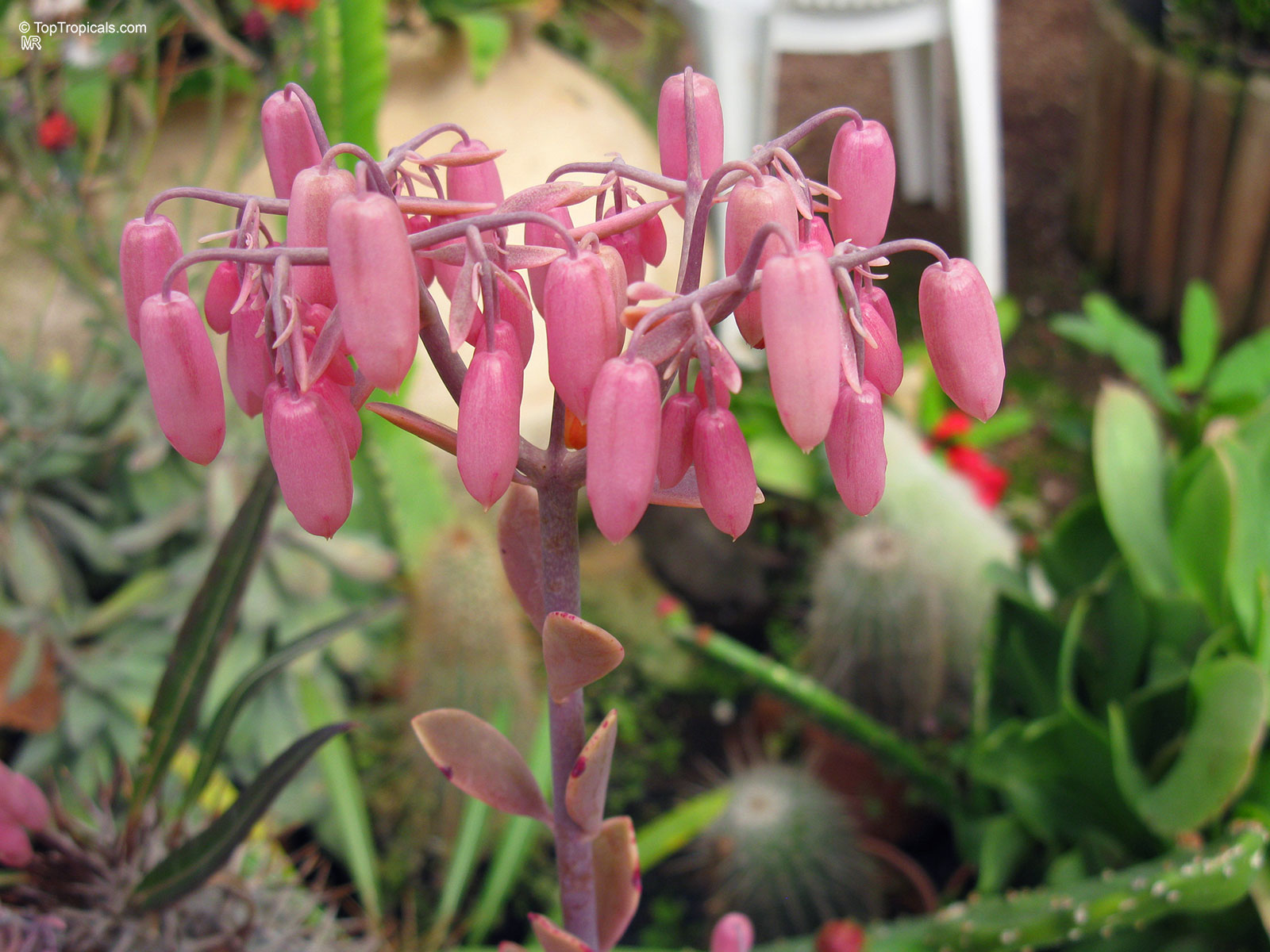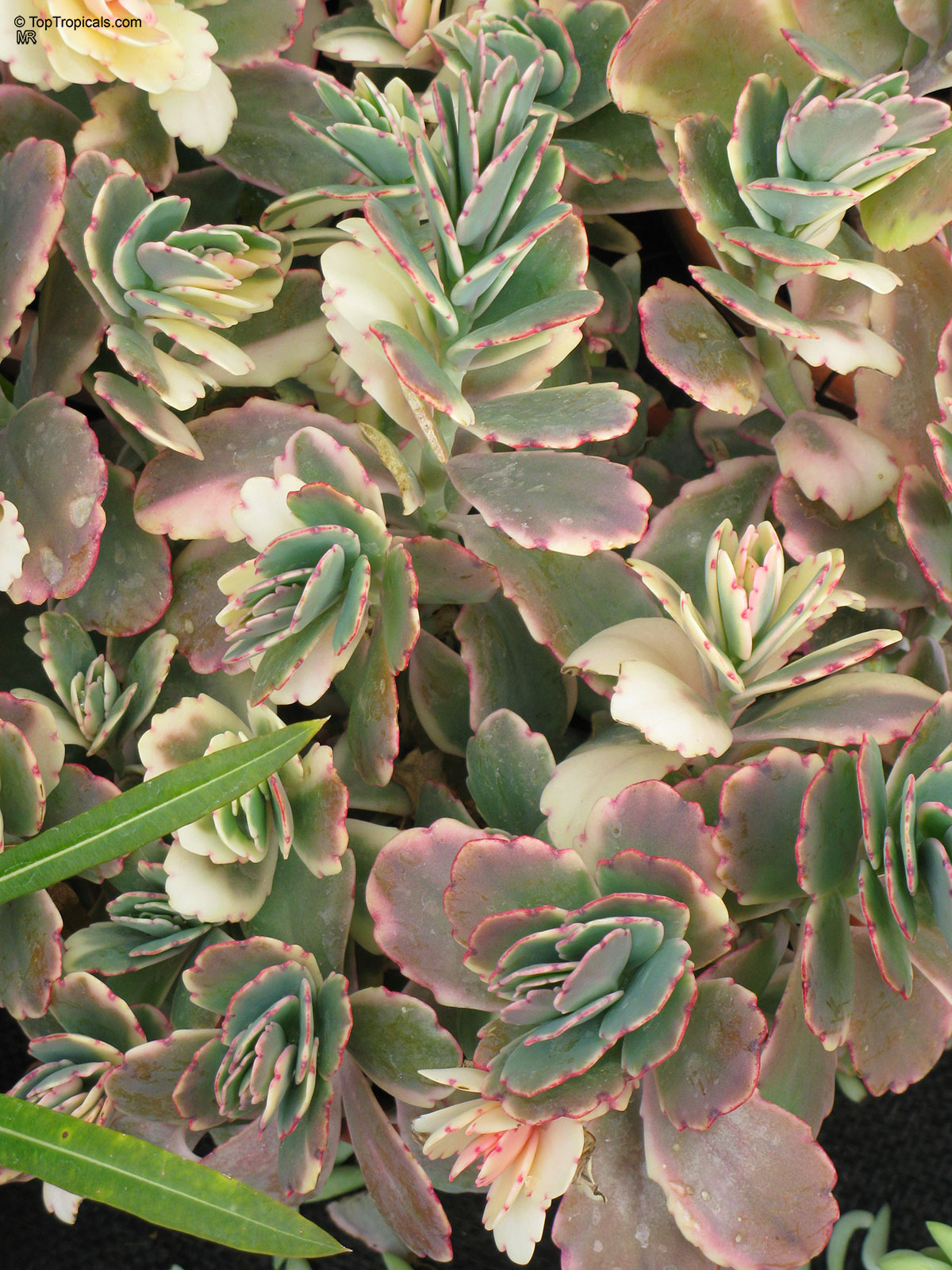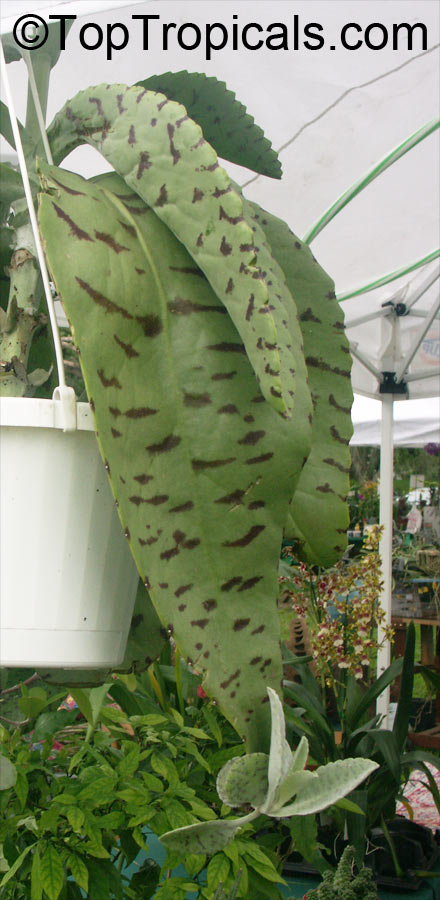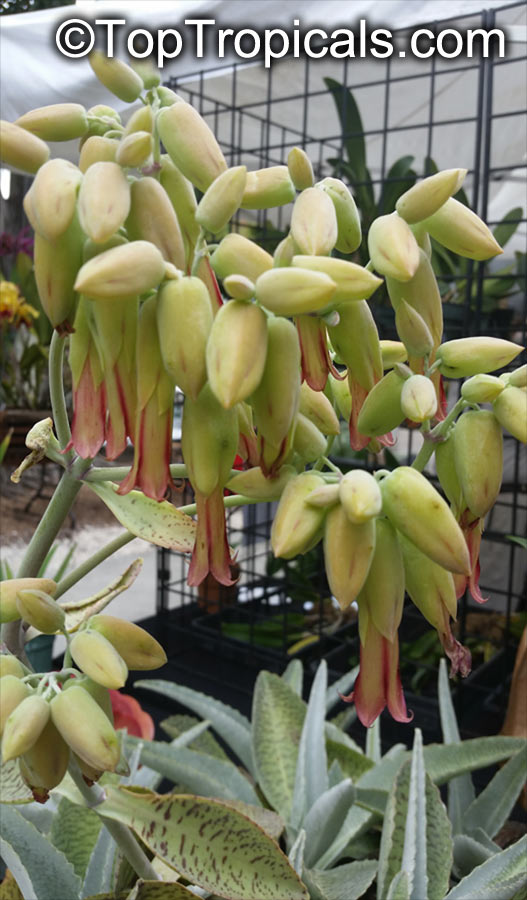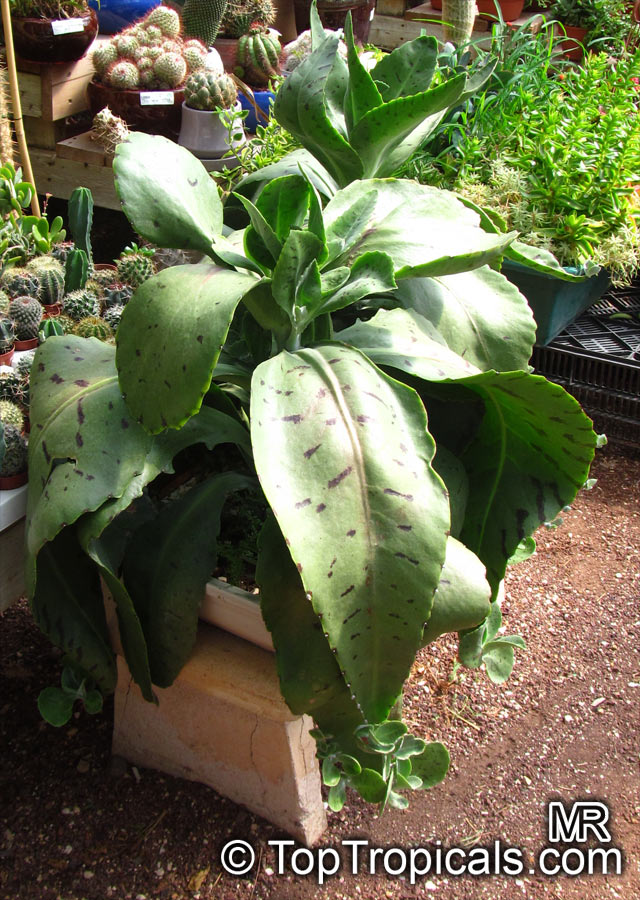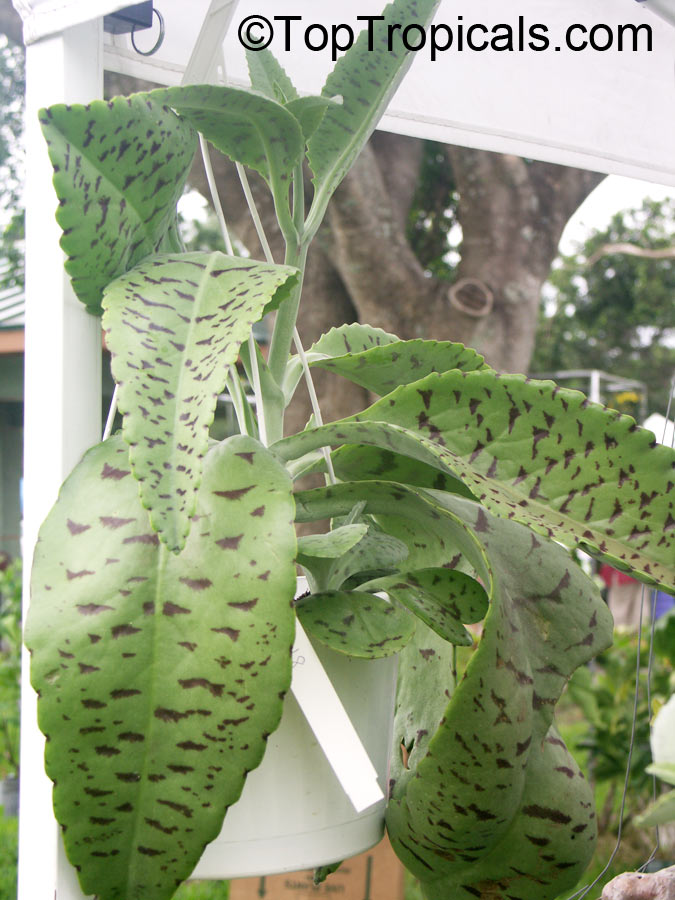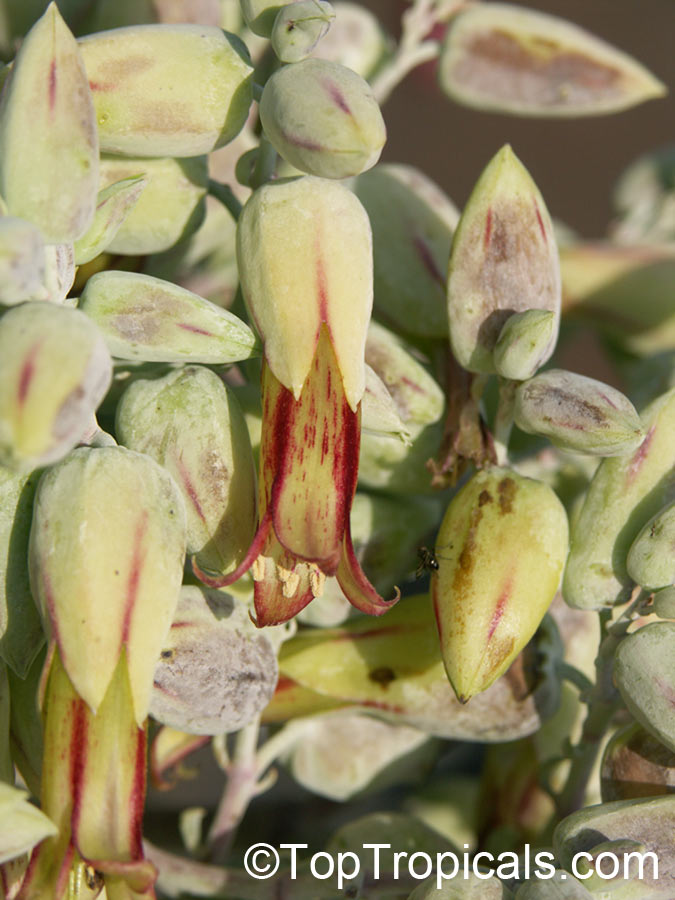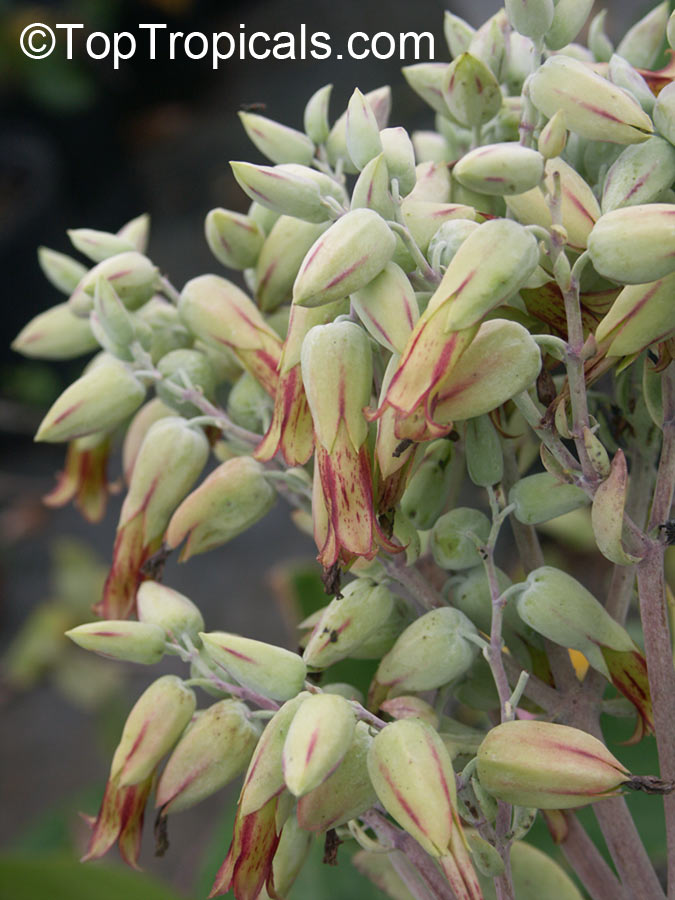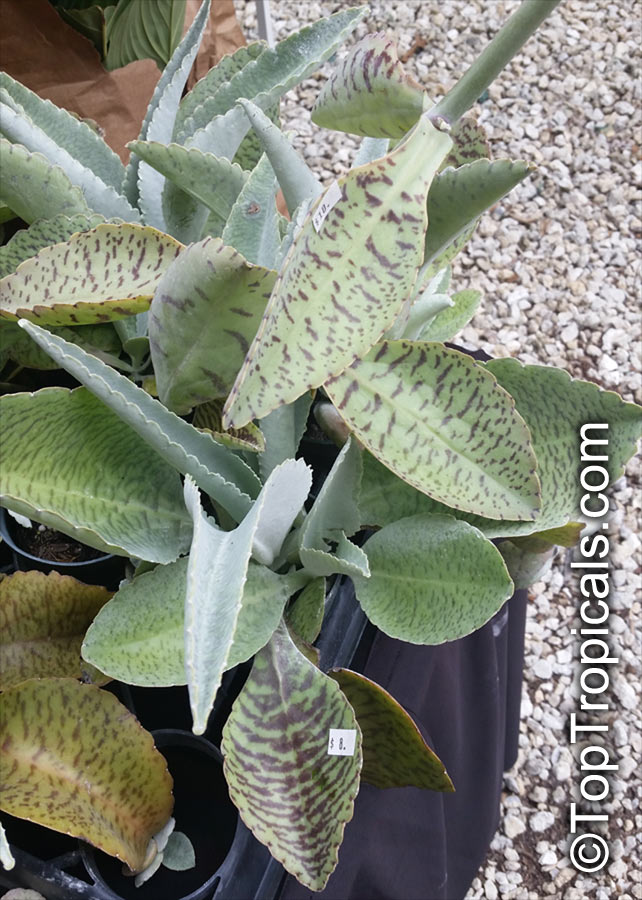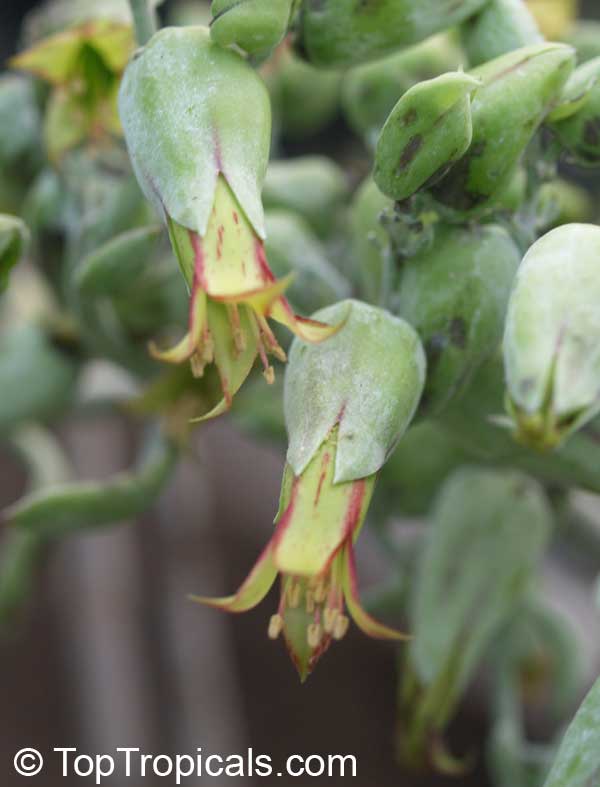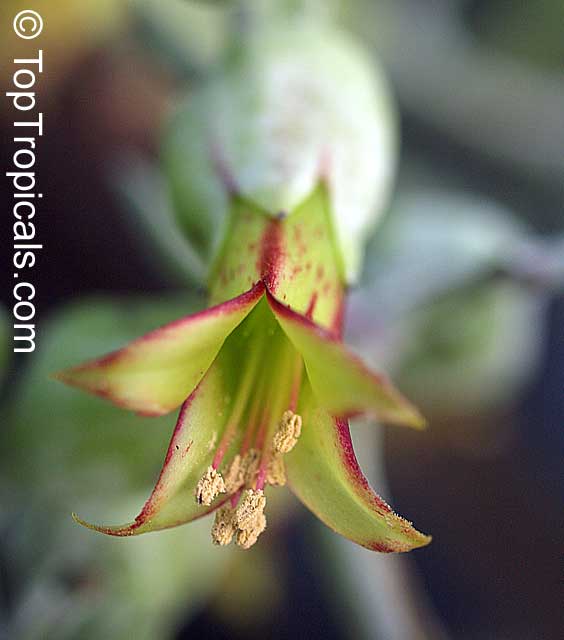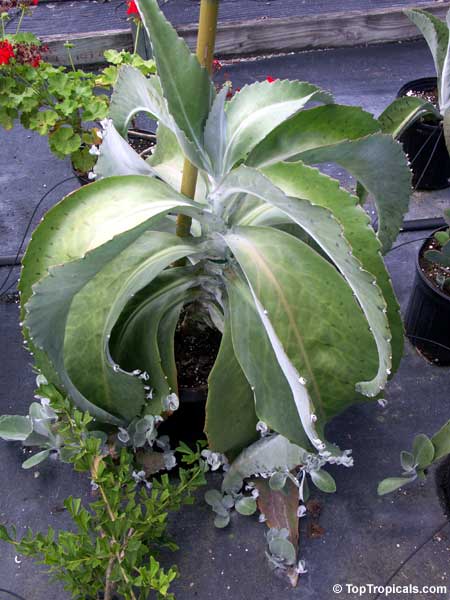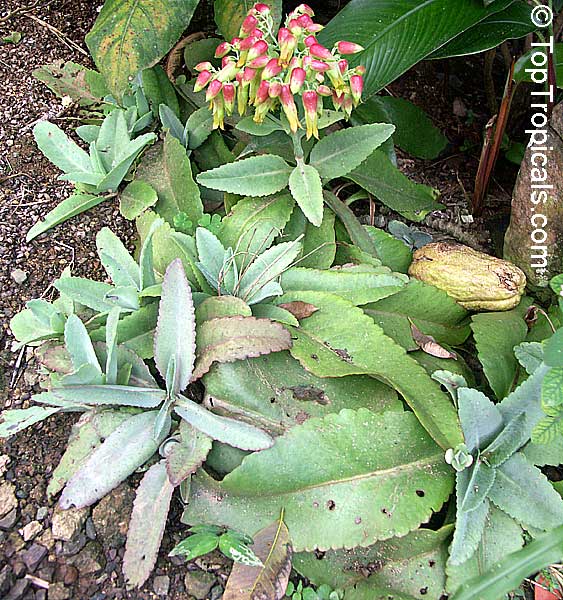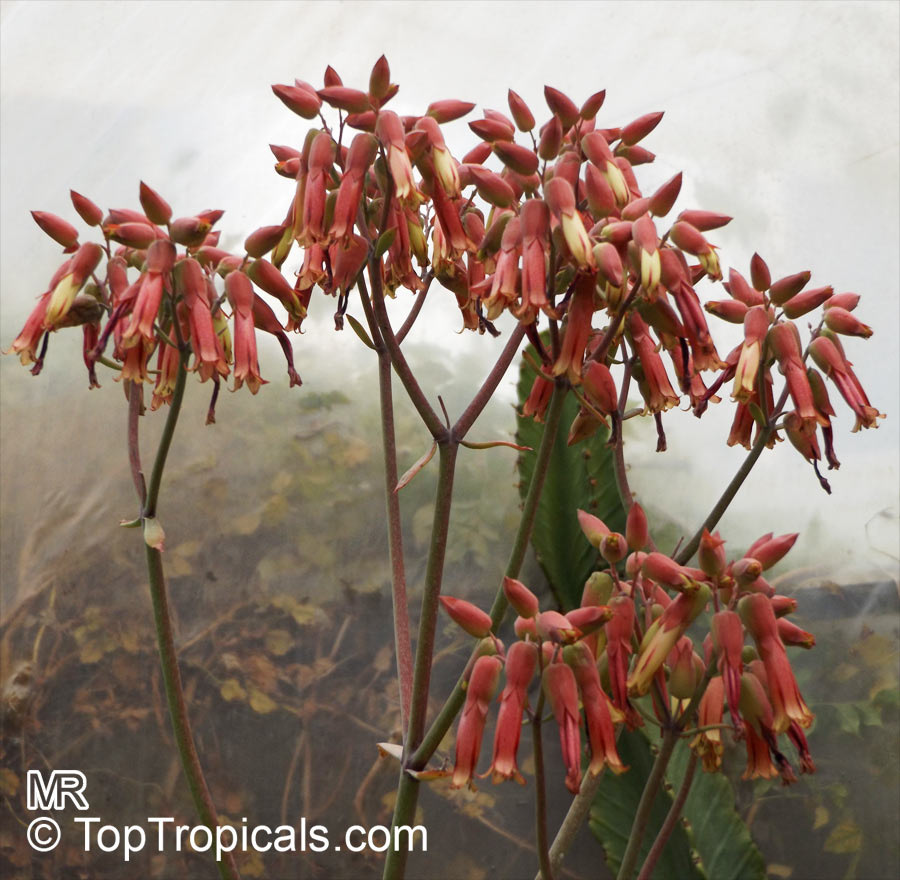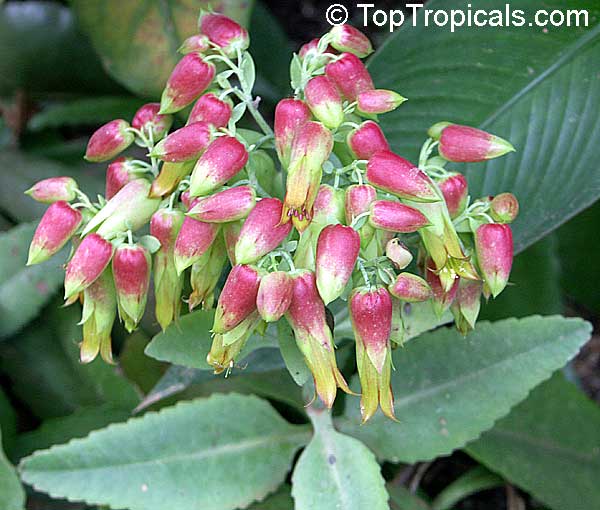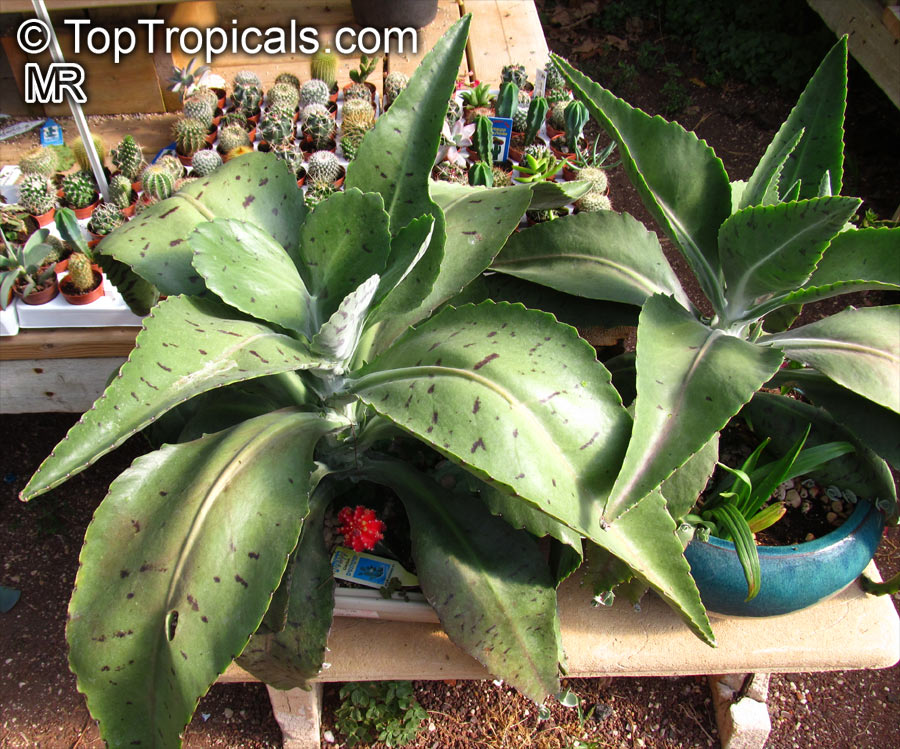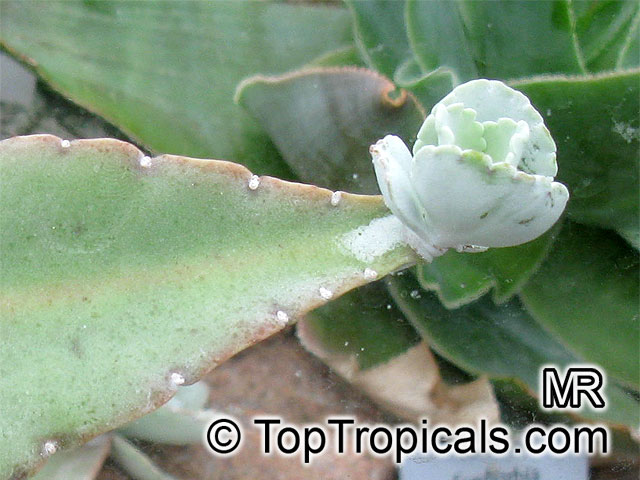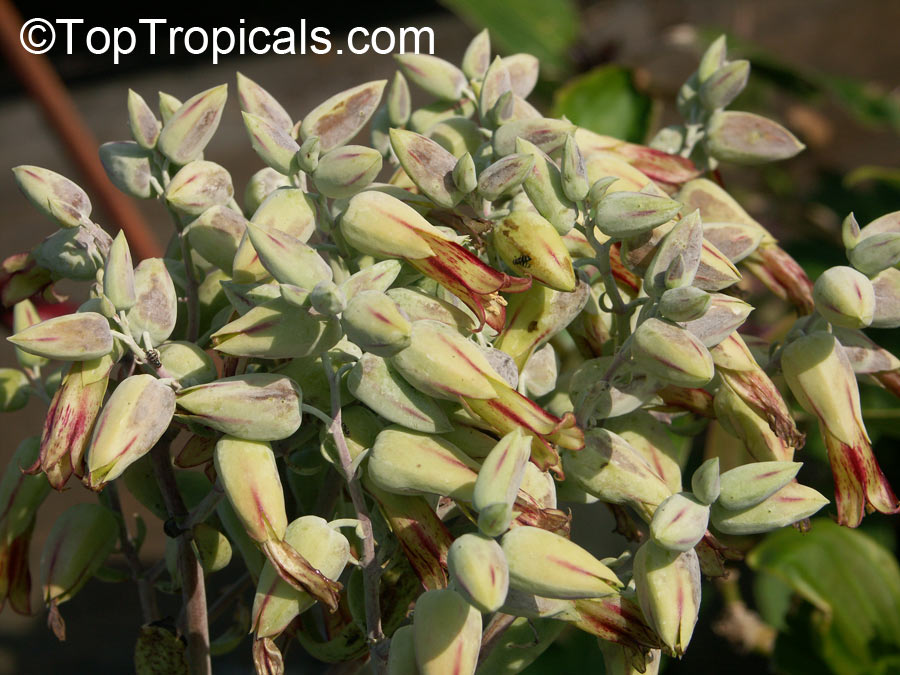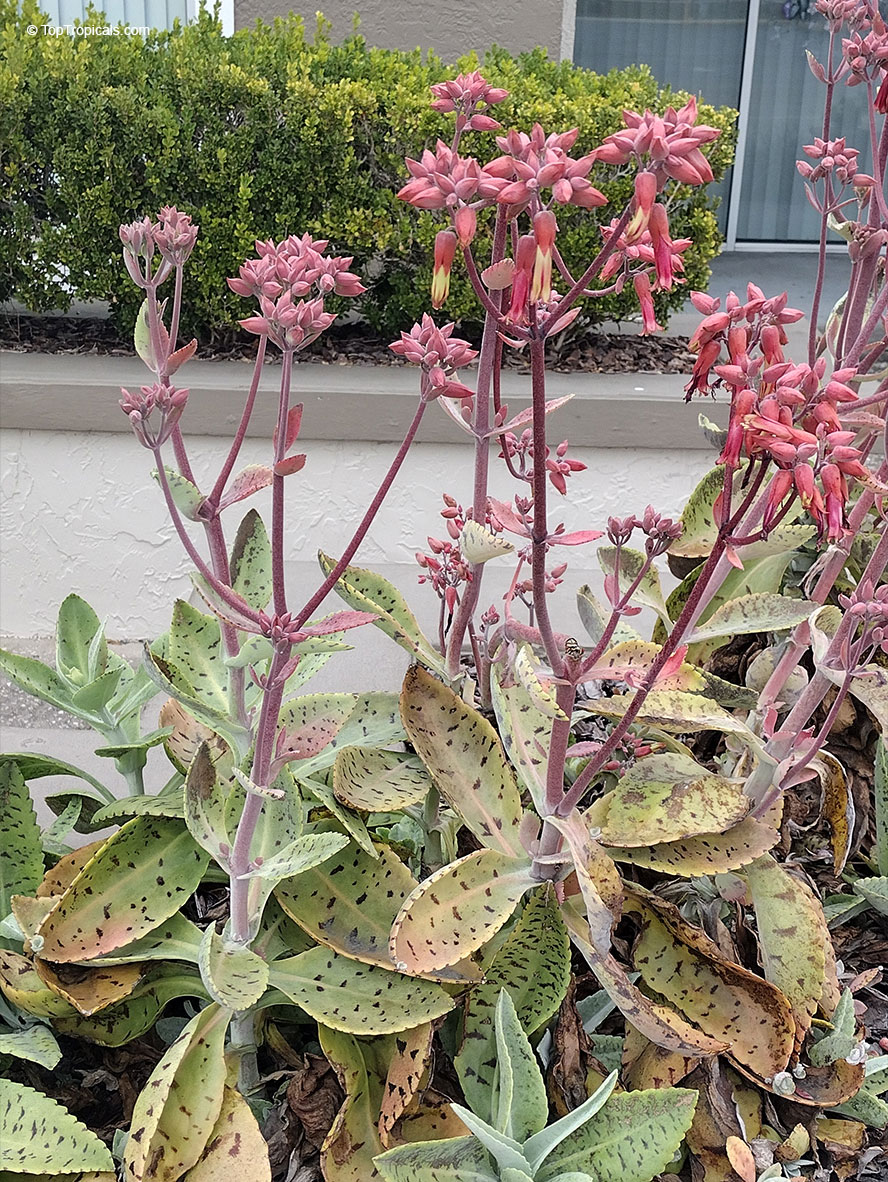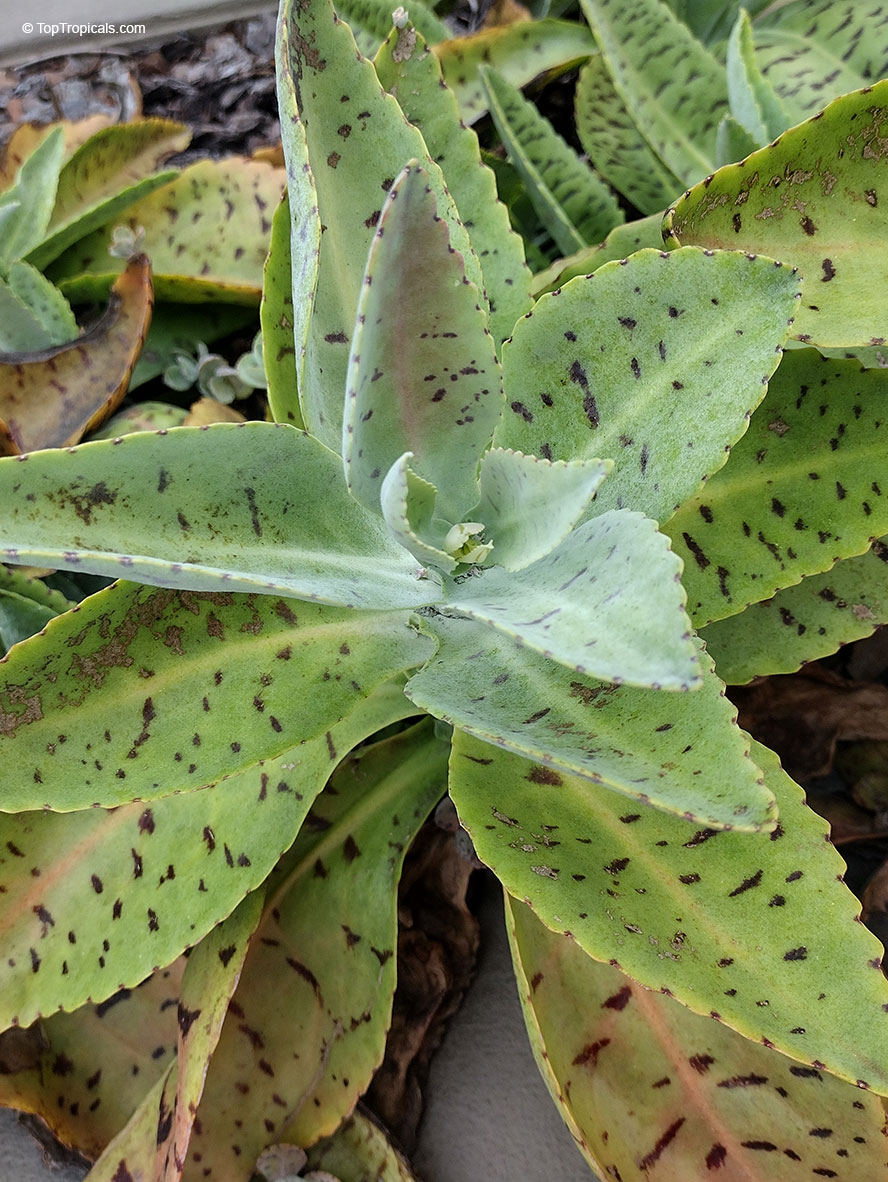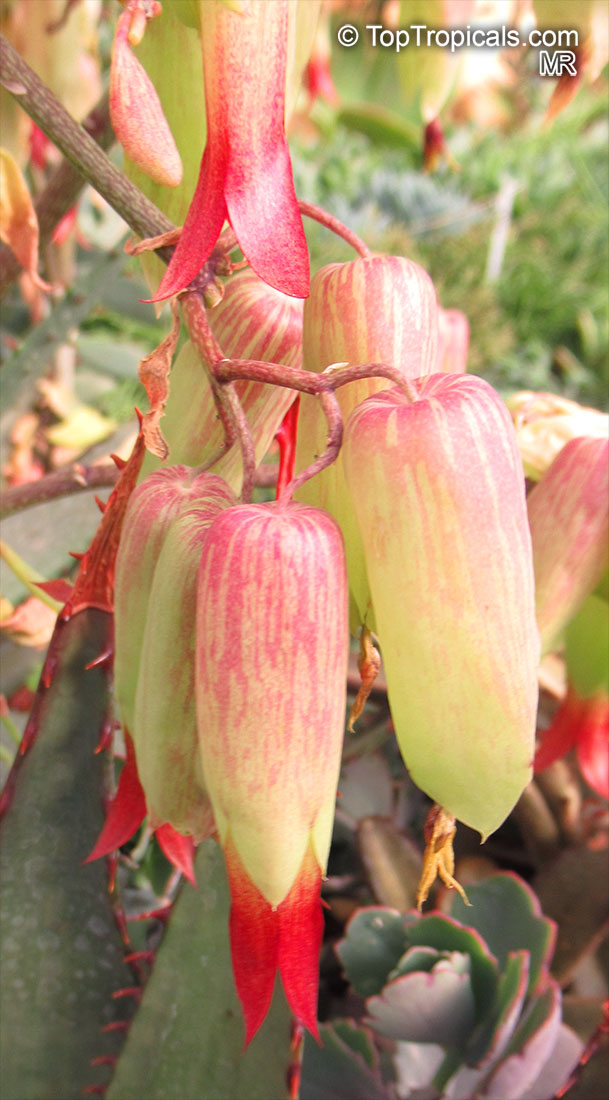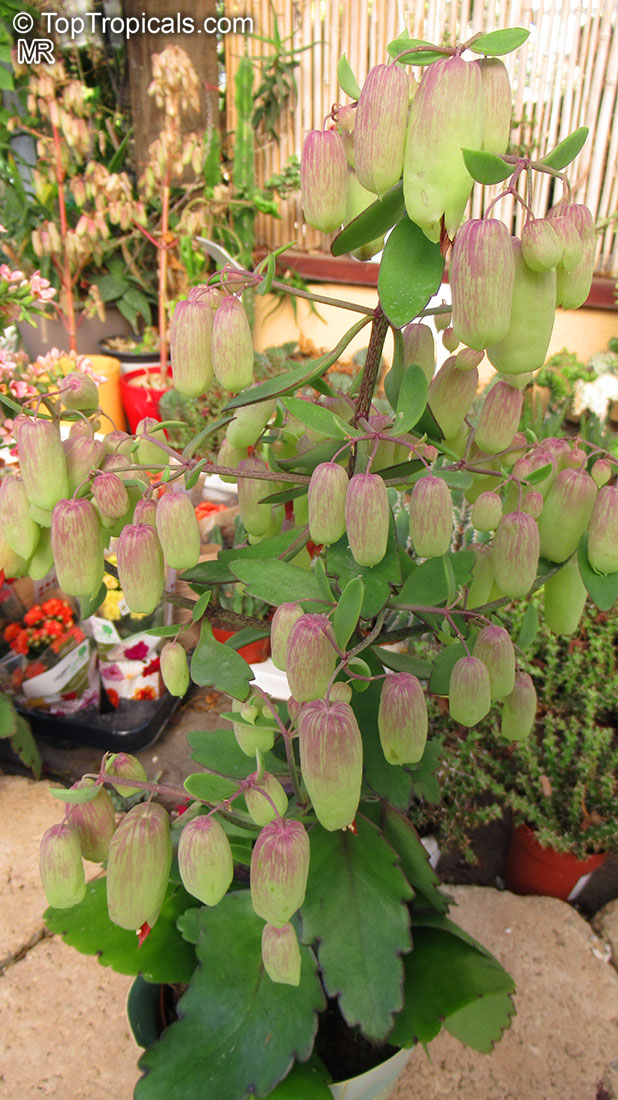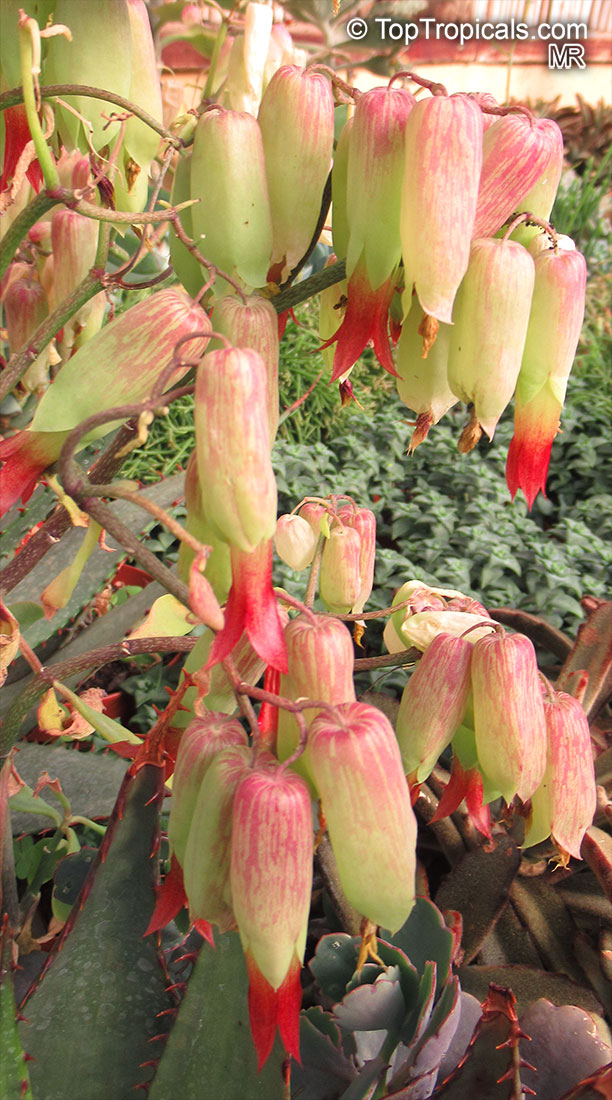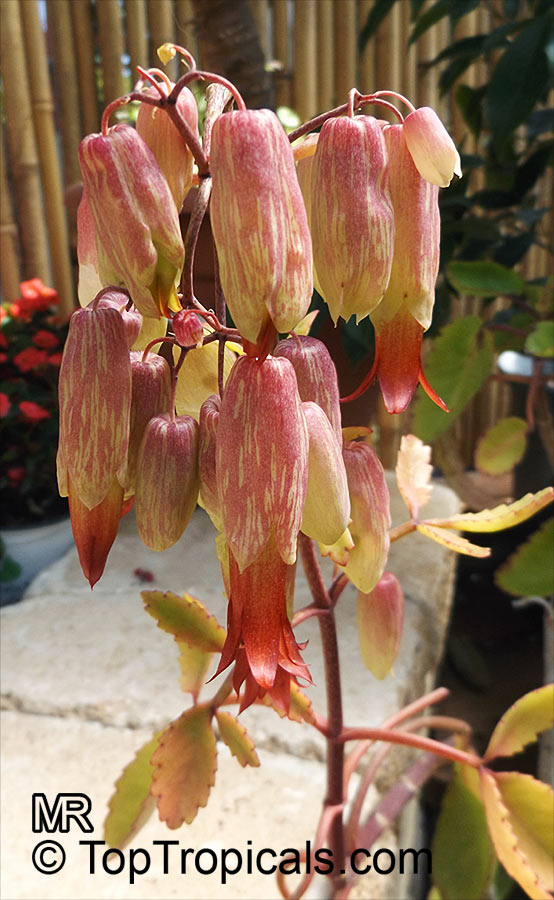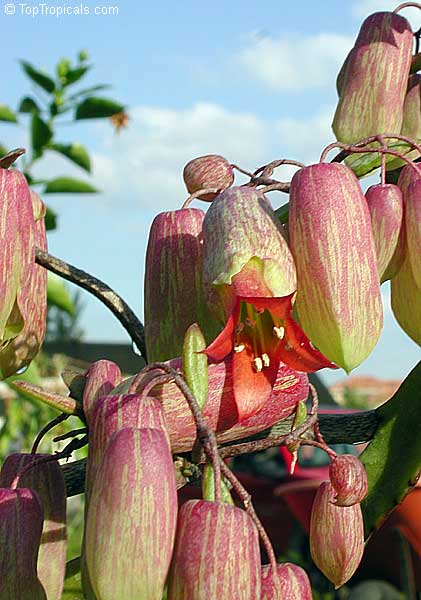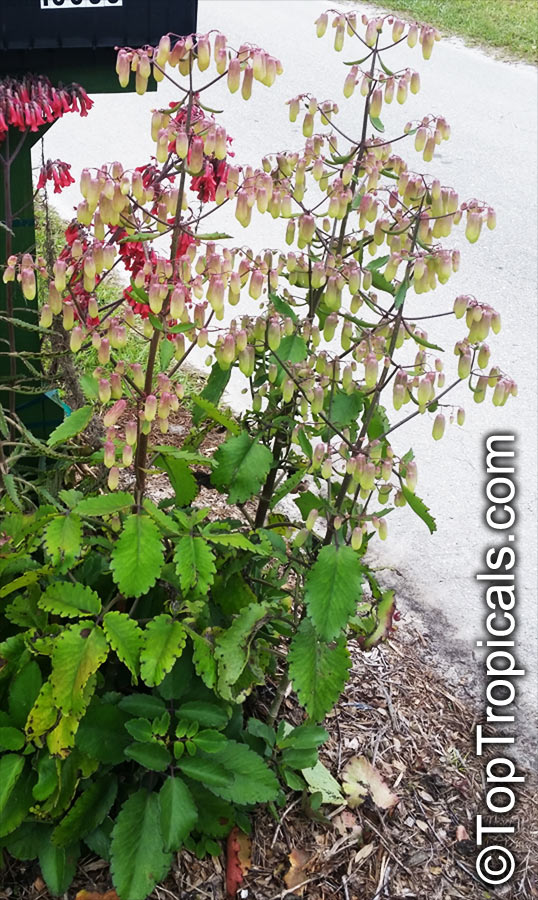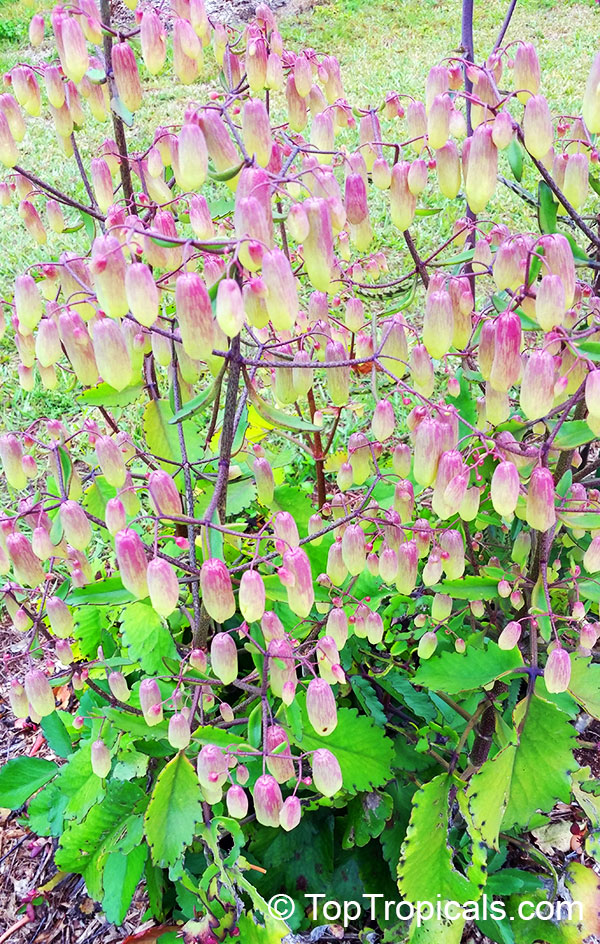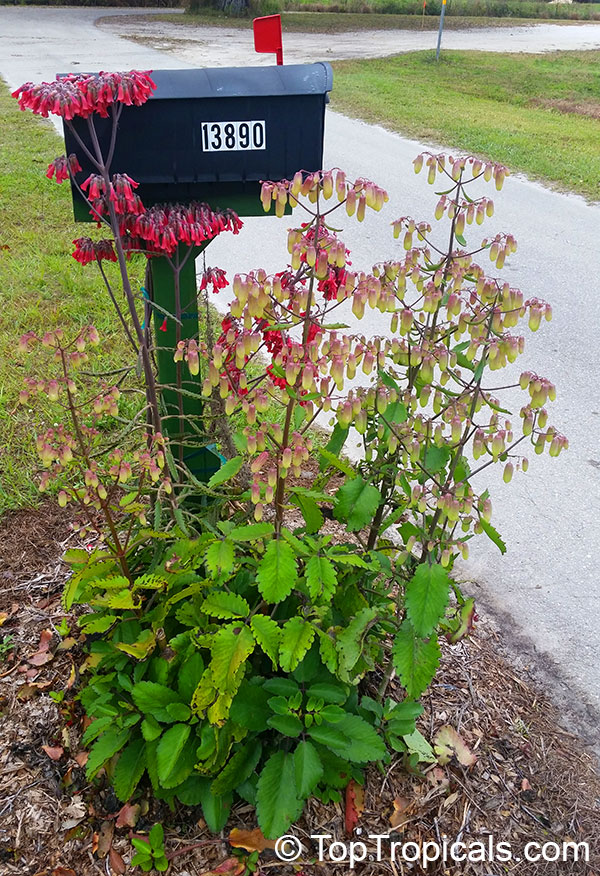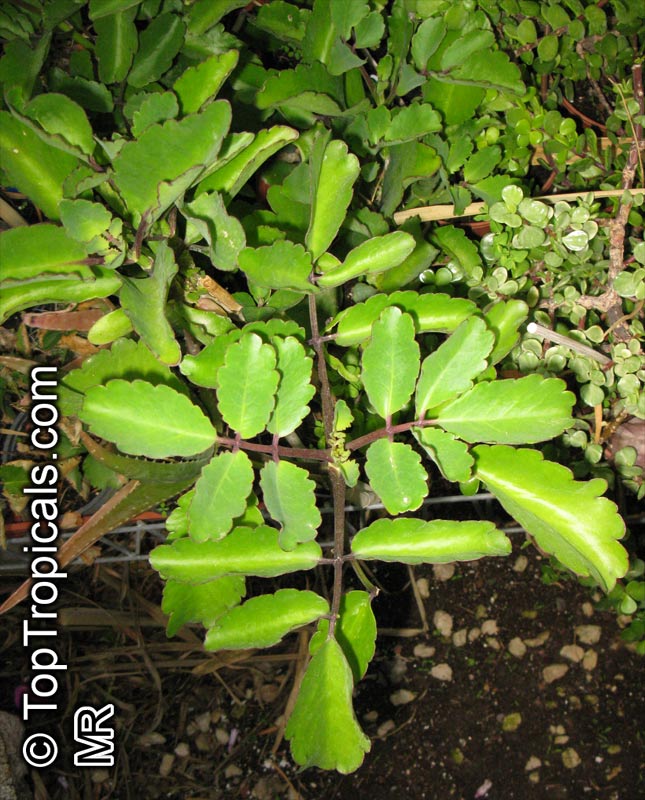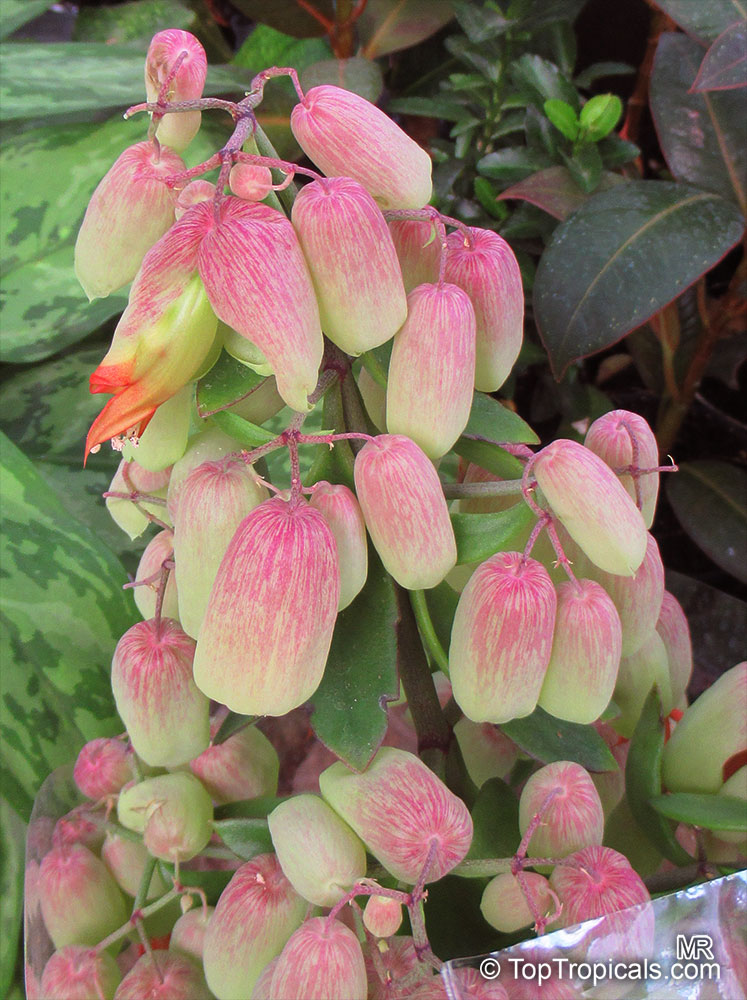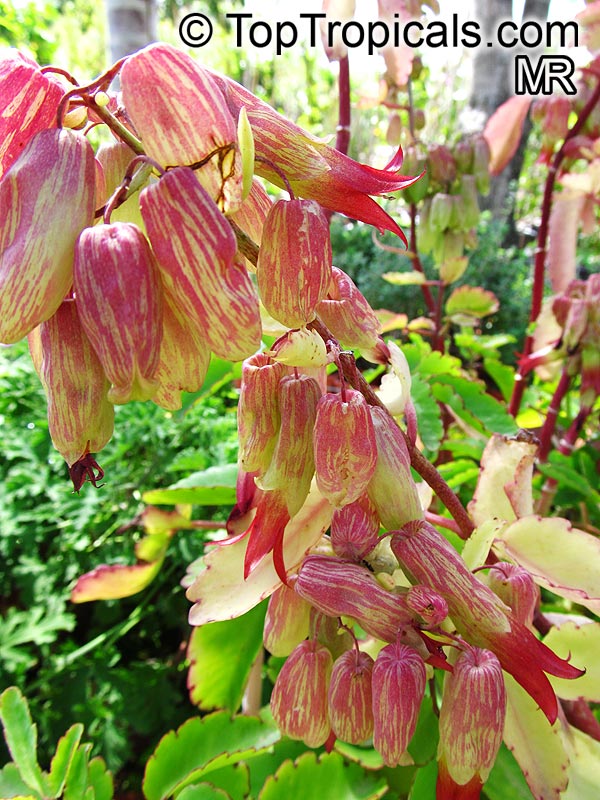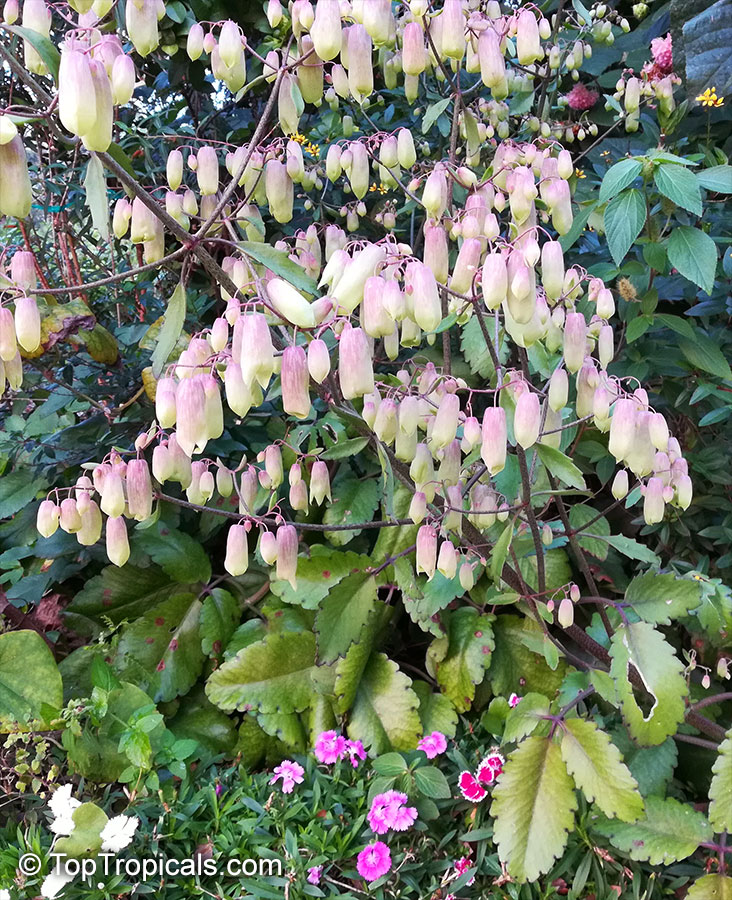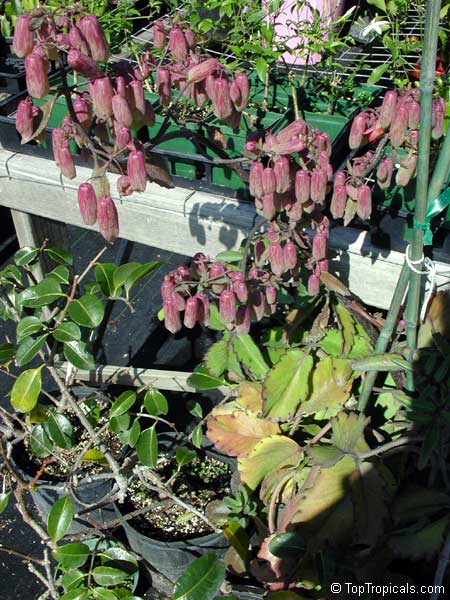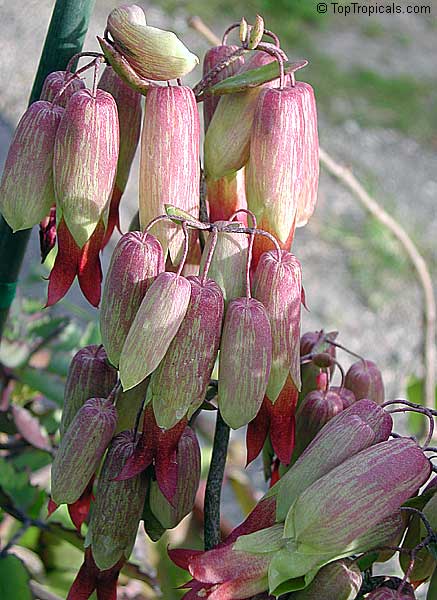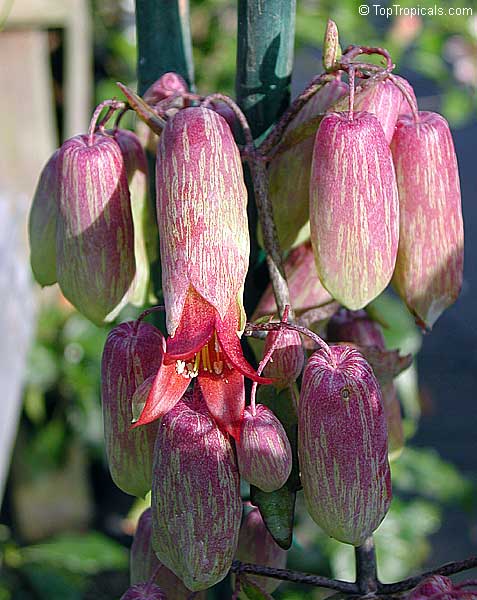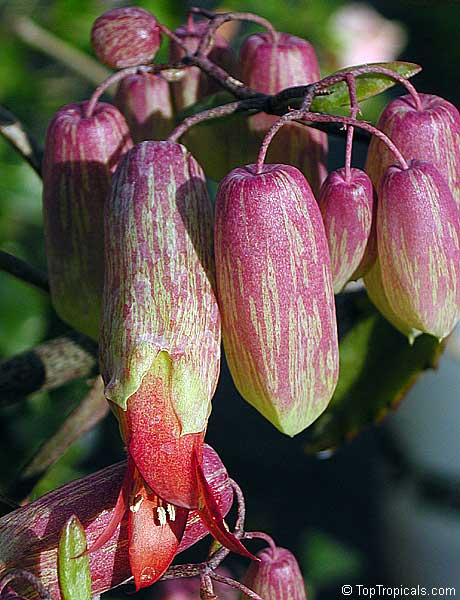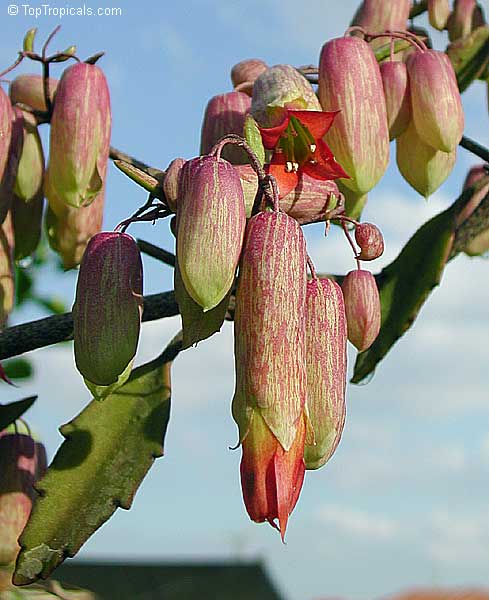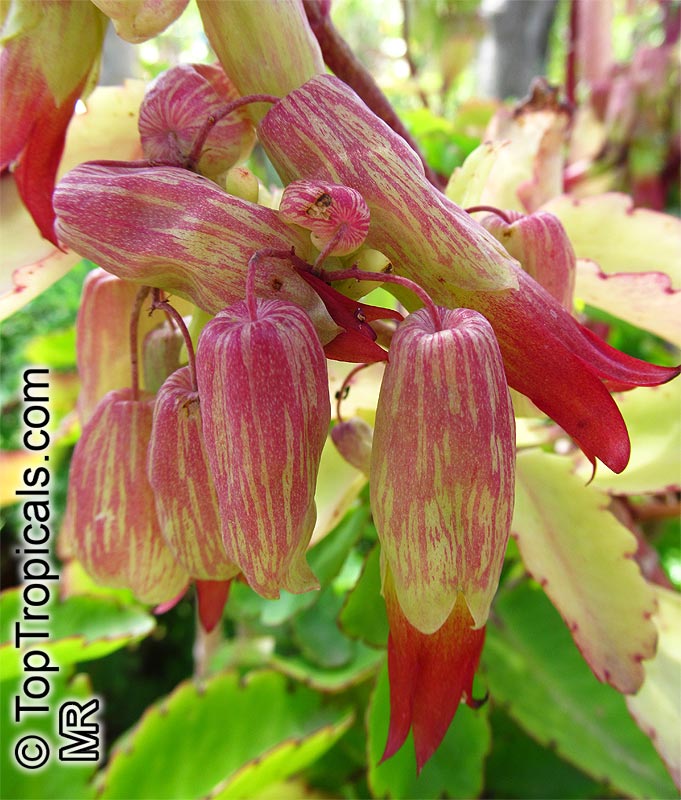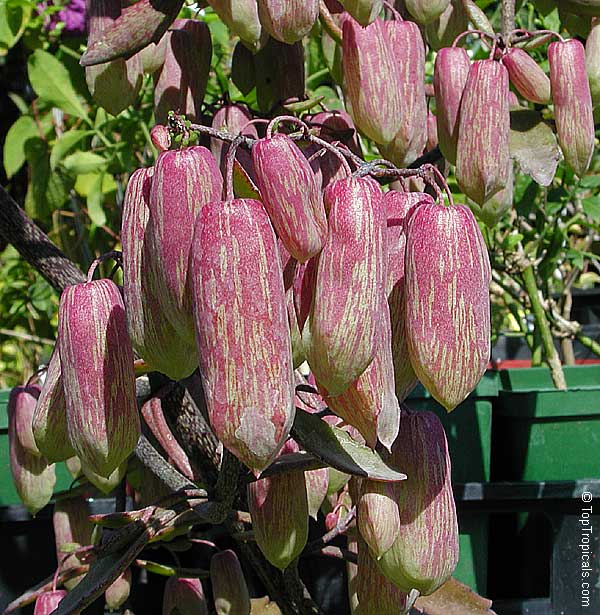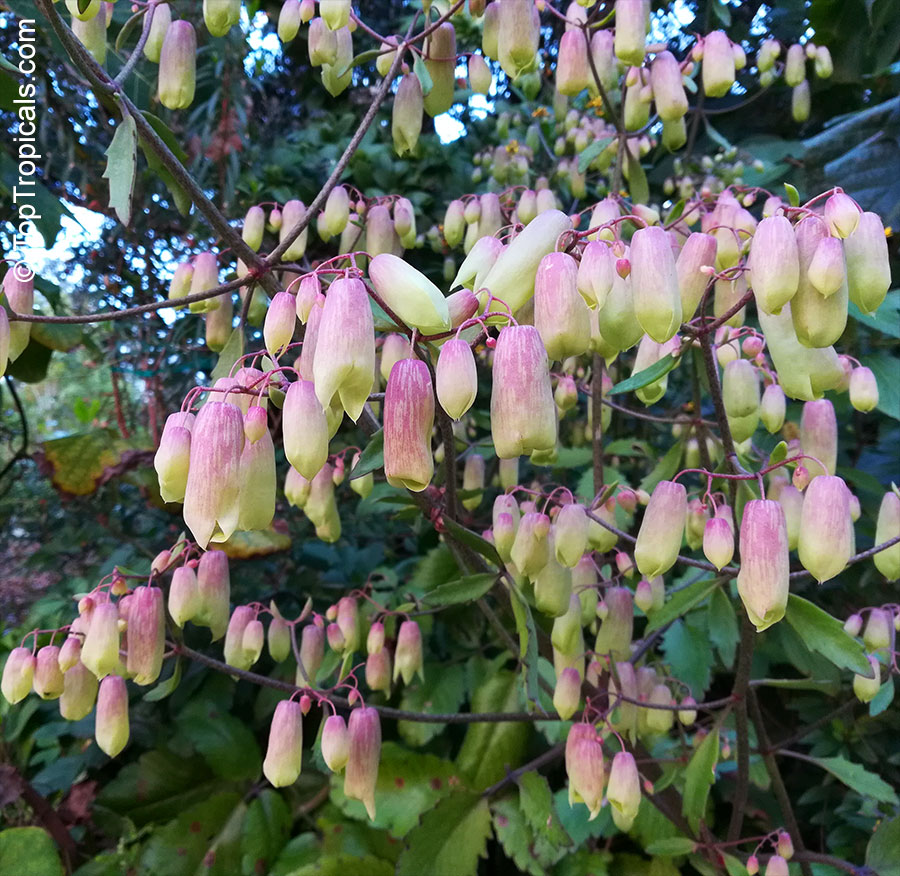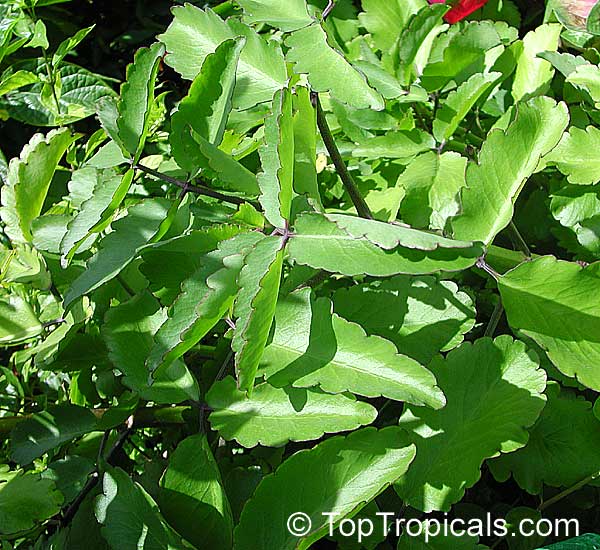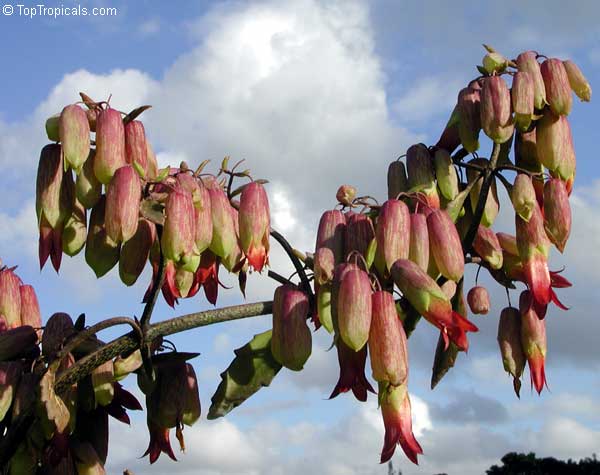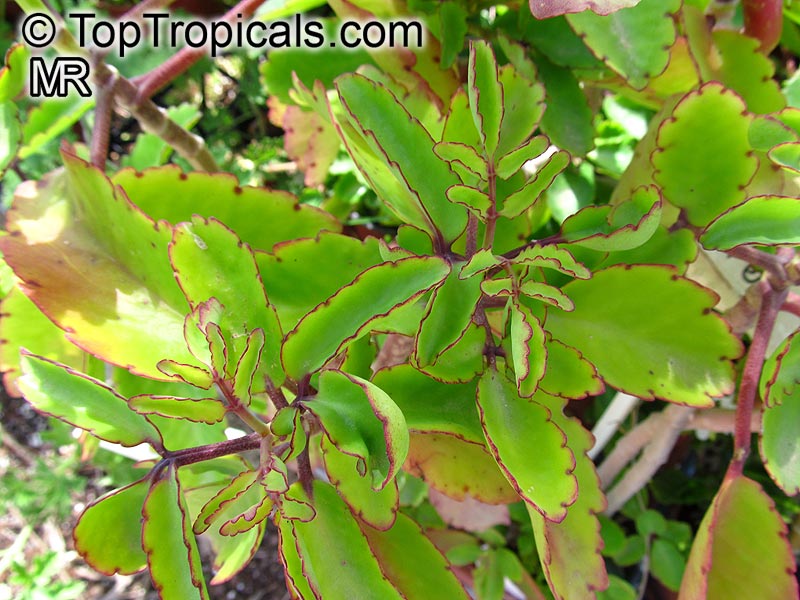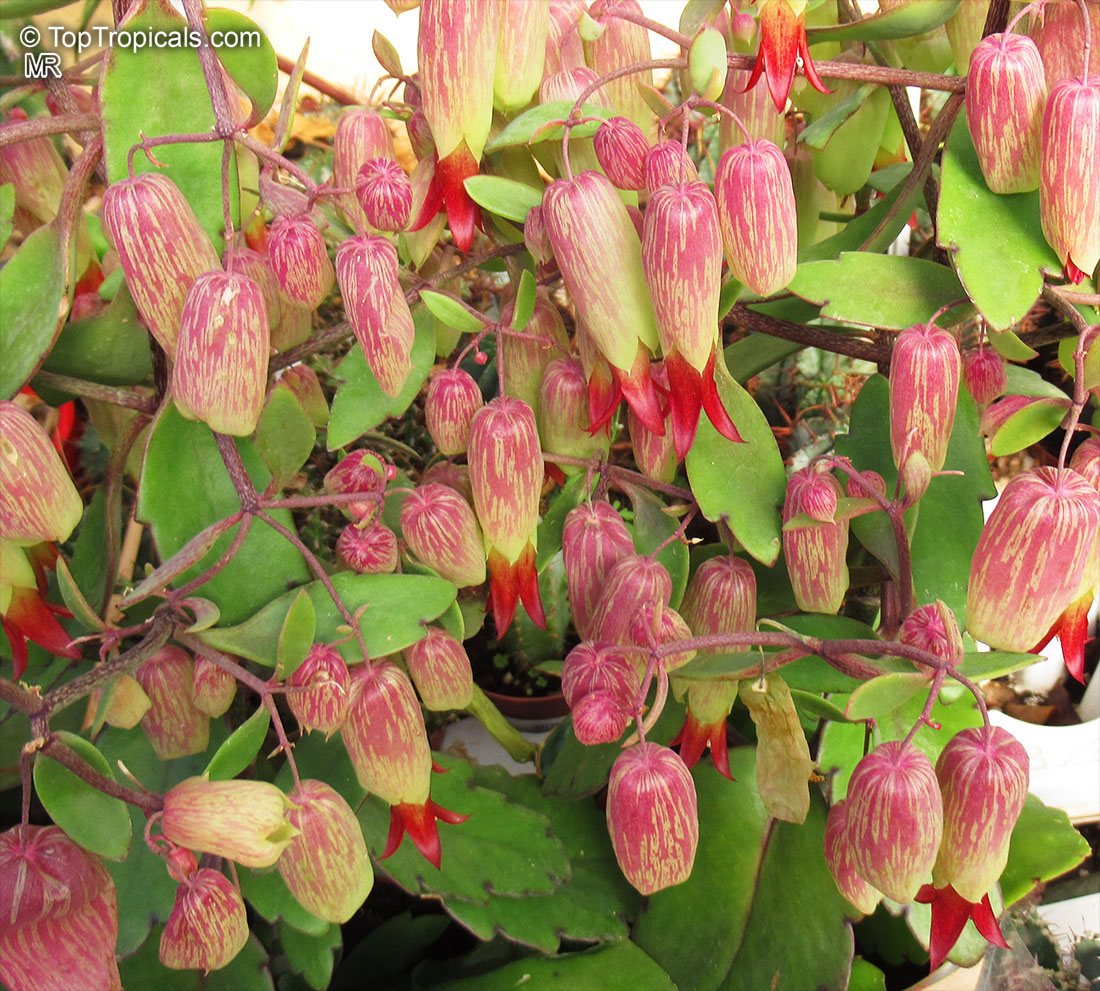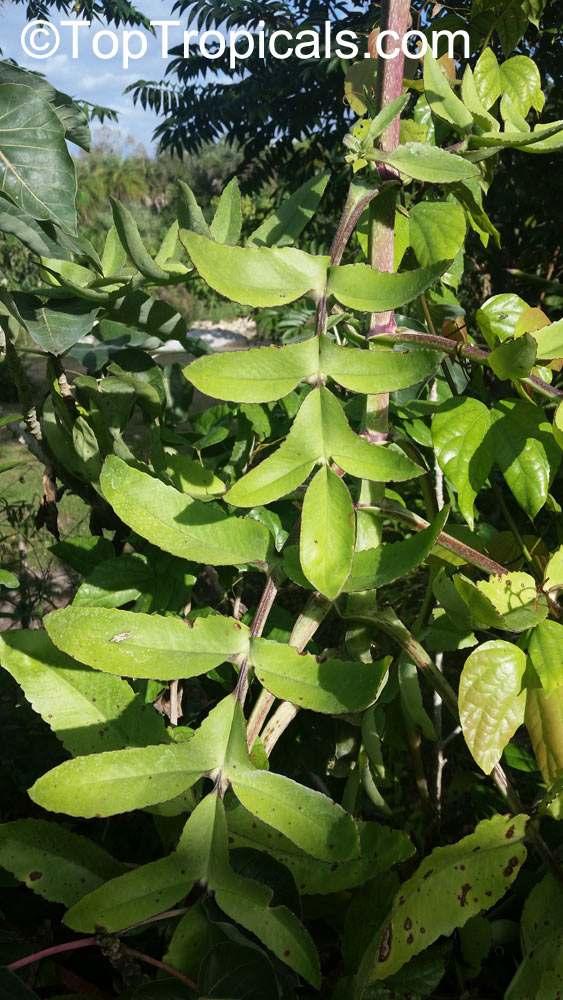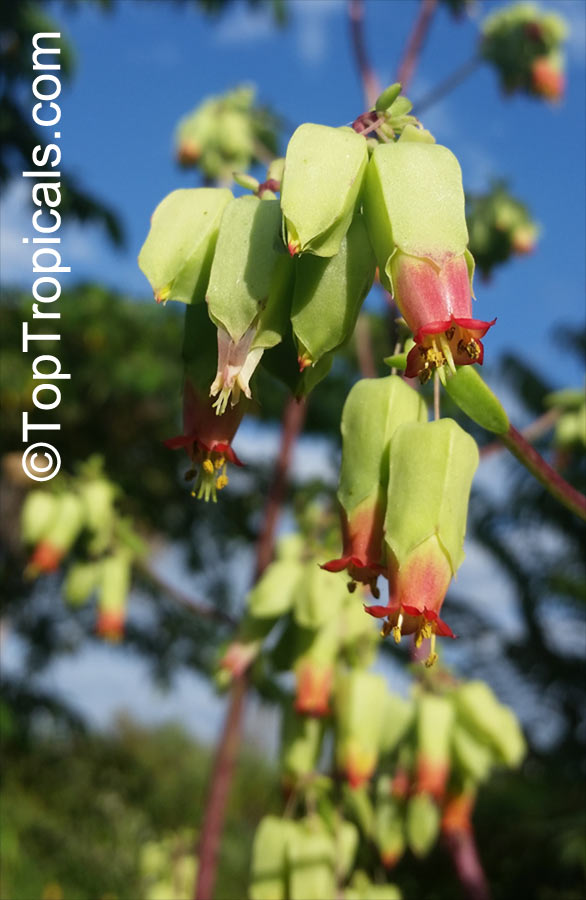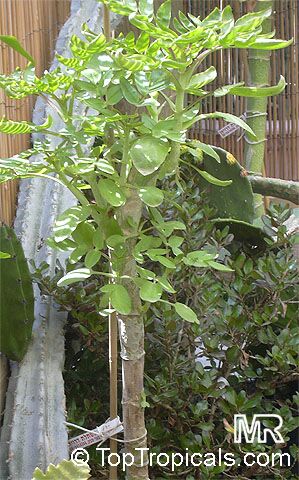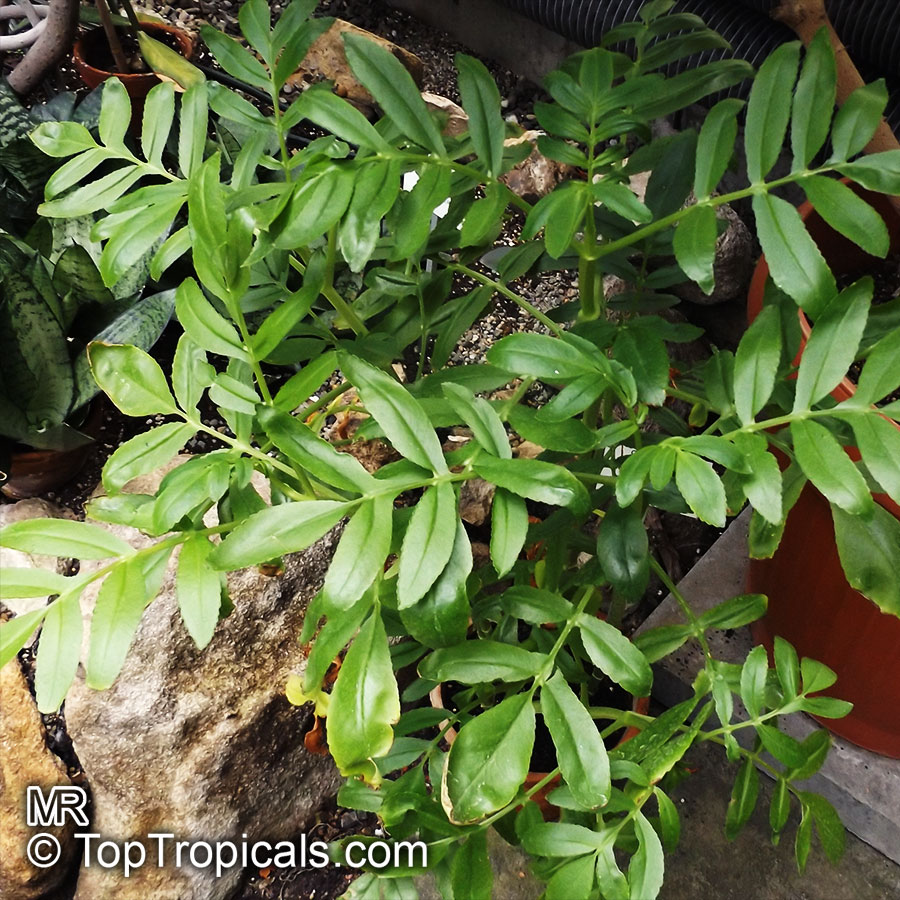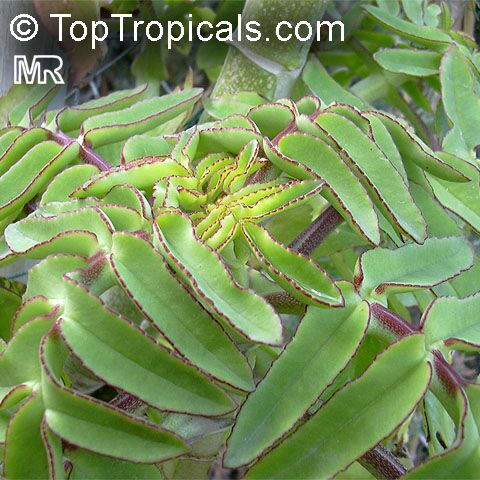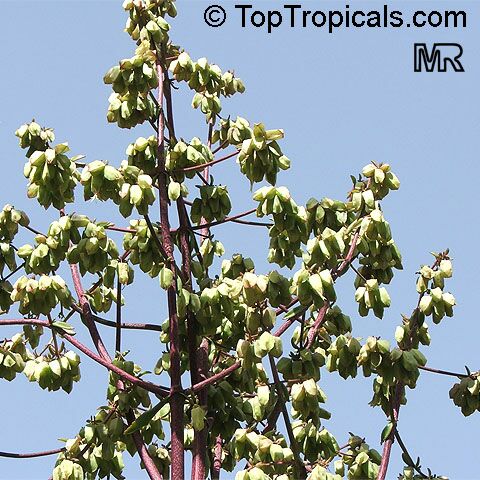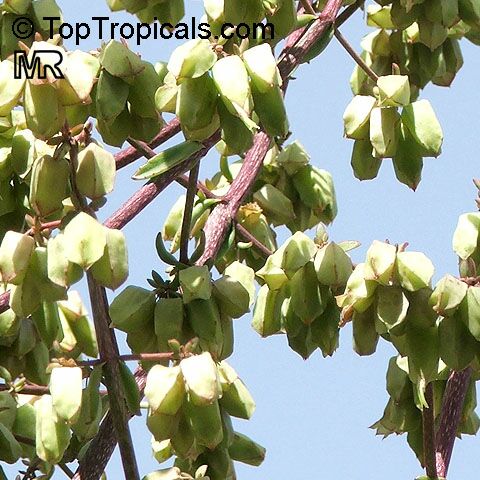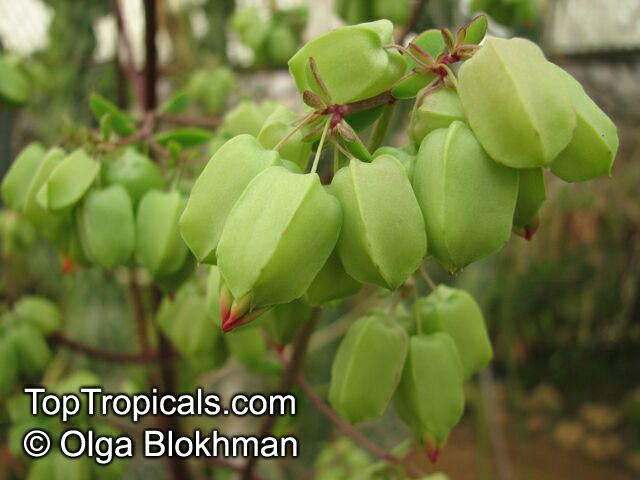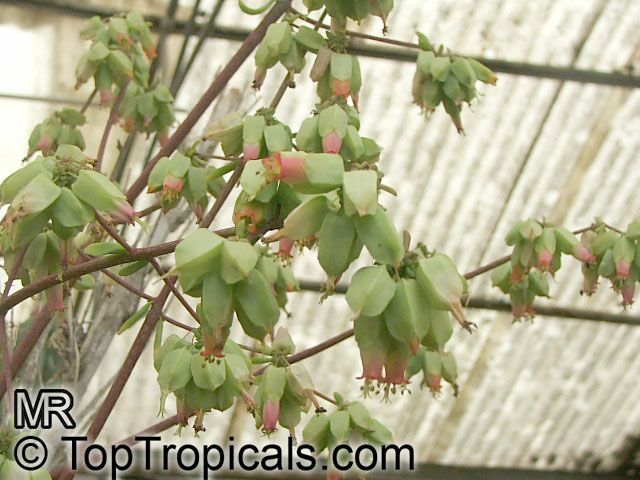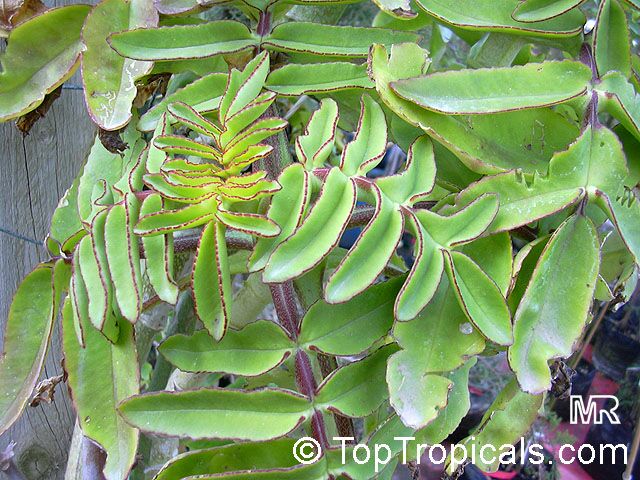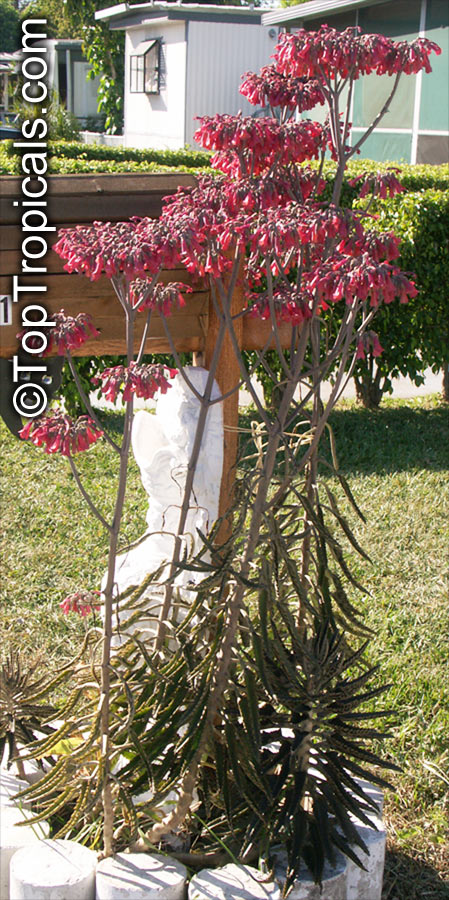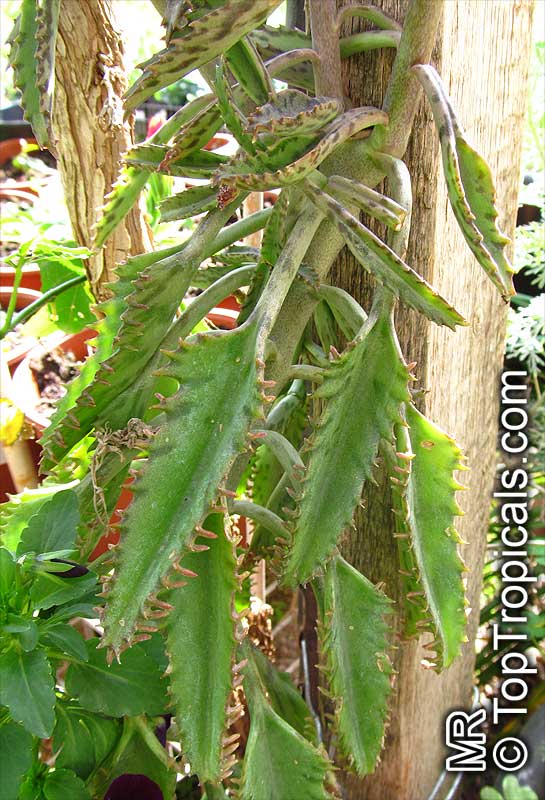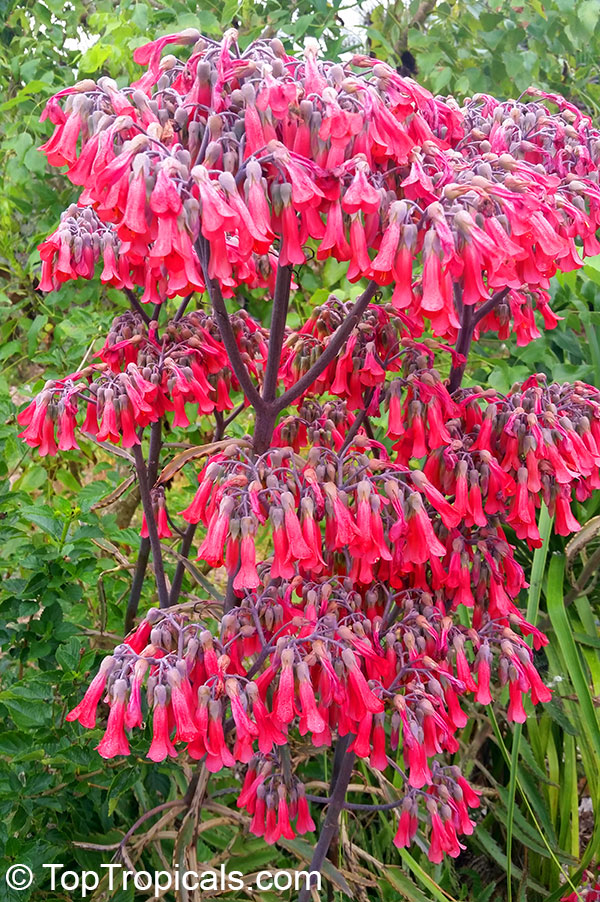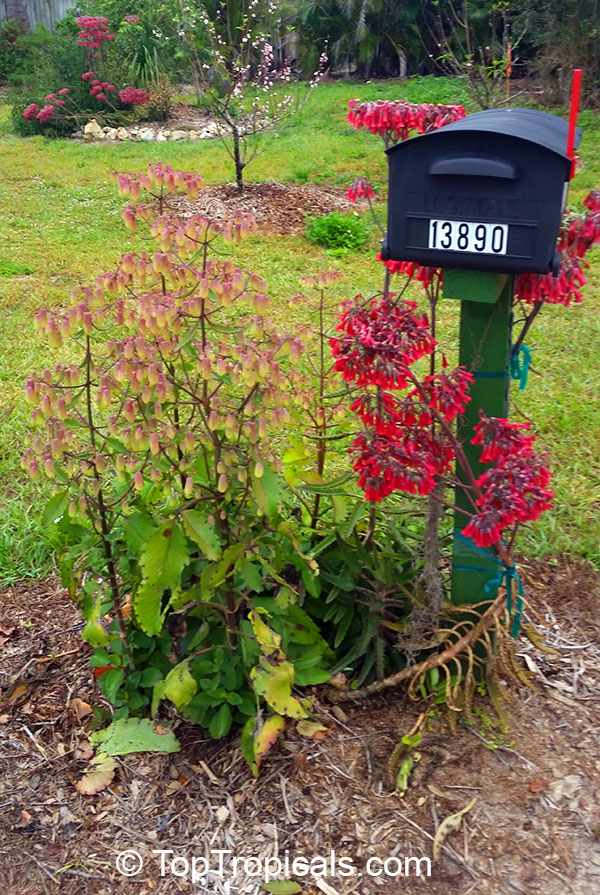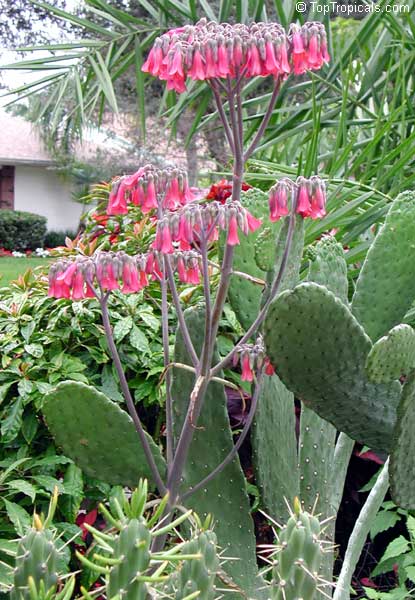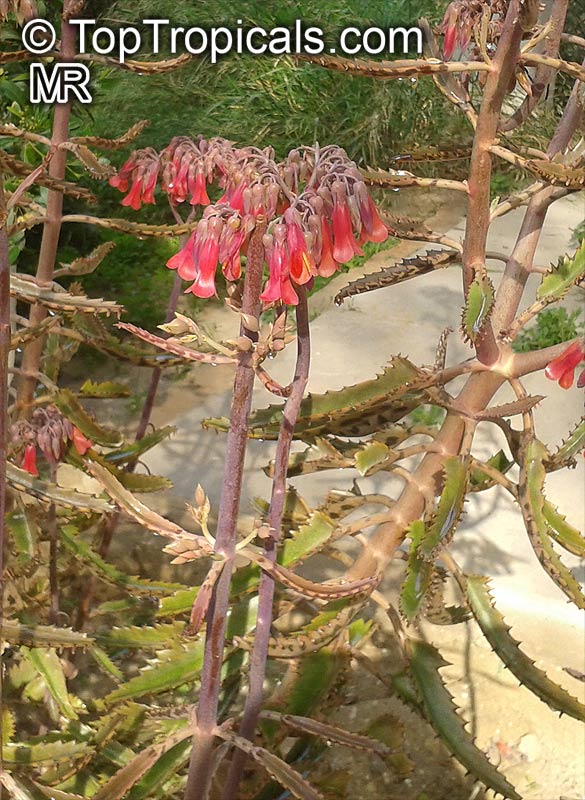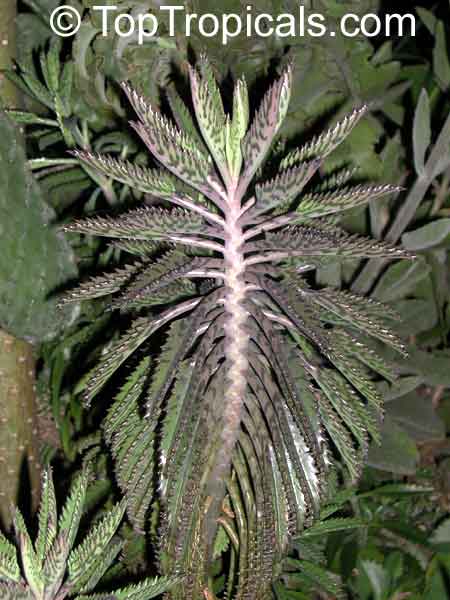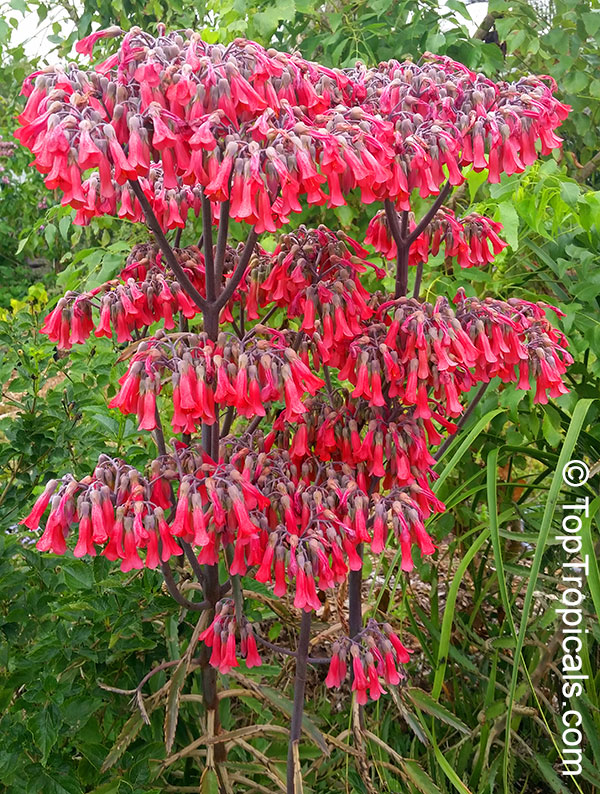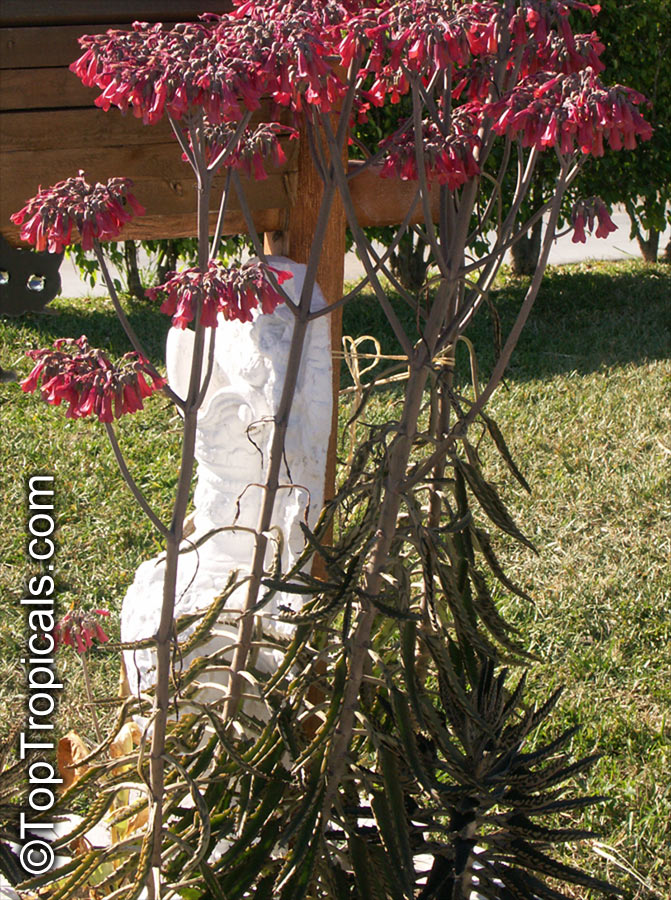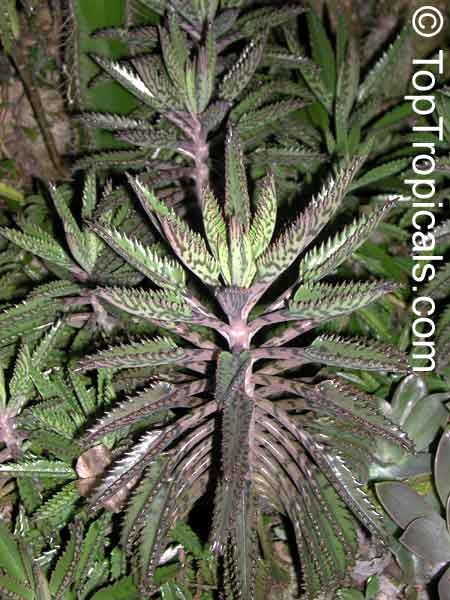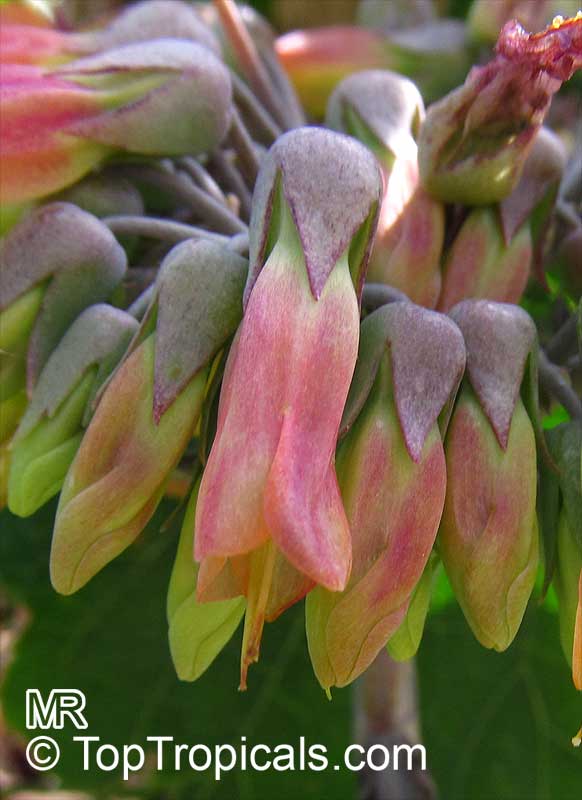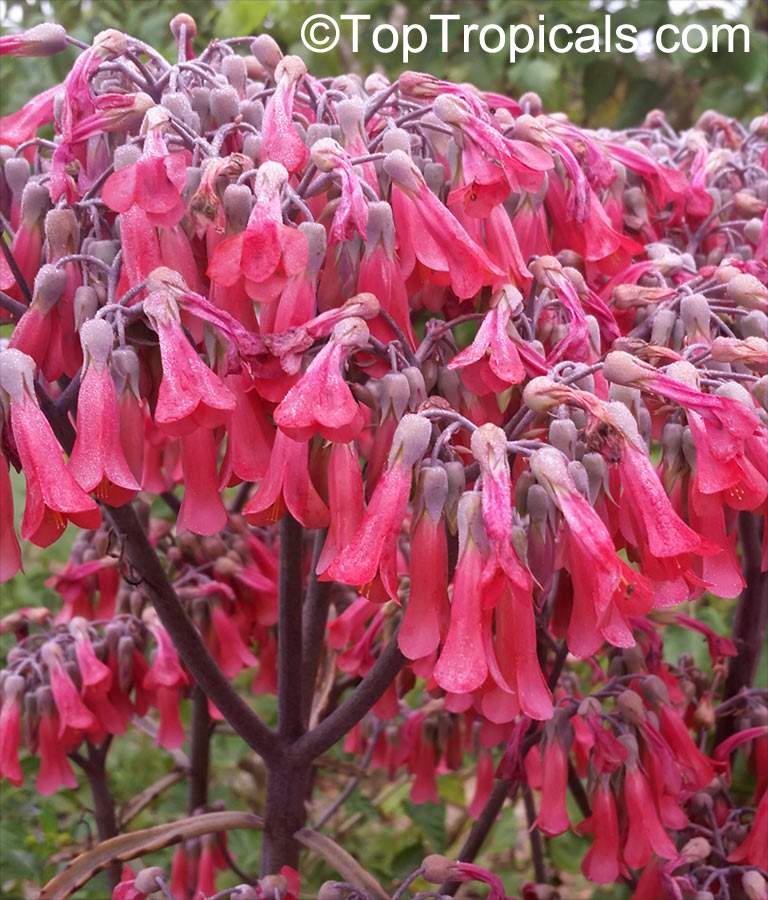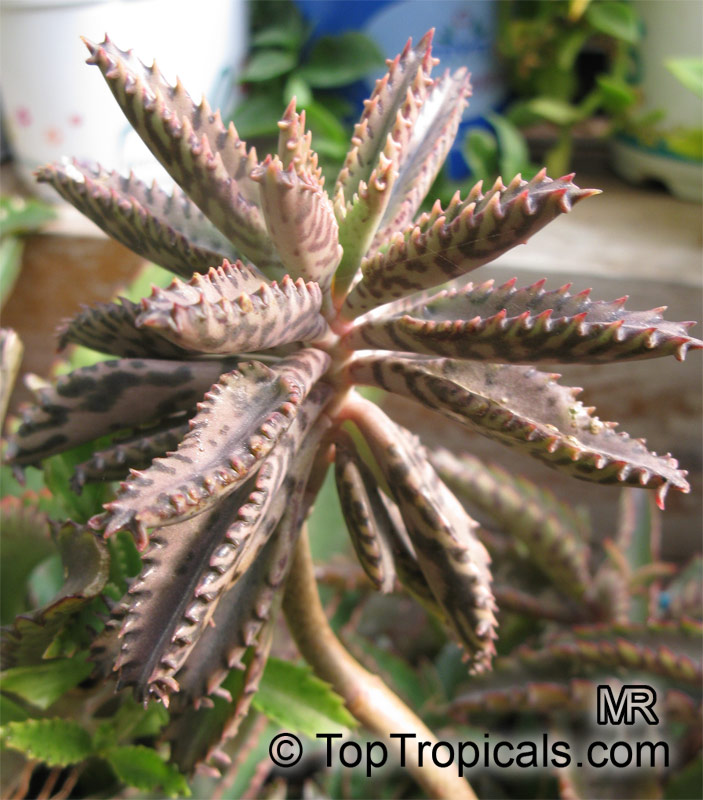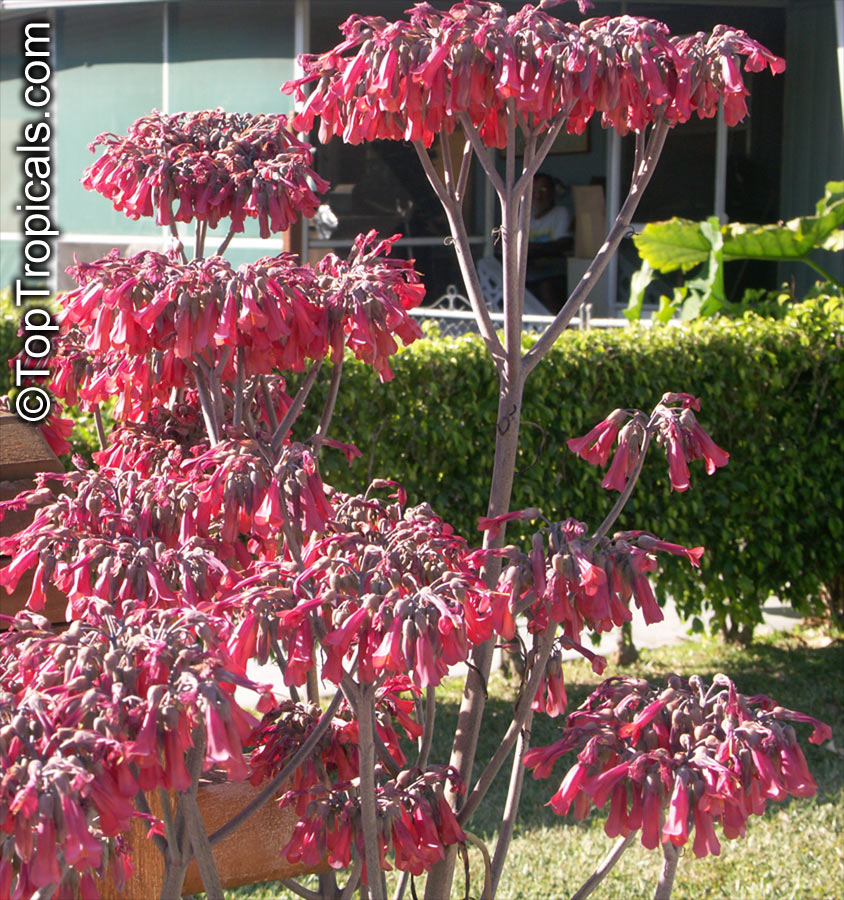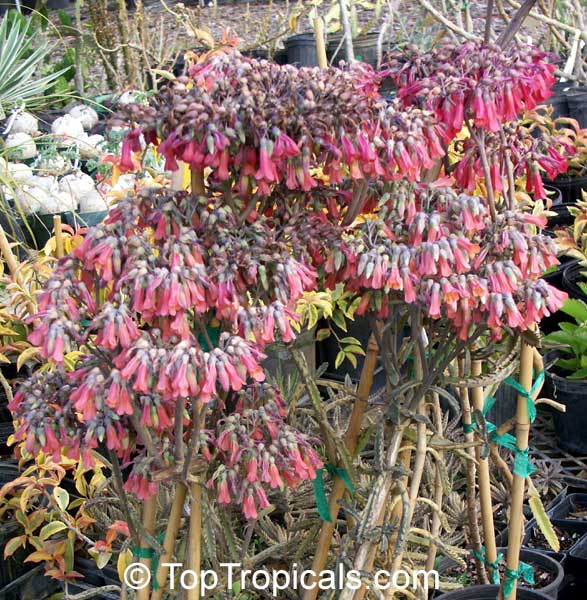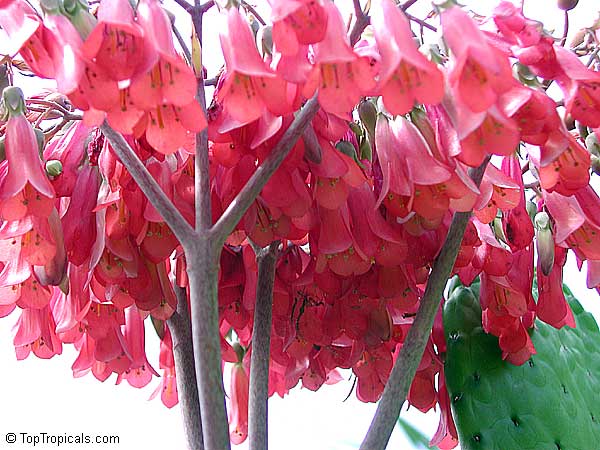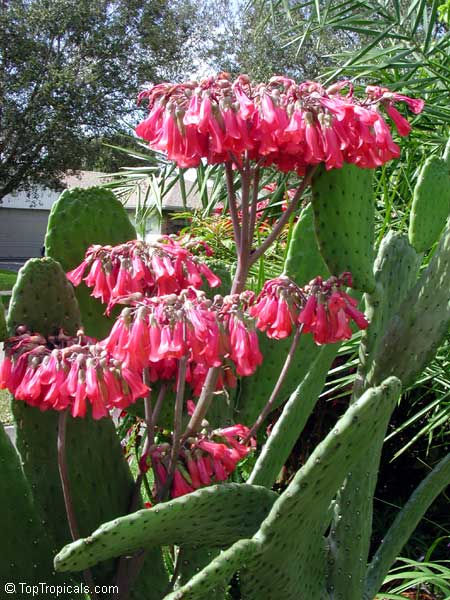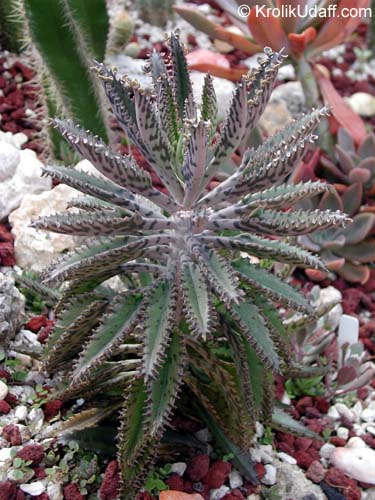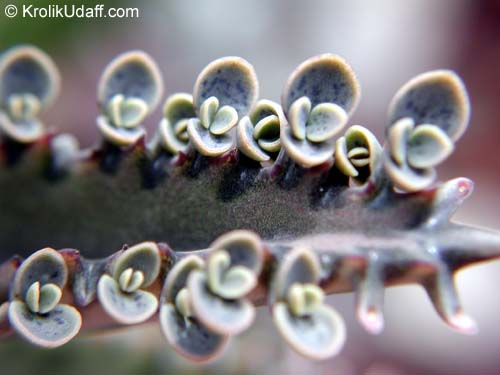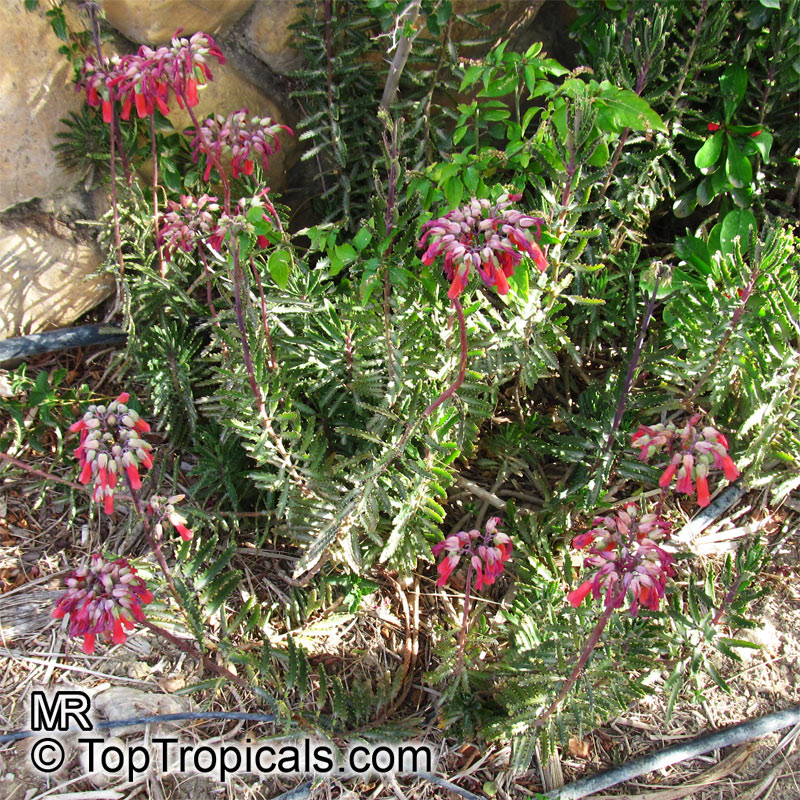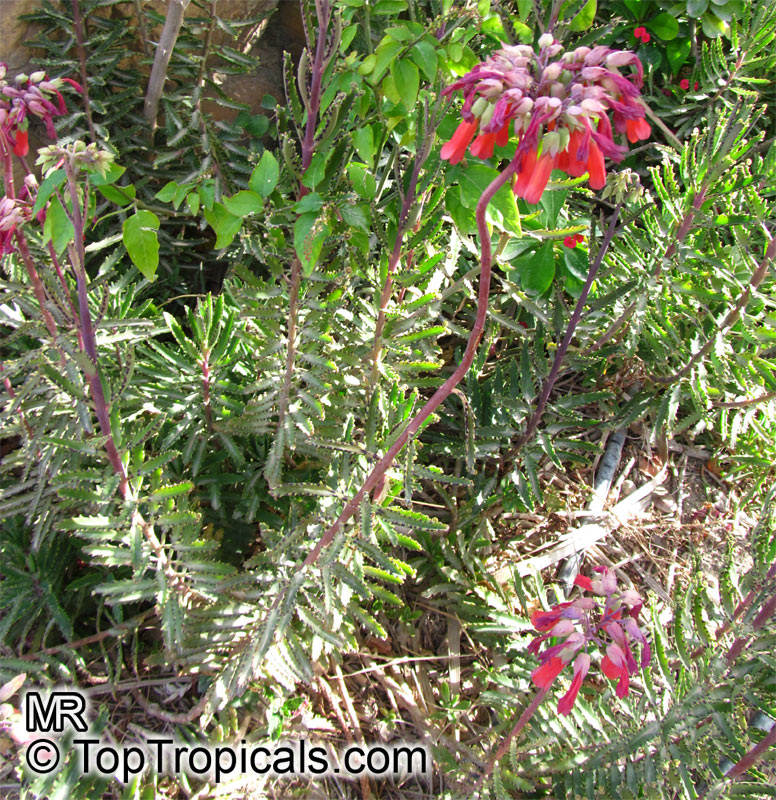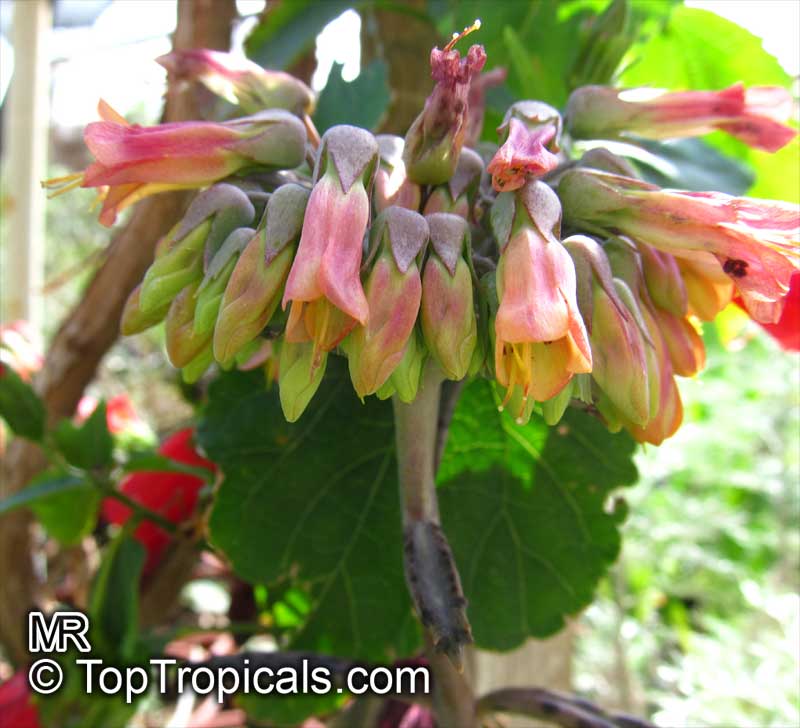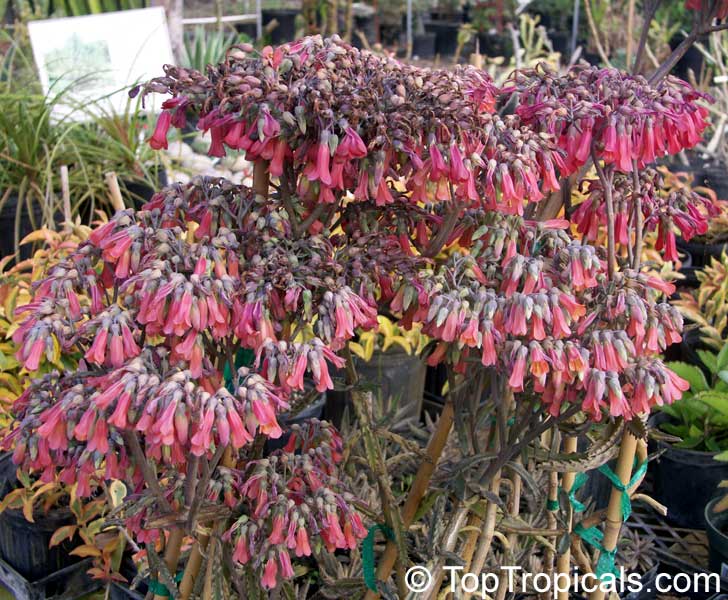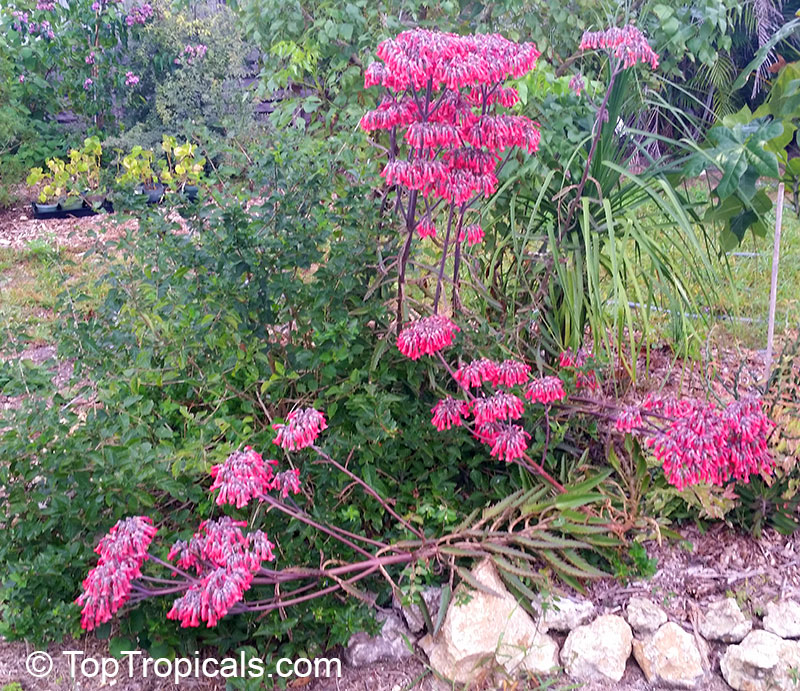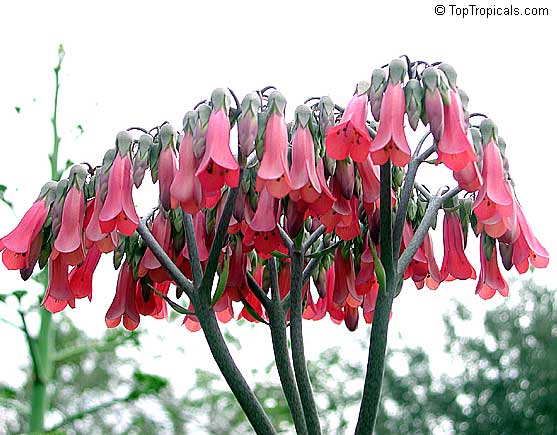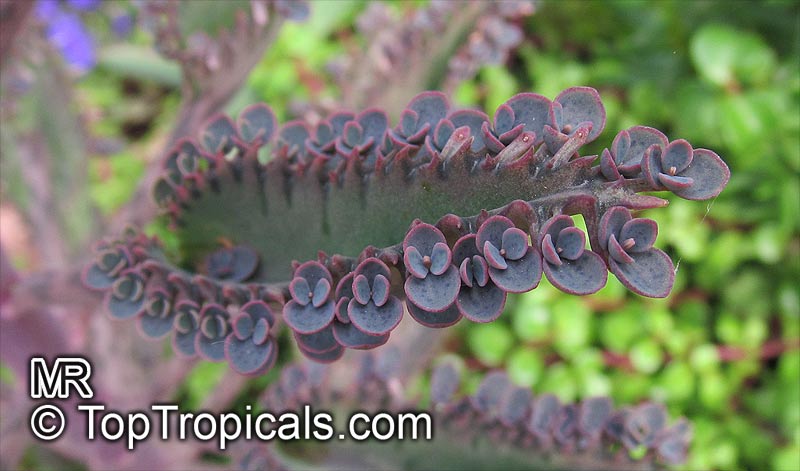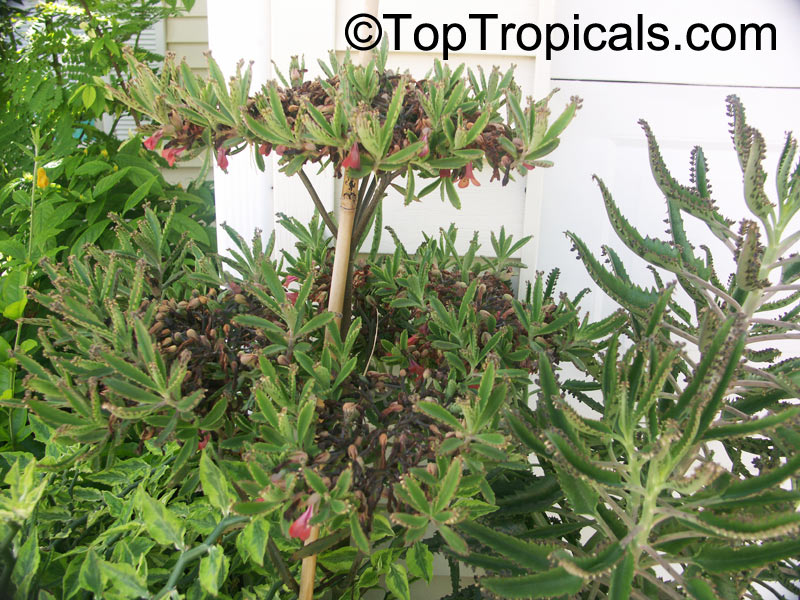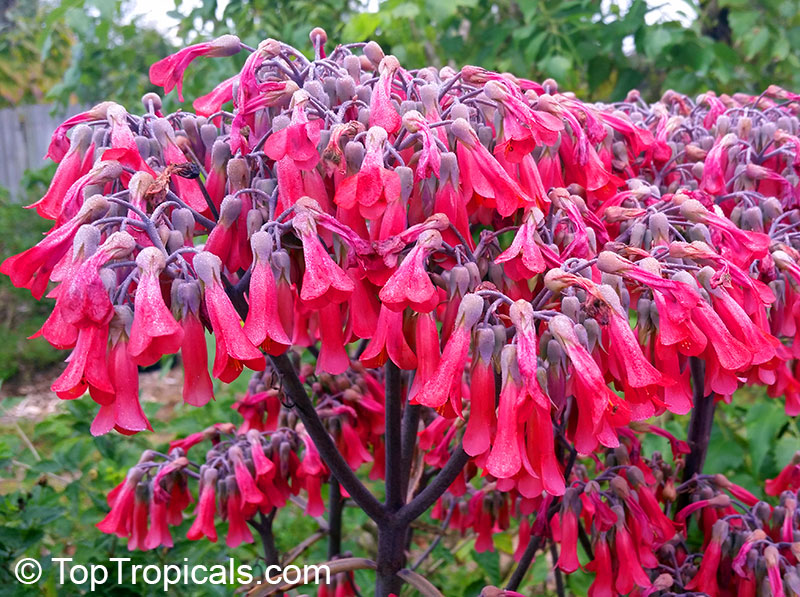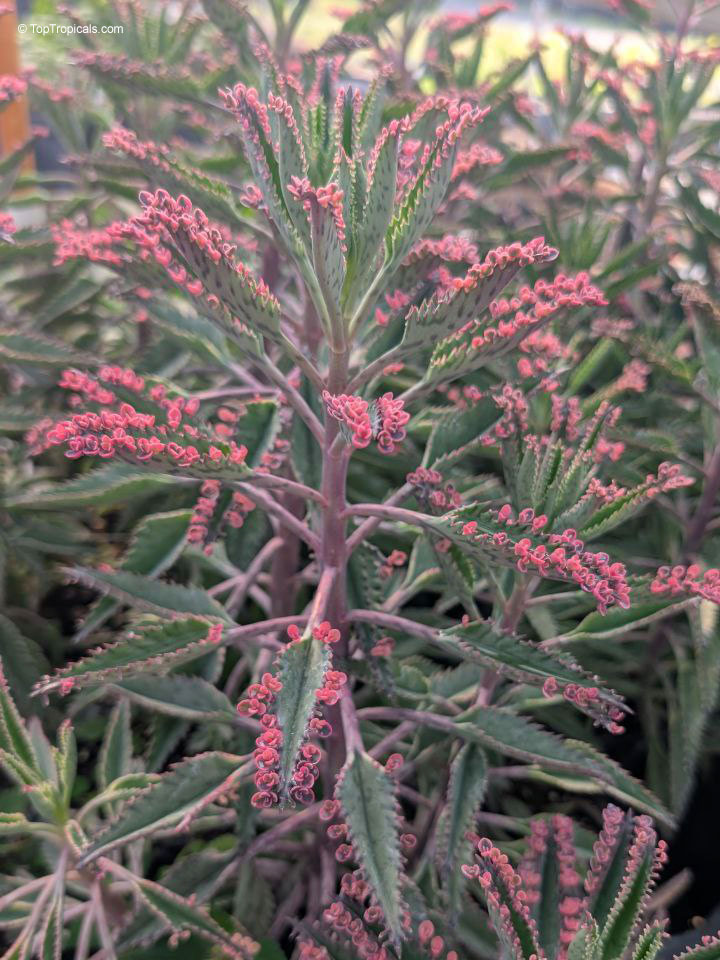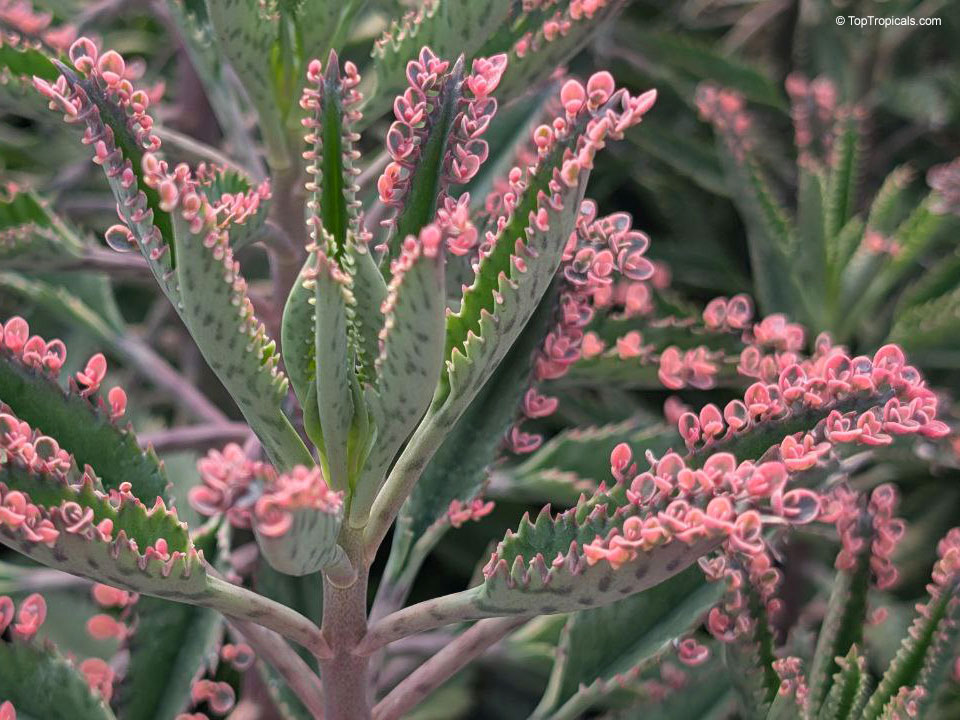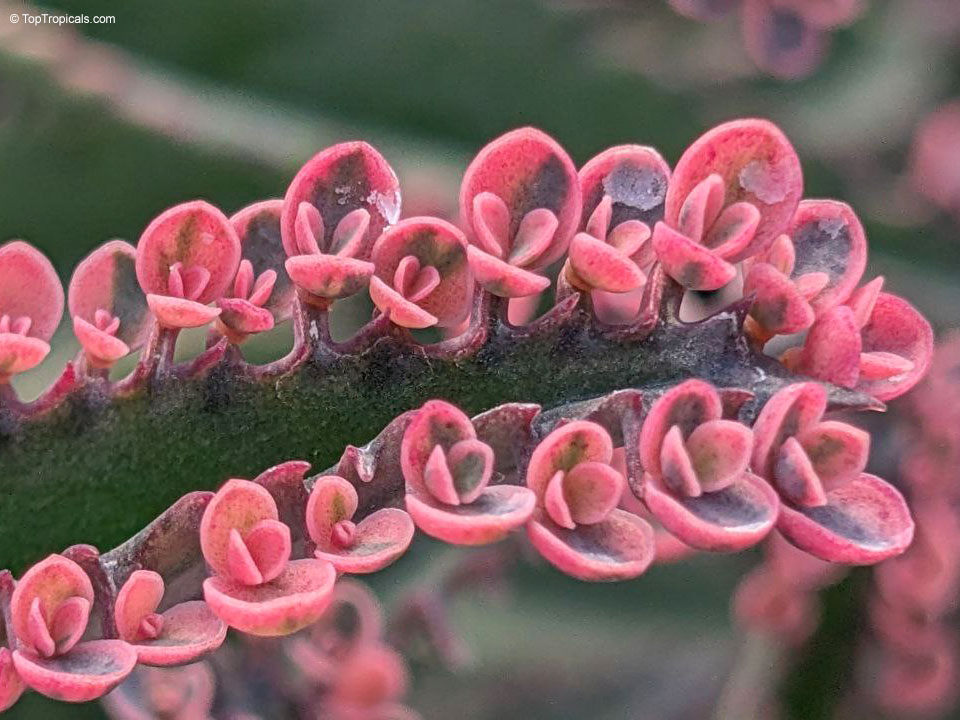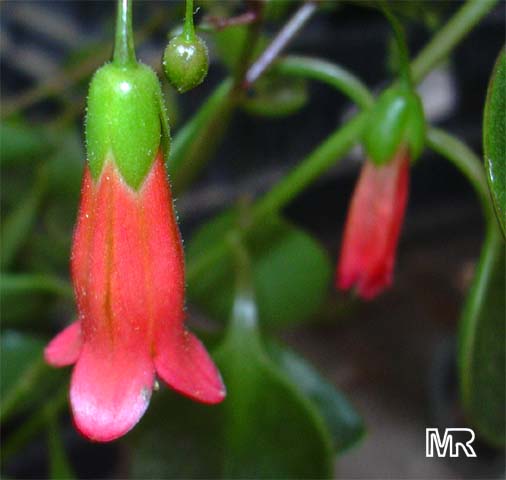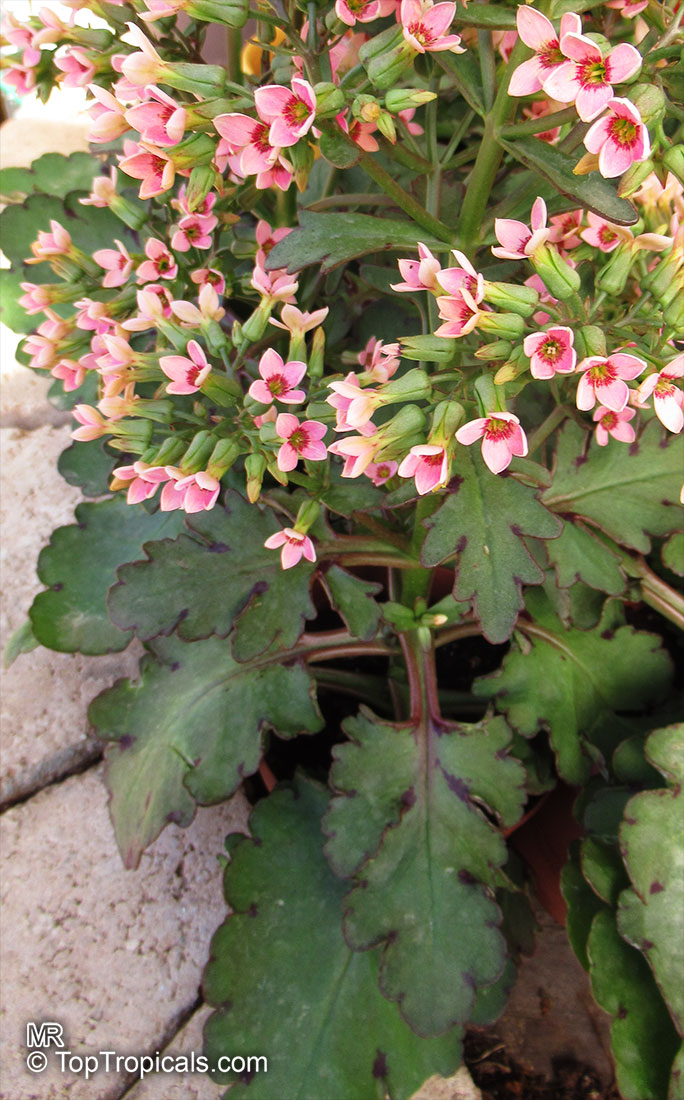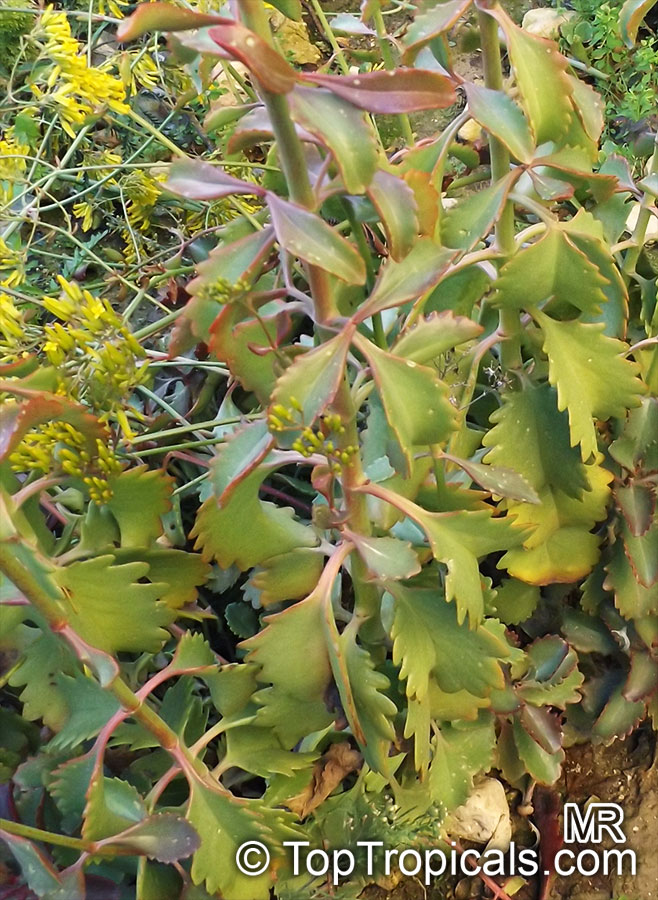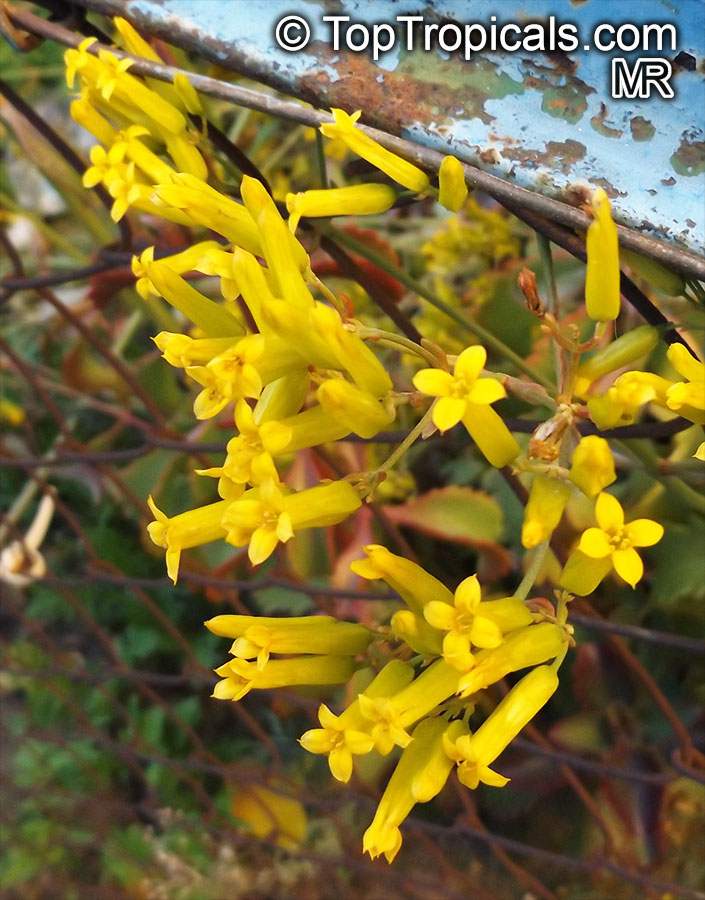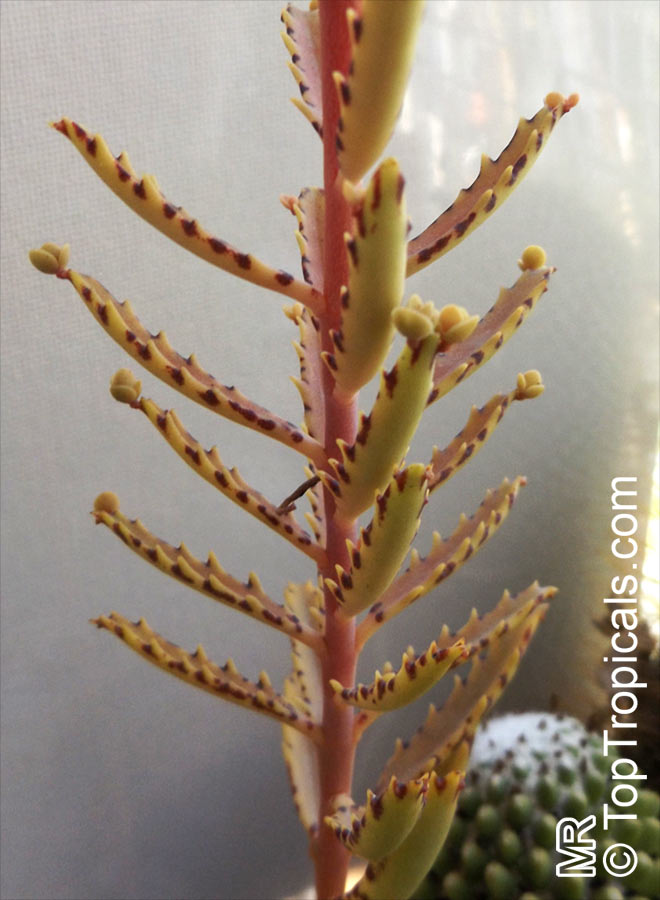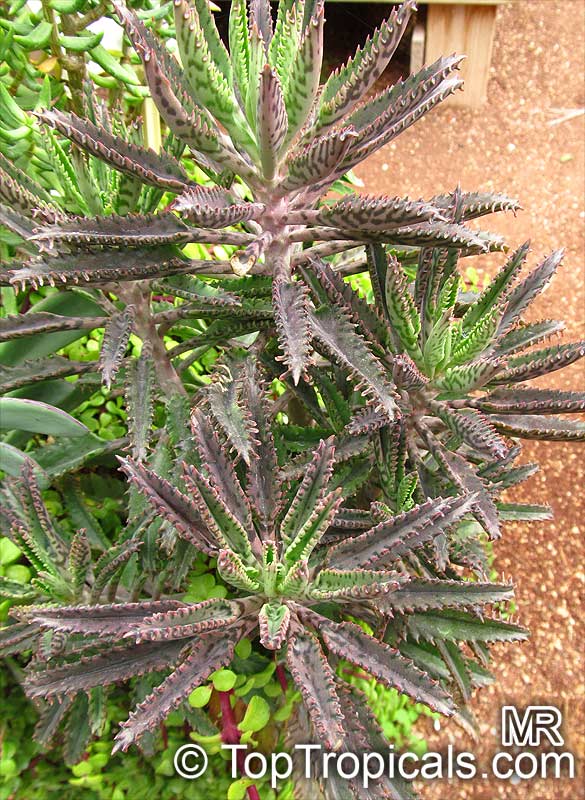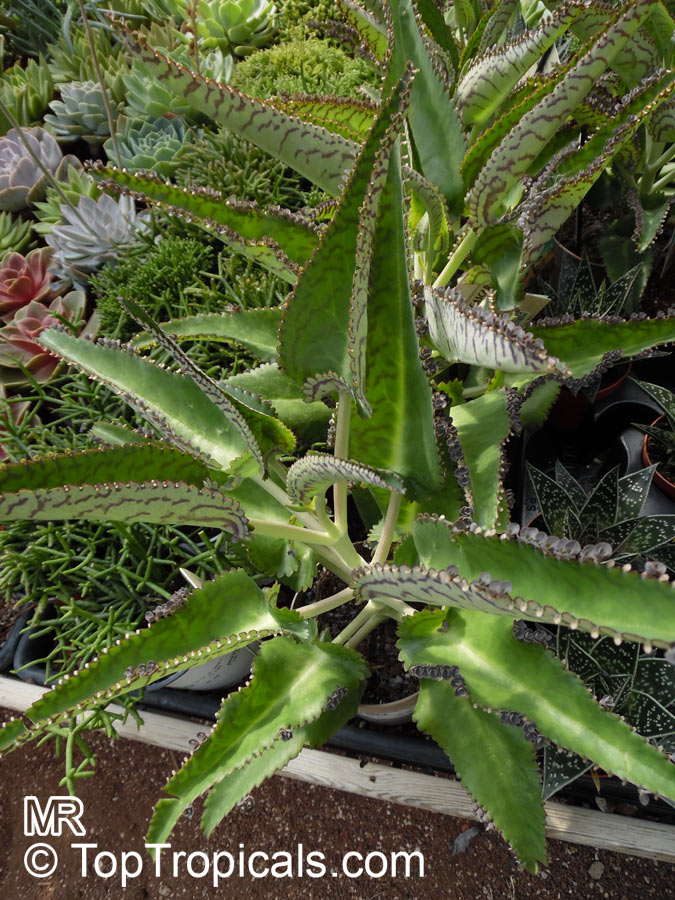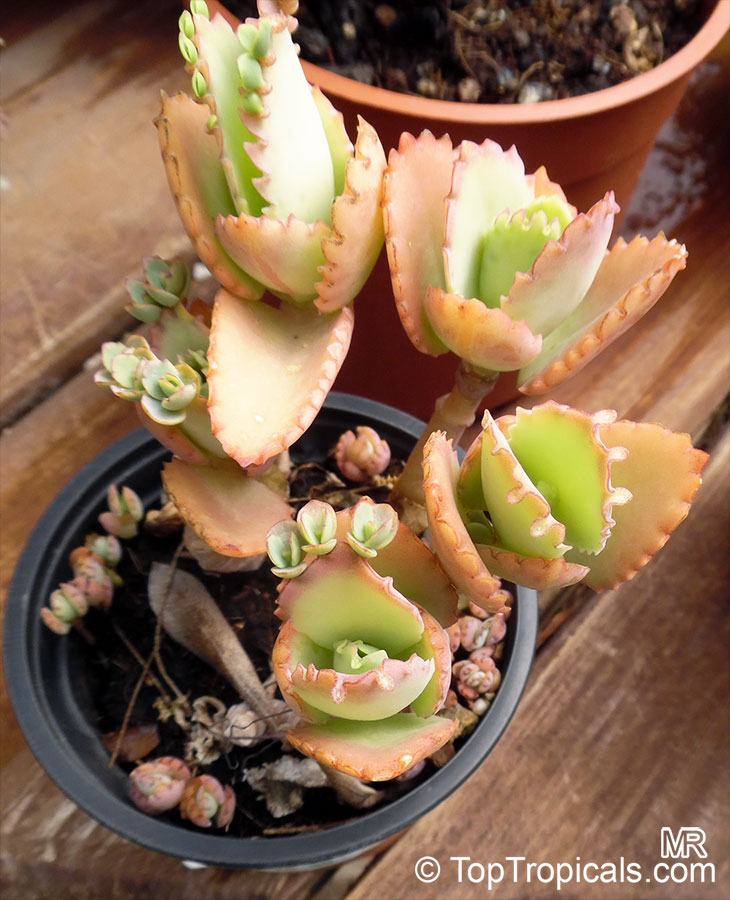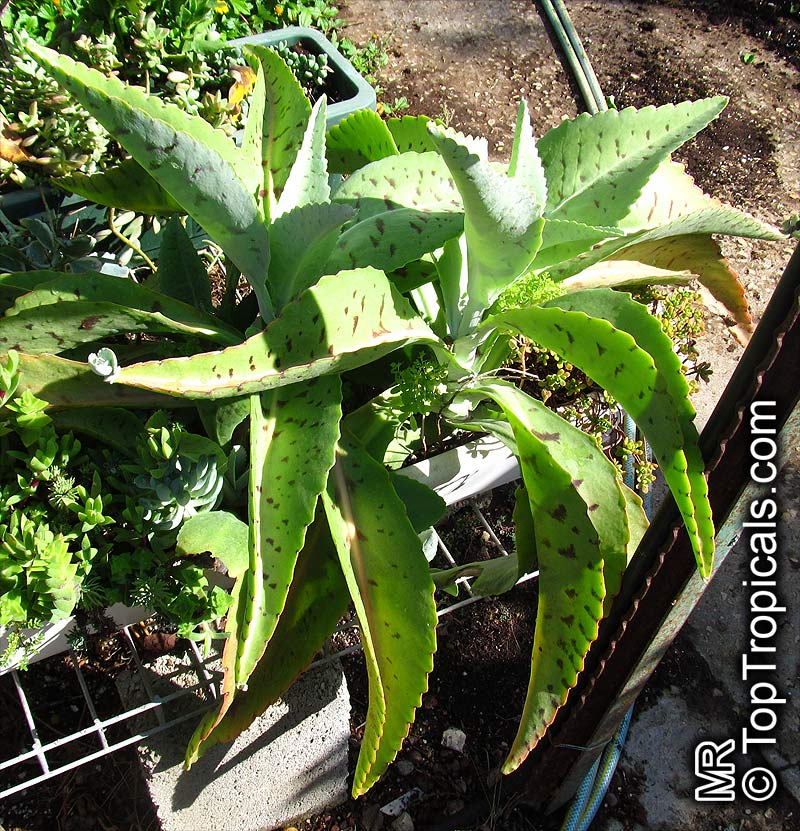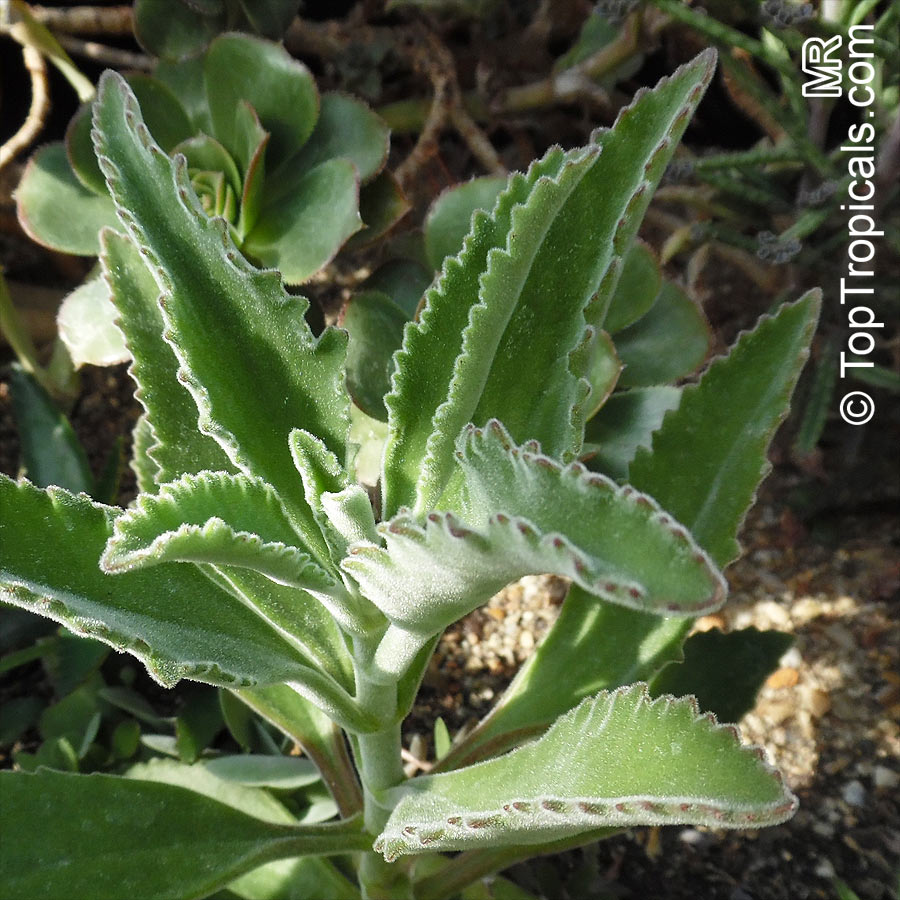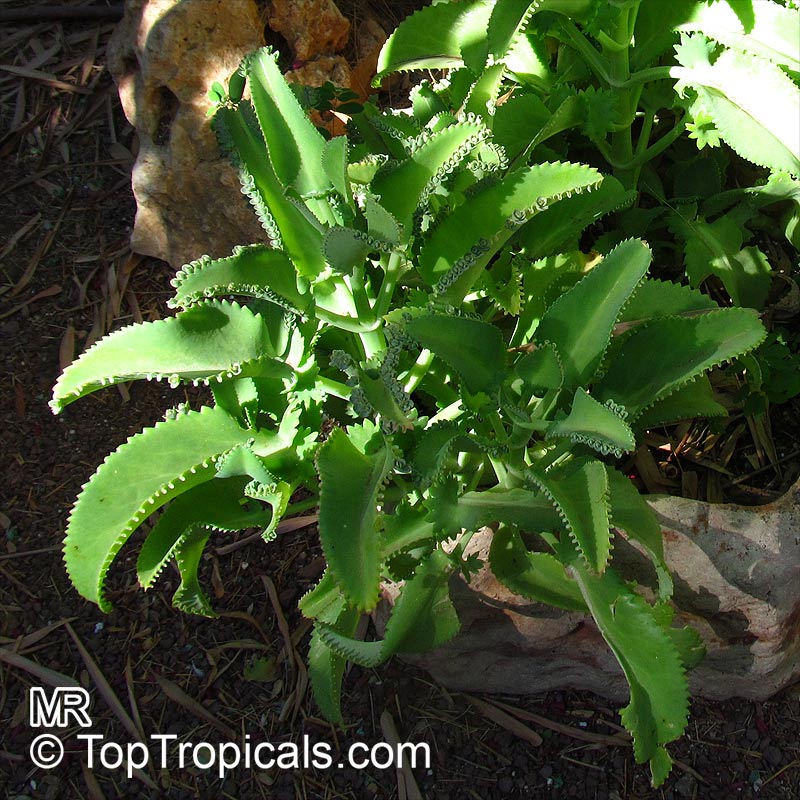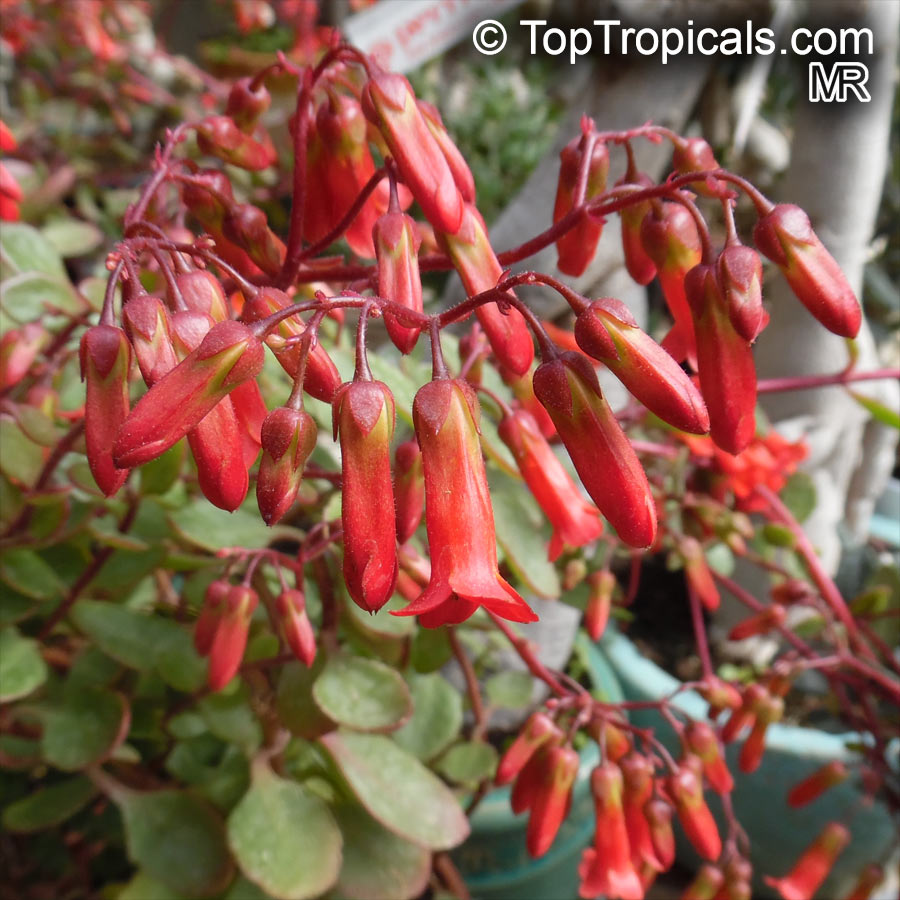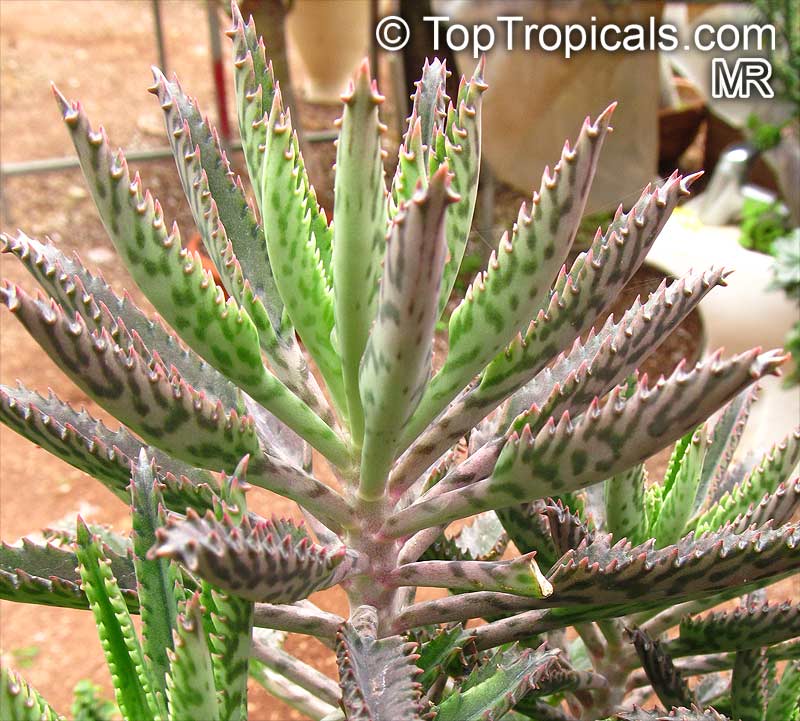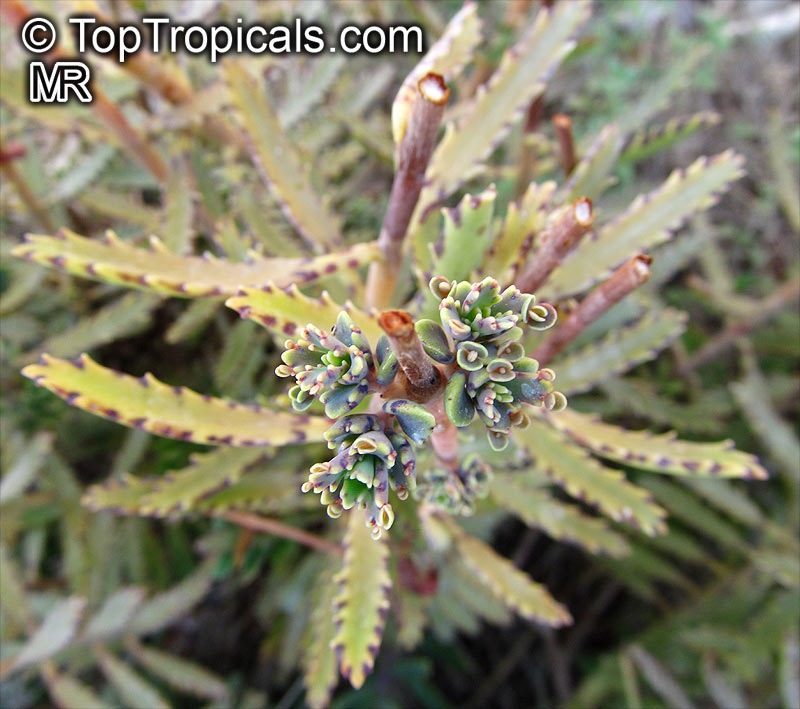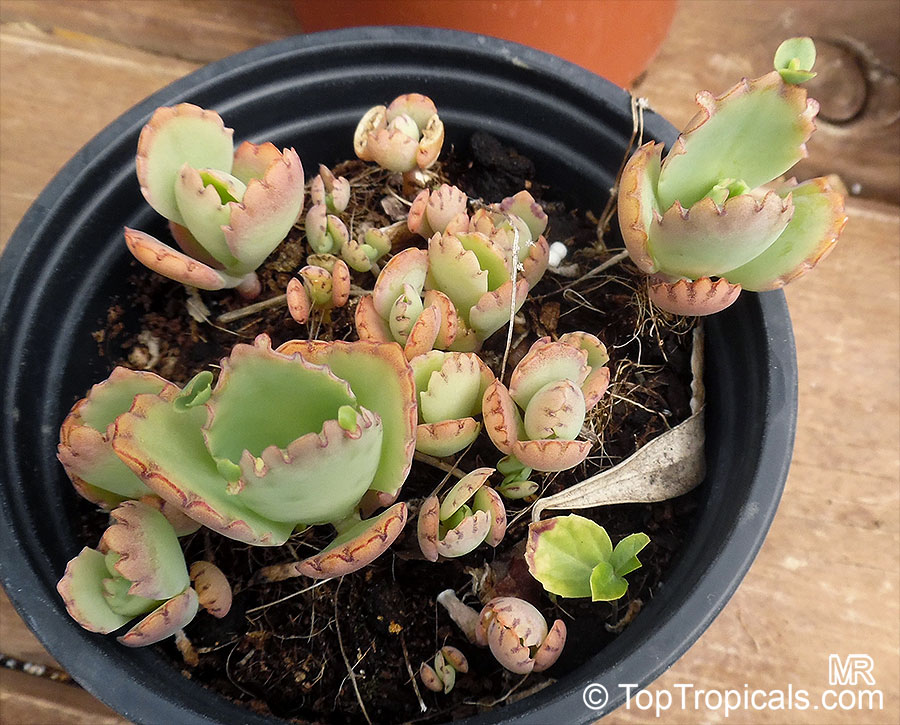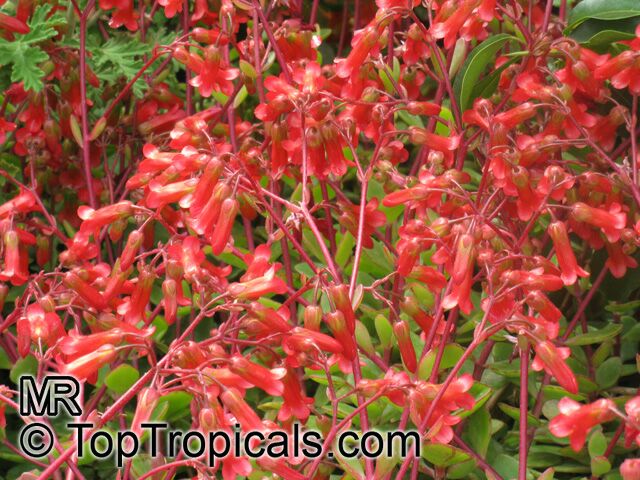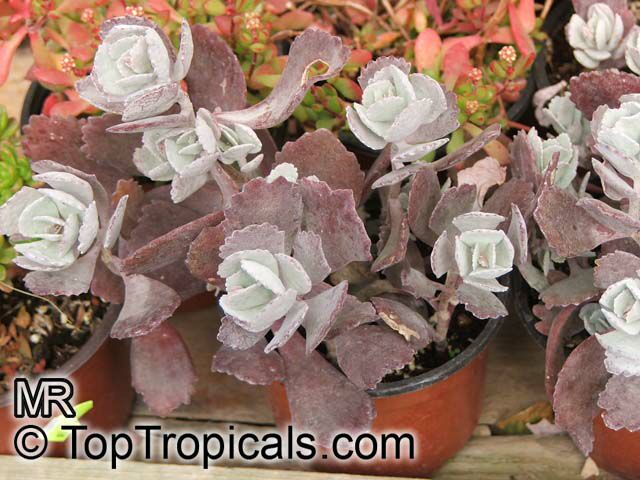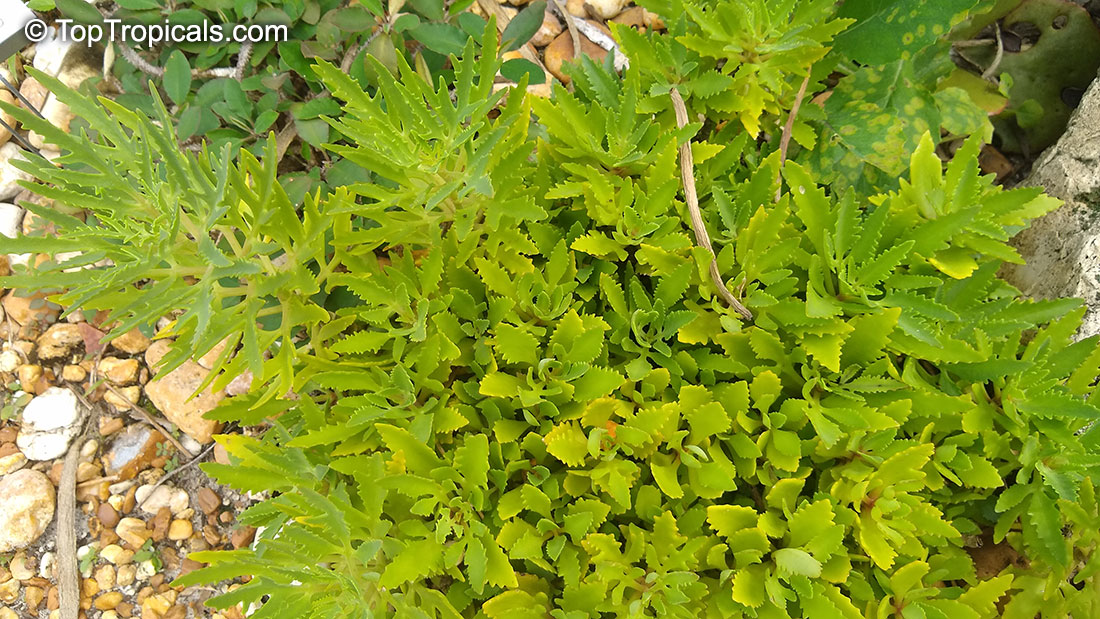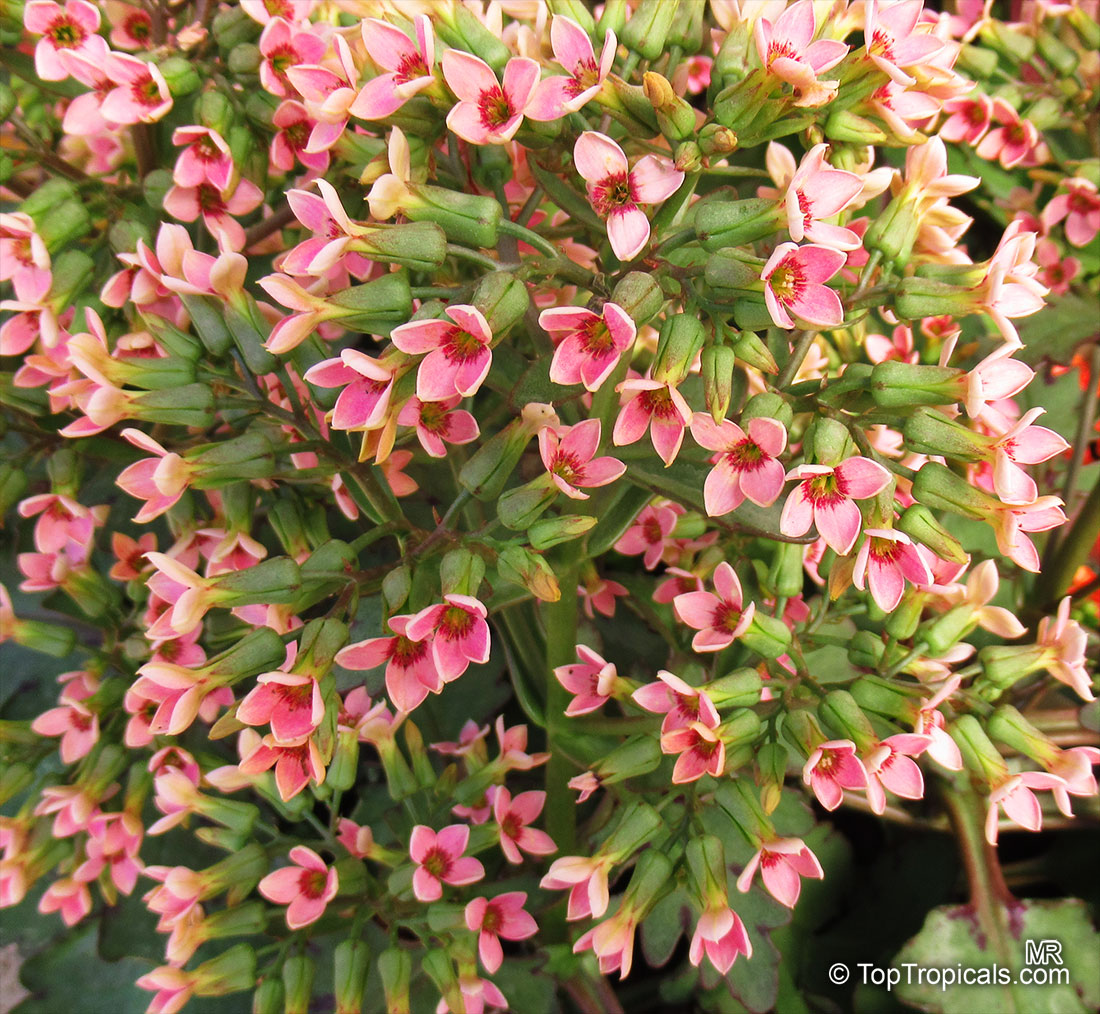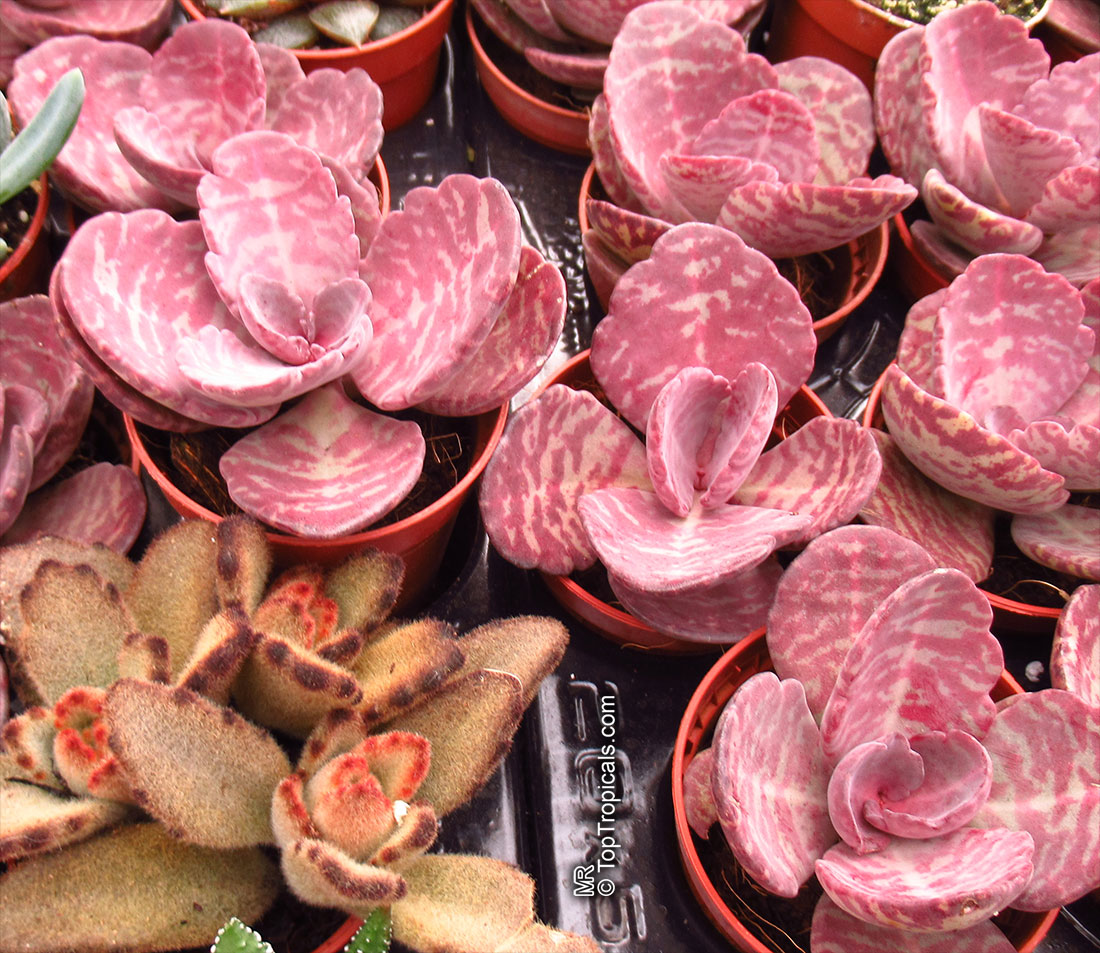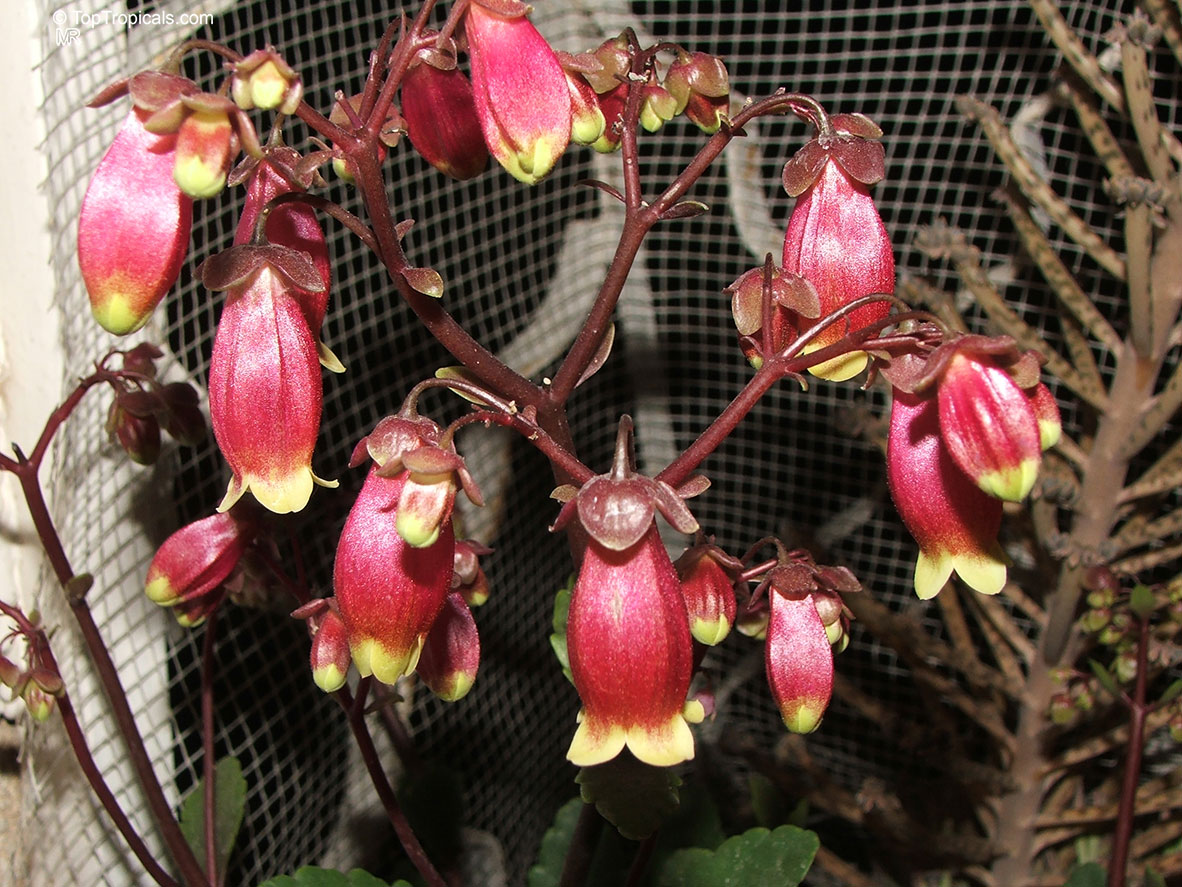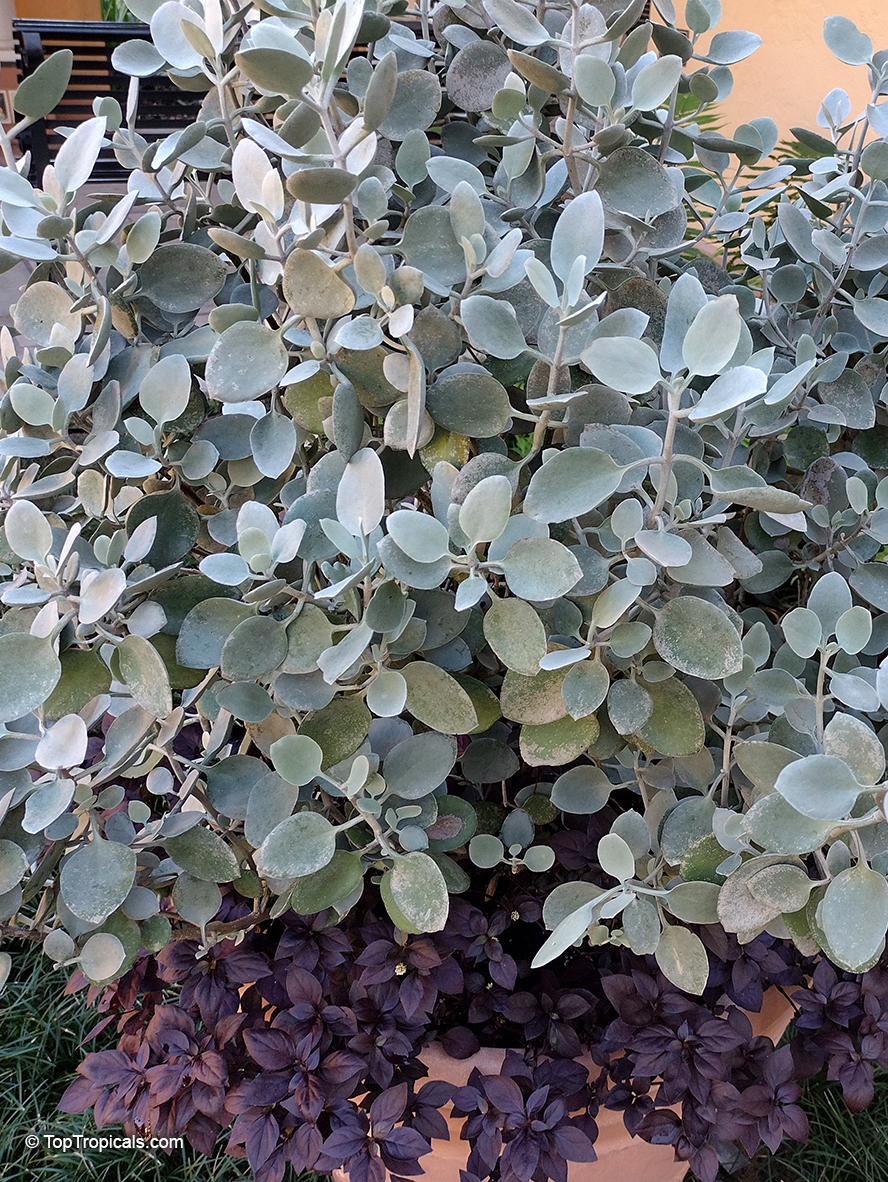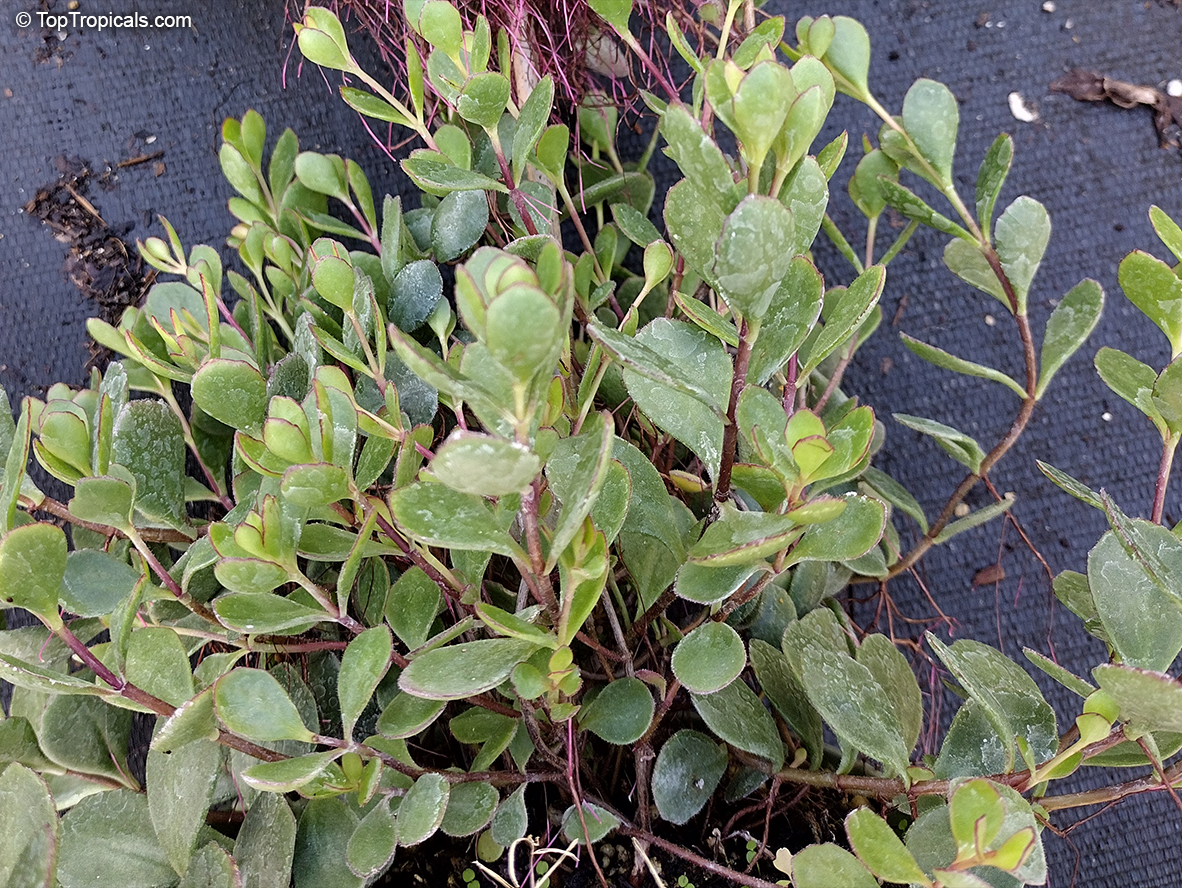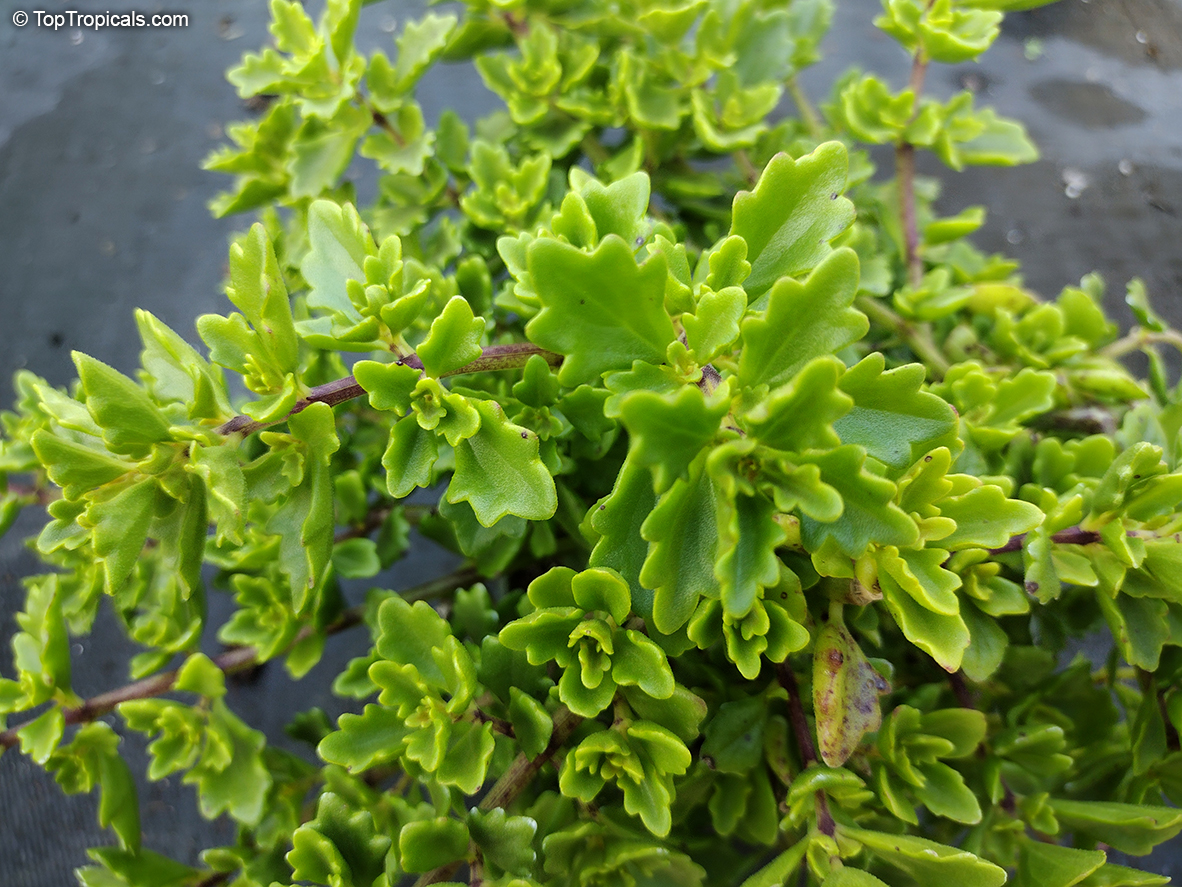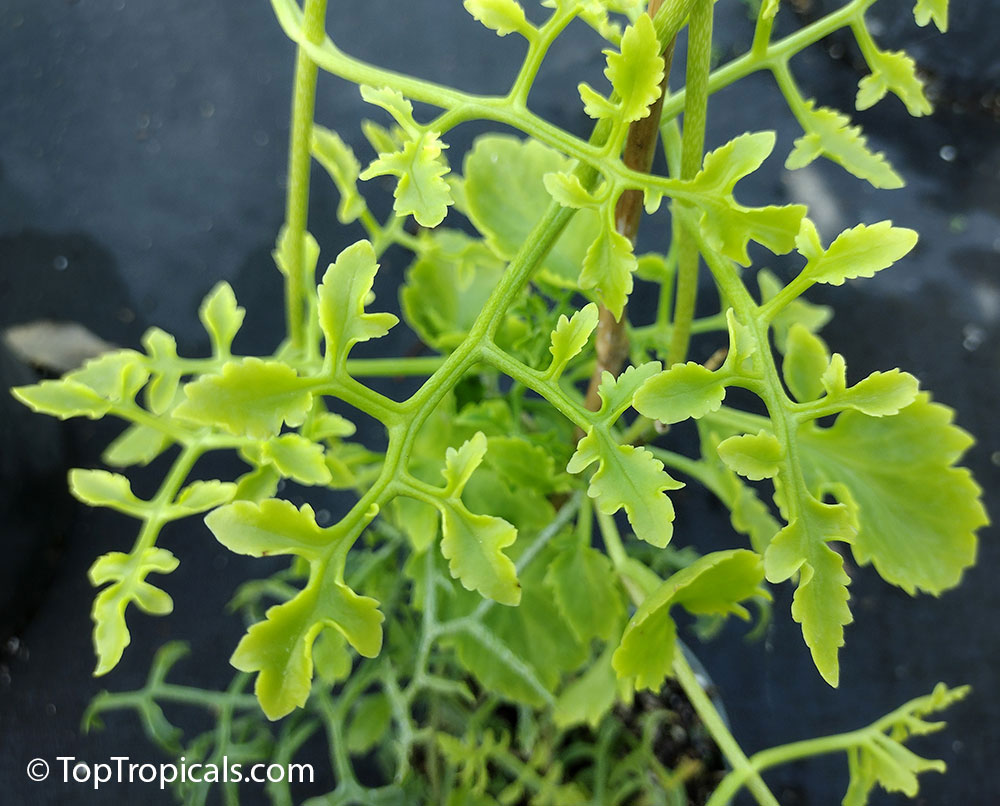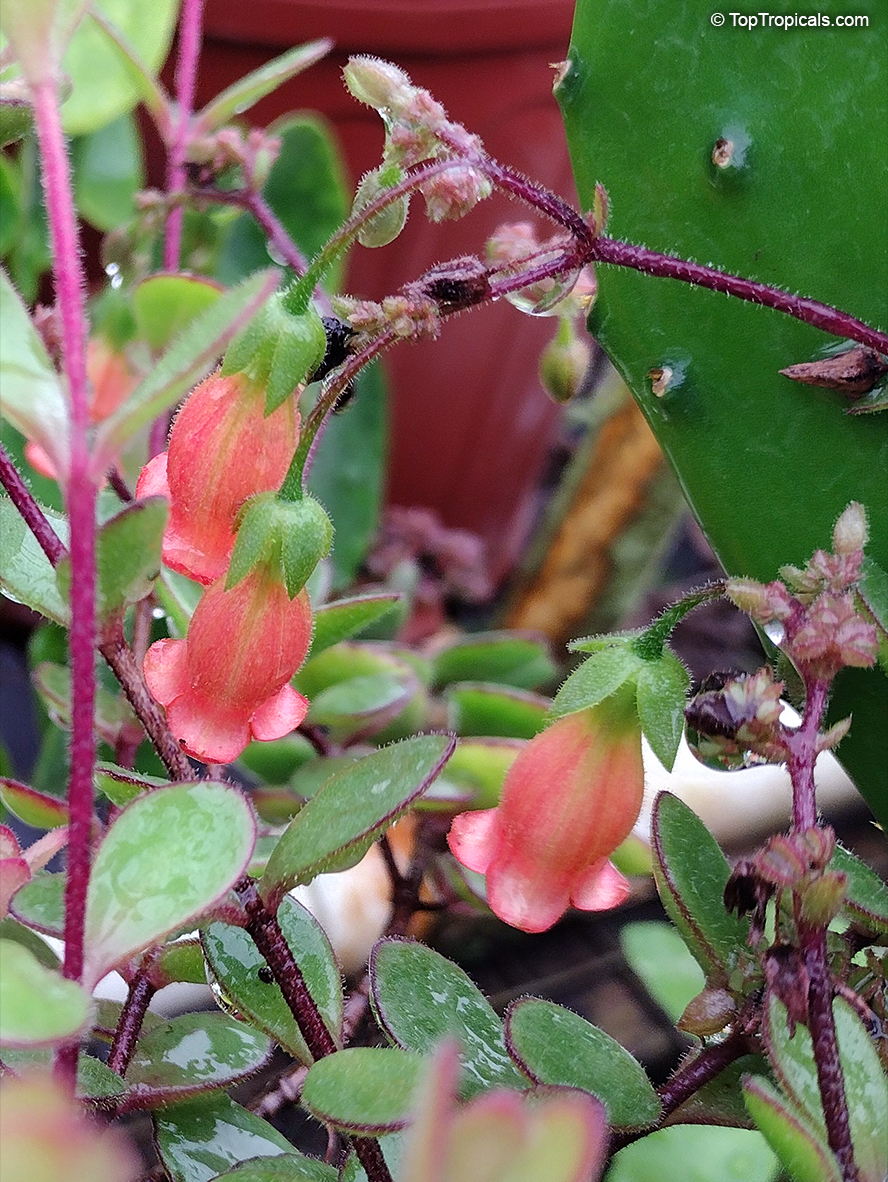Bryophyllum - Plant Encyclopedia Results
Top Tropicals Plant Encyclopedia
| Number of plants found: 10 |
Botanical names: Bryophyllum beauverdii, Kalanchoe beauverdii
Common name: Kalanchoe
Family: Crassulaceae
Origin: Madagascar






Bryophyllum beauverdii, more commonly known as Kalanchoe, is a vine native to Madagascar. It is a small plant, usually growing no more than 2-5 feet tall. Its leaves are up to 2 inches long, and have unique black-violet color. While the plant prefers full sun, it is also able to thrive in semi-shade and requires moderate to occasional watering. It is a hardy plant and can be grown outdoors in USDA Zones 9-11.
Kalanchoes are great for garden beds as both a ground cover and a climber. Its unique leaves and flowers will add color and interest to your garden. As an indoor houseplant, Kalanchoe is one of the best gifts for gardeners, being easy to care for and long-lasting.
When planting Kalanchoe outdoors, ensure it is in well-drained soil in a sunny area. The plant prefers soil with a slightly low acidity. Water regularly but don't overwater - allowing the soil to dry out between watering can help prevent root rot. Mulching helps to provide the plant with a more consistent temperature, as well as retaining moisture in the soil.
For those living in colder regions, Kalanchoe can be grown in pots and stored in a cool, dry place during winter. During the colder months, water only occasionally, and avoid too much direct sunlight, as the strong sun can damage foliage.
Overall, Kalanchoe is a beautiful, vibrant plant with plenty of color to add to your outdoor and indoor garden. With regular care, you can enjoy its unique leaves and flowers for many years to come.
Botanical names: Bryophyllum daigremontianum, Kalanchoe crenato-daigremontiana, Kalanchoe daigremontiana
Common names: Mother of Thousands, Mother of Millions, Devils Backbone, Mexican Hat Plant
Family: Crassulaceae
Hardiness: 30°F











Bryophyllum daigremontianum (Mother of Thousands) is a small shrub grown in USDA Zones 9-11 that grows 2 to 5 feet tall and makes an excellent ornamental foliage and flowers in landscape. This succulent African native enjoys a warm climate but can survive dry conditions and the salt of the seaside. Growing in full sun or partial shade and receiving adequate rainfall, this evergreen plant displays showy flowers in shades of pink, red and crimson.
To care for your Mother of Thousands succulent, place in a sunny location with good air circulation in a well draining soil. Keep it moist during the spring and summer months, allowing the top few inches of soil to dry slightly between waterings, and reduce watering during the winter months. Adding a little bit of fertilizer in the summer months will ensure your Bryophyllum daigremontianum produces healthy leaves and flowers.
If you'd like to grow Mother of Thousands in cold regions, you can create a suitable environment in a container and bring it inside during the winter. When potted, use cactus soil or a soil made of equal parts of sand, peat moss, and potting soil, and use a container with drainage holes. While it is better to keep it in a warm spot, it can survive cooler temperatures, such as a garage or a cool basement, if you allow some direct sunlight. Additionally, you can use a grow light to ensure your Bryophyllum daigremontianum gets the light it needs. Make sure to keep it moist, but not too wet, and repot as needed.
Mother of Thousands is not only an ornamental plant, but it serves as a traditional medicine plant with ethnomedical properties. Its sap can be quite irritating, so be sure you wear gloves when handling it. In conclusion, this attractive succulent is a great and easy-to-grow addition to your garden or container, and its drought tolerance makes it a valuable part of coastal, low-water gardens.
Botanical names: Bryophyllum delagoense, Kalanchoe delagoensis, Kalanchoe tubiflora, Bryophyllum tubiflorum, Bryophyllum verticillatum
Common name: Chandelier plant
Family: Crassulaceae
Origin: Tropical and South Africa






Very prolific round tubular leaves forming plantlets on the ends that quickly start new plants if they fall to the ground. This plant needs a rather dry atmosphere and complete exposure to sunlight. Throughout the summer, the soil should be kept moist, but in the winter, very little water is needed.
Botanical names: Bryophyllum fedtchenkoi, Kalanchoe fedtschenkoi
Common name: Kalanchoe
Family: Crassulaceae
Origin: Madagascar






Bryophyllum fedtchenkoi, otherwise known as Kalanchoe, is a small plant native to Madagascar that can grow 2-5 feet in height. It is an extremely ornamental species, containing leaves of bluish-green hue with brown margins that can take on a pink hue when exposed to a sufficient amount of full sun. These foliage-rich plants are hardy in USDA Zones 9-11, and are typically seen in seaside climates due to their salt tolerance.
The flowers of Bryophyllum fedtchenkoi are vinous in colour, ranging from a deep red to a crimson hue, with their inflorescence reaching 12" tall. The blooms are incredibly attractive, making it a popular choice for gardeners.
Growing this bushy-branched specimen is easy - and it can be done in pots for those living in colder climates. When planting in pots, it is important to use a well-draining material, and avoid moist and waterlogged conditions for best results. Moderately watering about once a week during dry seasons, and keeping the plant in plenty of full sun should not pose too much of a challenge, and should allow the Kalanchoe to thrive.
Botanical names: Bryophyllum gastonis-bonnieri, Kalanchoe gastonis-bonnieri, Kalanchoe adolph-engleri, Bryophyllum adolph-engleri
Common names: Giant kalanchoe, Donkey Ears; Life Plant; Miracle Leaf; Sprouting Leaf; Sprout Leaf Plant; Leaf of Life; Good Luck Leaf, Tree Of Life
Family: Crassulaceae
Origin: Thailand








This rare variety brought from Thailand has large fleshy leaves 1-2 ft in length. Leaves and stems are covered with silvery coating. Flowers are very showy, red with orange-yellow or light yellow. When planted in groups, these plants make very unforgettable view, covered with flame-like flowers. Like other kalanchoes, leaflets form easily, they are fuzzy and silver. Easy to grow just from one leaf set on top of moist soil. Very fast growing, drought tolerant small shrub. Tolerates almost any conditions.
Recommended Fertilizer: SUNSHINE Robusta - Rapid Growth Booster
Botanical names: Bryophyllum pinnatum, Kalanchoe pinnata, Bryophyllum calycinum
Common names: Bahamas Breath Plant, Hawaiian Air Plant
Family: Crassulaceae
Origin: Bahamas








Native Hawaiian plant. Easy to grow just from one leaf set on top of moist soil. Very fast growing, drought tolerant small shrub. Tolerates almost any conditions. Spectacular bloomer! Other common names: Donkey Ears; Life Plant; Miracle Leaf; Sprouting Leaf; Sprout Leaf Plant; Leaf of Life; Resurrection Plant; Canterbury Bells; Cathedral Bells; Mexican Love Plant; Floppers; Good Luck Leaf; Tree Of Life; Hawaiian Air Leaf; Palm Beachbells. Bahamians call it Life Leaf or Ploppers. In the Bahamas it is mostly used for Asthma or shortness in breath.
Botanical names: Bryophyllum proliferum, Kalanchoe prolifera
Common name: Blooming Boxes
Family: Crassulaceae
Origin: Island of Madagascar




A very interesting giant specie, inch thick jointed stems are waxy, as are the opposite pairs of fleshy, succulent leaves. Terminal inflorescence of yellow flowers from dangling four-sided box-like bracts yields a multitude of plantlets. Propagation: Bulbils coming after the flowers, underground stolons.
Botanical names: Kalanchoe serrata, Bryophyllum serratum
Common name: Kalanchoe Magic Tower
Family: Crassulaceae
Hardiness: 30°F







Kalanchoe serrata, commonly known as Kalanchoe Magic Tower, is a tough little shrub with a lot of punch. This plant species can reach heights of 2-5 feet and will display an array of vibrant pink flowers from late spring through to autumn, making it an ornamental foliage in any garden. From midseason to late summer,Kalanchoe serrata produces red and crimson vinous flowers that add some depth and color to gardens.
Kalanchoe serrata is known to be a very easy plant to care for and is adaptable to a range of USDA hardiness zones from 9-11, so it can be found thriving in many parts of the USA. This succulent can tolerate both full sun and dry conditions, making it a low maintenance garden beauty. Even better, this magnificent specimen is also highly tolerant of salty wind and spray, making it a great seaside or coastal favorite.
A mature Kalanchoe serrata can handle hard frost, as is cold hardy to temperatures as low as 30sF. It can survive a short time in these colder regions, but should be properly protected with a warm layer of mulch or a thick layer of leaves. It may also benefit from being planted in containers or pots, and can then be brought indoors to overwinter. This will ensure the pot and root system keep warm and is better for the health of the plant.
All in all, Kalanchoe serrata may provide a cheerful addition to your garden and is worth the investment for its beautiful flowers and salt-tolerance. With minimal effort and proper plant care, this small shrub is sure to prosper!
Botanical names: Kalanchoe uniflora, Kalanchoe ambrensis, Bryophyllum uniflorum
Common name: Kalanchoe
Family: Crassulaceae
Origin: Madagascar





Kalanchoe uniflora is a small plant typically no more than two to five feet in height. Its native origins are in Madagascar, although it is now grown throughout the world. Its leaves are soft and fuzzy, covered in downy hairs. The foliage typically appears in shades of grey-green and it has the capacity to store water in its leaves, enabling it to survive semi-arid climates.
Kalanchoe uniflora is known for its attractive red and crimson flowers that appear in spring. It produces the vinous blooms en masse and is tolerant of both seaside and salt environments, making it a great option for coastal gardens and landscapes. This plant thrives in USDA Zones 9-11 and is quite adaptable to a variety of soil textures and drainage.
In colder regions and climates, this plant can be grown in pots as long as it is provided with adequate sunlight and protection from extreme temperatures. Water can be given in moderation during the spring and summer months and it should be allowed to dry out between waterings. Plant maintenance is easy and grooming can be done in the spring once flowering has ended. Pruning and trimming should be done with care as to not damage the foliage or disturb the blooming process.
Kalanchoe uniflora is a delightful and hardy plant, providing a pop of color with its stunning flowers. With minimal watering and care, this plant can bring beauty and vibrancy to any home, beachside or inland.
Botanical name: Kalanchoe sp.
Common name: Kalanchoe
Family: Crassulaceae











Members of Kalanchoe genus are characterized by opening their flowers by growing new cells on the inner surface of the petals to force them outwards, and on the outside of the petals to close them.
Bryophyllum is a plant genus of the Crassulaceae family that has sometimes been included within the genus Kalanchoe. The group is notable for vegetatively growing small plantlets on the fringes of the leaves; these eventually drop off and root.
Use link to repeat this search:
https://toptropicals.com/cgi-bin/garden_catalog/cat.cgi?find=Bryophyllum&search_op=and&keyword_op=and&language=e&number=10
&no_change_lang=1&user=tt&sale=1&first=0
